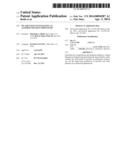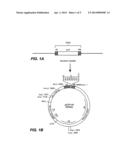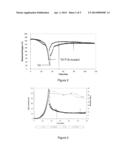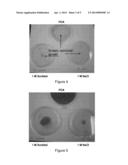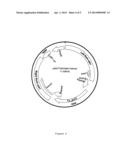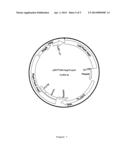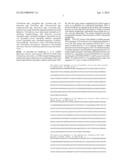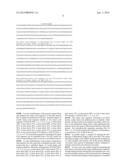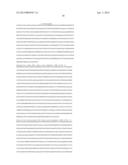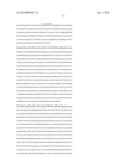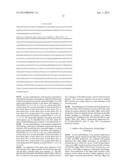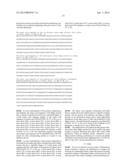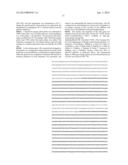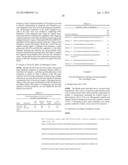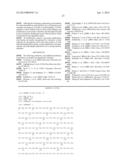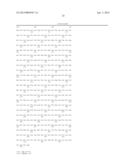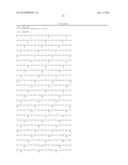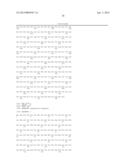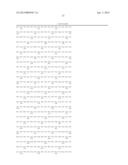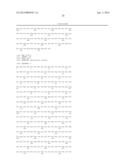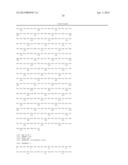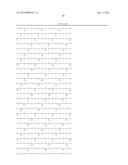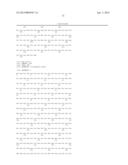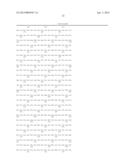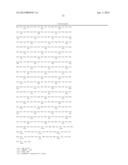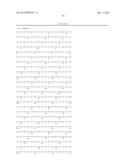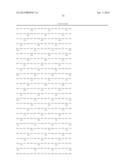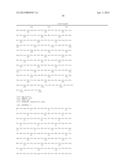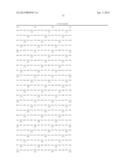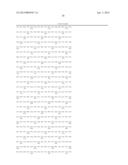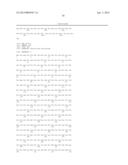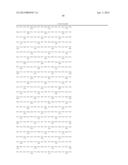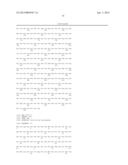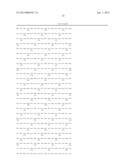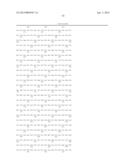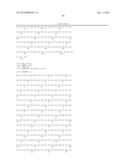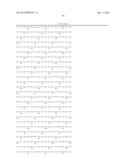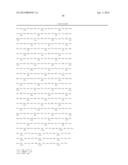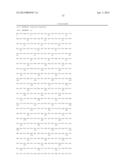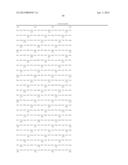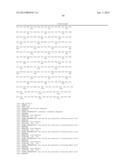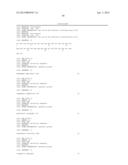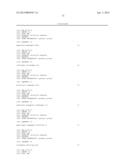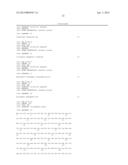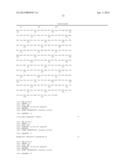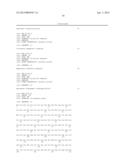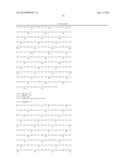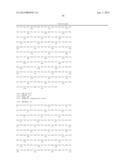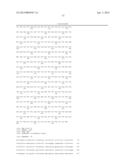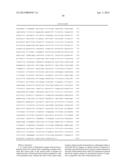Patent application title: FILAMENTOUS FUNGI HAVING AN ALTERED VISCOSITY PHENOTYPE
Inventors:
Elizabeth A. Bodie (San Carlos, CA, US)
Robert James Pratt, Ii (San Jose, CA, US)
Assignees:
DANISCO US INC.
IPC8 Class: AC12N1580FI
USPC Class:
530350
Class name: Chemistry: natural resins or derivatives; peptides or proteins; lignins or reaction products thereof proteins, i.e., more than 100 amino acid residues
Publication date: 2014-04-03
Patent application number: 20140094587
Abstract:
Described are compositions and methods relating to variant filamentous
fungi having altered growth characteristics. Such variants are
well-suited for growth in submerged cultures, e.g., for the large-scale
production of enzymes and other proteins for commercial applications.Claims:
1. A variant strain of filamentous fungus derived from a parental strain,
the variant strain comprising a genetic alteration that causes cells of
the variant strain to produce an altered amount of functional Seb1
protein compared to cells of the parental strain, wherein the cells of
the variant strain produce during aerobic fermentation in submerged
culture a cell broth that (i) requires an altered amount of agitation to
maintain a preselected dissolved oxygen content compared to the cells of
the parental strain, and/or (ii) maintains an altered dissolved oxygen
content at a preselected amount of agitation, compared to the cells of
the parental strain.
2. The variant strain of claim 1, wherein the altered amount of functional Seb1 protein is a reduced amount, and the variant strain produces during aerobic fermentation in submerged culture a cell broth that (i) requires reduced agitation to maintain a preselected dissolved oxygen content compared to the cells of the parental strain, and/or (ii) maintains an increased dissolved oxygen content at a preselected amount of agitation, compared to the cells of the parental strain.
3. The variant strain of claim 1, wherein the genetic alteration comprises a disruption of the seb1 gene present in the parental strain.
4. The variant strain of claim 3, wherein disruption of the seb1 gene is the result of deletion of all or part of the seb1 gene.
5. The variant strain of claim 3, wherein disruption of the seb1 gene is the result of deletion of a portion of genomic DNA comprising the seb1 gene.
6. The variant strain of claim 3, wherein disruption of the seb1 gene is the result of mutagenesis of the seb1 gene.
7. The variant strain of claim 3, wherein disruption of the seb1 gene is performed using site-specific recombination.
8. The variant strain of claim 3, wherein disruption of the seb1 gene is performed in combination with introducing a selectable marker at the genetic locus of the seb1 gene.
9. The variant strain of claim 1, wherein the variant strain does not produce functional Seb1 protein.
10. The variant strain of claim 1, wherein the variant strain does not produce Seb1 protein.
11. The variant strain of claim 1, wherein the variant strain further comprises a gene encoding a protein of interest.
12. The variant strain of claim 1, further comprising a disruption of the sfb3 gene.
13. The variant strain of claim 1, further comprising a disruption of at least one gene selected from the group consisting of the sfb3 gene, the mpg1 gene, the gas1 gene, the crz1 gene, and the tps2 gene.
14. The variant strain of claim 1, wherein the variant strain produces substantially the same amount of, or more, protein per unit amount of biomass as the parental strain.
15. The variant strain of claim 1, wherein the filamentous fungus is a Pezizomycotina species.
16. The variant strain of claim 1, wherein the filamentous fungus is a Trichoderma spp.
17. The variant strain of claim 1, wherein the filamentous fungus is Trichoderma reesei.
18. A method for producing a variant strain of filamentous fungus cells comprising: introducing a genetic alteration into a parental strain of filamentous fungal cell, which genetic alteration alters the production of functional Seb1 protein compared to the cells of the parental strain, thereby producing a variant filamentous fungal cell that produces during aerobic fermentation in submerged culture a cell broth that (i) requires an altered amount of agitation to maintain a preselected dissolved oxygen content, compared to the cells of the parental strain, and/or (ii) maintains an altered dissolved oxygen content at a preselected amount of agitation, compared to the cells of the parental strain.
19. The method of claim 18, wherein the genetic alteration reduces or prevents the production of functional Seb1 protein, thereby producing a variant filamentous fungal cell that produces during aerobic fermentation in submerged culture a cell broth that (i) requires reduced agitation to maintain a preselected dissolved oxygen content, compared to the cells of the parental strain, and/or (ii) maintains an increased dissolved oxygen content at a preselected amount of agitation, compared to the cells of the parental strain.
20. The method of claim 18, wherein the genetic alteration comprises disrupting the seb1 gene in a parental filamentous fungal cell using genetic manipulation.
21. The method of claim 18, wherein the genetic alteration comprises deleting the seb1 gene in a parental filamentous fungal cell using genetic manipulation.
22. The method of claim 18, wherein the genetic alteration is performed using site-specific genetic recombination.
23. The method of claim 18, wherein disruption of the seb1 gene is performed in combination with introducing a selectable marker at the genetic locus of the seb1 gene.
24. The method of claim 18, wherein disruption of the seb1 gene is performed in combination with disrupting the sfb3 gene.
25. The method of claim 18, wherein disruption of the seb1 gene is performed in combination with disruption of at least one gene selected from the group consisting of the sfb3 gene, the mpg1 gene, the gas1 gene, the crz1 gene, and the tps2 gene.
26. The method of claim 18, wherein the variant strain produces substantially the same amount of, or more, protein per unit amount of biomass as the parental strain.
27. The method of claim 18, wherein the filamentous fungus is a Pezizomycotina species.
28. The method of claim 18, wherein the filamentous fungus is a Trichoderma spp.
29. The method of claim 18, wherein the filamentous fungus is Trichoderma reesei.
30. The method of claim 18, wherein the parental strain further comprises a gene encoding a protein of interest.
31. The method of claim 30, wherein the gene encoding the protein of interest is present in the parental strain prior to introducing the genetic alteration that reduces or prevents the production of functional Seb1 protein.
32. A protein of interest produced by the variant strain of claim 11.
33. A variant strain of filamentous fungus produced by the method of claim 18.
34. A variant strain of filamentous fungus derived from a parental strain, the variant strain comprising: (a) a genetic alteration that results in (i) a requirement for reduced agitation in submerged culture to maintain a preselected dissolved oxygen content, compared to the cells of the parental strain, and/or (ii) maintenance of an increased dissolved oxygen content in submerged culture at a preselected amount of agitation, compared to the cells of the parental strain, and (b) a gene encoding a protein of interest, wherein the gene encoding the protein of interest is present in the variant strain prior to the genetic alteration in (a).
35. The variant strain of claim 34, wherein the genetic alteration comprises a disruption of the seb1 gene present in the parental strain.
36. The variant strain of claim 35, wherein disruption of the seb1 gene is performed in combination with introducing a selectable marker at the genetic locus of the seb1 gene.
37. The variant strain of claim 35, wherein disruption of the seb1 gene is performed in combination with disrupting at least one gene selected from the group consisting of the sfb3 gene, the mpg1 gene, the gas1 gene, the crz1 gene, and the tps2 gene.
38. The variant strain of claim 35, wherein disruption of the seb1 gene is performed in combination with disrupting the mpg1 gene.
Description:
PRIORITY
[0001] The present application claims priority to U.S. Provisional Application Ser. Nos. 61/478,160, 61/478,162, both filed on Apr. 22, 2011, which are hereby incorporated by reference in their entirety.
TECHNICAL FIELD
[0002] The present strains and methods relate to genetic mutations in filamentous fungi that give rise to strain variants having altered growth characteristics. Such variants are well-suited for growth in submerged cultures, e.g., for the large-scale production of enzymes and other proteins or metabolites for commercial applications.
BACKGROUND
[0003] Filamentous fungi are capable of expressing native and heterologous proteins to high levels, making them well-suited for the large-scale production of enzymes and other proteins for industrial, pharmaceutical, animal health and food and beverage applications. Filamentous fungi are typically grown in mycelial submerged cultures in bioreactors, which are adapted to introduce and distribute oxygen and nutrients into the culture medium (i.e., broth). The morphological characteristics of the mycelium affect the rheological properties of the broth, thereby affecting bioreactor performance.
[0004] Generally, the higher the viscosity of the broth, the less uniform the distribution of oxygen and nutrients and the more energy required to agitate the culture. In some cases, the viscosity of the broth becomes sufficiently high to significantly interfere with the dissolution of oxygen and nutrients, thereby adversely affecting the growth of the fungi. Additionally, the power required to mix and aerate viscous broth can significantly increase the cost of production, and incur higher capital expenditures in terms of motors and power supplies.
SUMMARY
[0005] Described are strains and methods relating to filamentous fungi having genetic alterations that give rise to altered viscosity phenotypes.
[0006] In one aspect, a variant strain of filamentous fungus derived from a parental strain is provided, the variant strain comprising a genetic alteration that causes cells of the variant strain to produce an altered amount of functional Seb1 protein compared to cells of the parental strain, wherein the cells of the variant strain are produced during aerobic fermentation in submerged culture cell broth that (i) requires an altered amount of agitation to maintain a preselected dissolved oxygen content compared to the cells of the parental strain, and/or (ii) maintains an altered dissolved oxygen content at a preselected amount of agitation, compared to the cells of the parental strain.
[0007] In some embodiments, the altered amount of functional Seb1 protein is a reduced amount, and the variant strain produces during aerobic fermentation in submerged culture a cell broth that (i) requires reduced agitation to maintain a preselected dissolved oxygen content compared to the cells of the parental strain, and/or (ii) maintains an increased dissolved oxygen content at a preselected amount of agitation, compared to the cells of the parental strain.
[0008] In some embodiments, the genetic alteration comprises a disruption of the seb1 gene present in the parental strain. In some embodiments, disruption of the seb1 gene is the result of deletion of all or part of the seb1 gene. In some embodiments, disruption of the seb1 gene is the result of deletion of a portion of genomic DNA comprising the seb1 gene. In some embodiments, disruption of the seb1 gene is the result of mutagenesis of the seb1 gene.
[0009] In some embodiments, disruption of the seb1 gene is performed using site-specific recombination. In some embodiments, disruption of the seb1 gene is performed in combination with introducing a selectable marker at the genetic locus of the seb1 gene.
[0010] In some embodiments, the variant strain does not produce functional Seb1 protein. In some embodiments, the variant strain does not produce Seb1 protein.
[0011] In some embodiments, the variant strain further comprises a gene encoding a protein of interest. In some embodiments, the variant strain further comprises a disruption of the sfb3 gene. In some embodiments, the variant strain further comprises a disruption of the mpg1 gene. In some embodiments, the variant strain further comprises a disruption of the sfb3 and mpg1 genes. In some embodiments, the variant strain further comprises a disruption of at least one gene selected from the group consisting of the sfb3 gene, the mpg1 gene, the gas1 gene, the crz1 gene, and the tps2 gene. In some embodiments, the variant strain produces substantially the same amount of, or more, protein per unit amount of biomass as the parental strain.
[0012] In some embodiments, the filamentous fungus is a Pezizomycotina species. In some embodiments, the filamentous fungus is a Trichoderma spp., Aspergillus spp., Fusarium spp., Scedosporium spp., Penicillium spp., Chrysosporium spp., Cephalosporium spp., Talaromyces spp., Geosmithia spp., and Neurospora spp. In some embodiments, the filamentous fungus can include, but is not limited to, Trichoderma reesei (previously classified as Trichoderma longibrachiatum and Hypocrea jecorina), Aspergillus niger, Aspergillus fumigatus, Aspergillus itaconicus, Aspergillus oryzae, Aspergillus nidulans, Aspergillus terreus, Aspergillus sojae, Aspergillus japonicus, Scedosporium prolificans, Neurospora crassa, Penicillium funiculosum, Penicillium chrysogenum, Talaromyces (Geosmithia) emersonii, Fusarium venenatum, and Chrysosporium lucknowense. In some embodiments, the filamentous fungus is Trichoderma reesei.
[0013] In another aspect, a method for producing a variant strain of filamentous fungus cells is provided, comprising: introducing a genetic alteration into a parental strain of filamentous fungal cell, which genetic alteration alters the production of functional Seb1 protein compared to the cells of the parental strain, thereby producing a variant filamentous fungal cell that produces during aerobic fermentation in submerged culture a cell broth that (i) requires an altered amount of agitation to maintain a preselected dissolved oxygen content, compared to the cells of the parental strain, and/or (ii) maintains an altered dissolved oxygen content at a preselected amount of agitation, compared to the cells of the parental strain.
[0014] In some embodiments, the genetic alteration reduces or prevents the production of functional Seb1 protein, thereby producing a variant filamentous fungal cell that produces during aerobic fermentation in submerged culture a cell broth that (i) requires reduced agitation to maintain a preselected dissolved oxygen content, compared to the cells of the parental strain, and/or (ii) maintains an increased dissolved oxygen content at a preselected amount of agitation, compared to the cells of the parental strain.
[0015] In some embodiments, the genetic alteration comprises disrupting the seb1 gene in a parental filamentous fungal cell using genetic manipulation. In some embodiments, the genetic alteration comprises deleting the seb1 gene in a parental filamentous fungal cell using genetic manipulation. In some embodiments, the genetic alteration is performed using site-specific genetic recombination.
[0016] In some embodiments, disruption of the seb1 gene is performed in combination with introducing a selectable marker at the genetic locus of the seb1 gene. In some embodiments, the variant strain produces substantially the same amount of, or more, protein per unit amount of biomass as the parental strain. In some embodiments, disruption of the seb1 gene is performed in combination with disrupting the sfb3 gene. In some embodiments, disruption of the seb1 gene is performed in combination with disrupting the mpg1 gene. In some embodiments, disruption of the seb1 gene is performed in combination with disrupting at least one gene selected from the group consisting of the sfb3 gene, the mpg1 gene, the gas1 gene, the crz1 gene, and the tps2 gene.
[0017] In some embodiments, the variant strain produces substantially the same amount of, or more, protein per unit amount of biomass as the parental strain.
[0018] In some embodiments, the filamentous fungus is a Pezizomycotina species. In some embodiments, the filamentous fungus is a Trichoderma spp., Aspergillus spp., Fusarium spp., Scedosporium spp., Penicillium spp., Chrysosporium spp., Cephalosporium spp., Talaromyces spp., Geosmithia spp., and Neurospora spp. In some embodiments, the filamentous fungus can include, but is not limited to, Trichoderma reesei (previously classified as Trichoderma longibrachiatum and Hypocrea jecorina), Aspergillus niger, Aspergillus fumigatus, Aspergillus itaconicus, Aspergillus oryzae, Aspergillus nidulans, Aspergillus terreus, Aspergillus sojae, Aspergillus japonicus, Scedosporium prolificans, Neurospora crassa, Penicillium funiculosum, Penicillium chrysogenum, Talaromyces (Geosmithia) emersonii, Fusarium venenatum, and Chrysosporium lucknowense. In some embodiments, the filamentous fungus is Trichoderma reesei.
[0019] In some embodiments, the parental strain further comprises a gene encoding a protein of interest. In some embodiments, the gene encoding the protein of interest is present in the parental strain prior to introducing the genetic alteration that reduces or prevents the production of functional Seb1 protein. In some embodiments the protein of interest within the parental strain is encoded by an endogenous gene or a heterologous gene.
[0020] In another aspect, a protein of interest produced by any of the aforementioned variant strains is provided.
[0021] In yet another aspect, a filamentous fungus produced by any of the aforementioned methods and having any of the aforementioned properties is provided.
[0022] In another aspect, a variant strain of filamentous fungus derived from a parental strain is provided, the variant strain comprising: (a) a genetic alteration that results in (i) a requirement for reduced agitation in submerged culture to maintain a preselected dissolved oxygen content, compared to the cells of the parental strain, and/or (ii) maintenance of an increased dissolved oxygen content in submerged culture at a preselected amount of agitation, compared to the cells of the parental strain, and (b) a gene encoding a protein of interest, wherein the gene encoding the protein of interest is present in the variant strain prior to the genetic alteration in (a).
[0023] In some embodiments, the genetic alteration of the resulting variant strain comprises a disruption of the seb1 gene present in the parental strain. In some embodiments, disruption of the seb1 gene is performed in combination with introducing a selectable marker at the genetic locus of the seb1 gene. In some embodiments, disruption of the seb1 gene is performed in combination with disrupting the sfb3 gene. In some embodiments, disruption of the seb1 gene is performed in combination with disrupting the mpg1 gene. In some embodiments, disruption of the seb1 gene is performed in combination with disrupting at least one gene selected from the group consisting of the sfb3 gene, the mpg1 gene, the gas1 gene, the crz1 gene, and the tps2 gene.
[0024] These and other aspects and embodiments of present variant strains and methods will be apparent from the description, including the accompanying Figures.
BRIEF DESCRIPTION OF THE DRAWINGS
[0025] FIG. 1A shows a schematic representing the T-DNA containing the pyr4 gene.
[0026] FIG. 1B is a map of the Agrobacterium tumefaciens PZP 100 vector.
[0027] FIG. 2 is graph comparing the dissolved oxygen levels during growth of T4 T-DNA mutant F16 and the T4 parent in a 14 L fermentor.
[0028] FIG. 3 is graph comparing the growth rate of T4 T-DNA mutant F16 and the T4 parent in a 14 L fermentor.
[0029] FIGS. 4 and 5 are images of the T4 Δseb1 F16 strain (FIG. 4) and the Morph strain (FIG. 5) after growth on PDA, sorbitol, and NaCl plates. The T4 seb1 F16 mutant shows restricted growth and osmosensitivity compared to the Morph control.
[0030] FIG. 6 is a map of the seb1 disruption vector.
[0031] FIG. 7 is a map of the mpg1 disruption vector.
DETAILED DESCRIPTION
I. Overview
[0032] The present strains and methods relate to variant strains of filamentous fungus cells having genetic modifications that affect their morphology and growth characteristics. When the variant cells are grown in submerged culture, they produce a cell broth that has different rheological properties compared to a cell broth comprising cells of the parental strain. Some of these variant strains are well-suited for the large-scale production of enzymes and other commercially important proteins.
II. Definitions
[0033] Prior to describing the present strains and methods in detail, the following terms are defined for clarity. Terms not defined should be accorded their ordinary meanings as used in the relevant art.
[0034] As used herein, "Trichoderma reesei" refers to a filamentous fungus of the phylum Ascomycota, subphylum Pezizomycotina. This organism was previously classified as Trichoderma longibrachiatum, and also as Hypocrea jecorina.
[0035] As used herein, the phrase "variant strain of filamentous fungus cells," or similar phrases, refer to strains of filamentous fungus cells that are derived (i.e., obtained from or obtainable from) from a parental (or reference) strain belonging to the Pezizomycotina, e.g., by genetic manipulation. In the present description, parental and variant strains can be described as having certain characteristics, such as genetic modifications, expression phenotypes, morphology, and the like; however, the skilled person will appreciate that it is technically the cells of the parental or variant strain that have such characteristics, and "the strains" are referred to for convenience.
[0036] As used herein, the term "protein of interest" refers to a polypeptide that is desired to be expressed in a filamentous fungus. Such a protein can be an enzyme, a substrate-binding protein, a surface-active protein, a structural protein, or the like, and can be expressed at high levels, and can be for the purpose of commercialization. The protein of interest can be encoded by an endogenous gene or a heterologous gene relative to the variant strain and/or the parental strain. The protein of interest can be expressed intracellularly or as a secreted protein.
[0037] As used herein, the phrase "substantially free of an activity," or similar phrases, means that a specified activity is either undetectable in an admixture or present in an amount that would not interfere with the intended purpose of the admixture.
[0038] As used herein, the terms "polypeptide" and "protein" (and/or their respective plural forms) are used interchangeably to refer to polymers of any length comprising amino acid residues linked by peptide bonds. The conventional one-letter or three-letter codes for amino acid residues are used herein. The polymer can be linear or branched, it can comprise modified amino acids, and it can be interrupted by non-amino acids. The terms also encompass an amino acid polymer that has been modified naturally or by intervention; for example, disulfide bond formation, glycosylation, lipidation, acetylation, phosphorylation, or any other manipulation or modification, such as conjugation with a labeling component. Also included within the definition are, for example, polypeptides containing one or more analogs of an amino acid (including, for example, unnatural amino acids, etc.), as well as other modifications known in the art.
[0039] As used herein, functionally and/or structurally similar proteins are considered to be "related proteins." Such proteins can be derived from organisms of different genera and/or species, or even different classes of organisms (e.g., bacteria and fungi). Related proteins also encompass homologs determined by primary sequence analysis, determined by secondary or tertiary structure analysis, or determined by immunological cross-reactivity.
[0040] As used herein, the term "derivative polypeptide/protein" refers to a protein which is derived or derivable from a protein by addition of one or more amino acids to either or both the N- and C-terminal end(s), substitution of one or more amino acids at one or a number of different sites in the amino acid sequence, deletion of one or more amino acids at either or both ends of the protein or at one or more sites in the amino acid sequence, and/or insertion of one or more amino acids at one or more sites in the amino acid sequence. The preparation of a protein derivative can be achieved by modifying a DNA sequence which encodes for the native protein, transformation of that DNA sequence into a suitable host, and expression of the modified DNA sequence to form the derivative protein.
[0041] Related (and derivative) proteins include "variant proteins." Variant proteins differ from a reference/parental protein (e.g., a wild-type protein) by substitutions, deletions, and/or insertions at a small number of amino acid residues. The number of differing amino acid residues between the variant and parental protein can be one or more, for example, 1, 2, 3, 4, 5, 6, 7, 8, 9, 10, 15, 20, 30, 40, 50, or more amino acid residues. Variant proteins can share at least about 70%, at least about 75%, at least about 80%, at least about 85%, at least about 90%, at least about 91%, at least about 92%, at least about 93%, at least about 94%, at least about 95%, at least about 96%, at least about 97%, at least about 98%, or even at least about 99%, or more, amino acid sequence identity with a reference protein. A variant protein can also differ from a reference protein in selected motifs, domains, epitopes, conserved regions, and the like.
[0042] As used herein, the term "analogous sequence" refers to a sequence within a protein that provides similar function, tertiary structure, and/or conserved residues as the protein of interest (i.e., typically the original protein of interest). For example, in epitope regions that contain an α-helix or a β-sheet structure, the replacement amino acids in the analogous sequence preferably maintain the same specific structure. The term also refers to nucleotide sequences, as well as amino acid sequences. In some embodiments, analogous sequences are developed such that the replacement amino acids result in a variant enzyme showing a similar or improved function. In some embodiments, the tertiary structure and/or conserved residues of the amino acids in the protein of interest are located at or near the segment or fragment of interest. Thus, where the segment or fragment of interest contains, for example, an α-helix or a β-sheet structure, the replacement amino acids preferably maintain that specific structure.
[0043] As used herein, the term "homologous protein" refers to a protein that has similar activity and/or structure to a reference protein. It is not intended that homologs necessarily be evolutionarily related. Thus, it is intended that the term encompass the same, similar, or corresponding enzyme(s) (i.e., in terms of structure and function) obtained from different organisms. In some embodiments, it is desirable to identify a homolog that has a quaternary, tertiary and/or primary structure similar to the reference protein. In some embodiments, homologous proteins induce similar immunological response(s) as a reference protein. In some embodiments, homologous proteins are engineered to produce enzymes with desired activity(ies).
[0044] The degree of homology between sequences can be determined using any suitable method known in the art (see, e.g., Smith and Waterman (1981) Adv. Appl. Math. 2:482; Needleman and Wunsch (1970) J. Mol. Biol., 48:443; Pearson and Lipman (1988) Proc. Natl. Acad. Sci. USA 85:2444; programs such as GAP, BESTFIT, FASTA, and TFASTA in the Wisconsin Genetics Software Package (Genetics Computer Group, Madison, Wis.); and Devereux et al. (1984) Nucleic Acids Res. 12:387-95).
[0045] For example, PILEUP is a useful program to determine sequence homology levels. PILEUP creates a multiple sequence alignment from a group of related sequences using progressive, pair-wise alignments. It can also plot a tree showing the clustering relationships used to create the alignment. PILEUP uses a simplification of the progressive alignment method of Feng and Doolittle, (Feng and Doolittle (1987) J. Mol. Evol. 35:351-60). The method is similar to that described by Higgins and Sharp ((1989) CABIOS 5:151-53). Useful PILEUP parameters including a default gap weight of 3.00, a default gap length weight of 0.10, and weighted end gaps. Another example of a useful algorithm is the BLAST algorithm, described by Altschul et al. ((1990) J. Mol. Biol. 215:403-10) and Karlin et al. ((1993) Proc. Natl. Acad. Sci. USA 90:5873-87). One particularly useful BLAST program is the WU-BLAST-2 program (see, e.g., Altschul et al. (1996) Meth. Enzymol. 266:460-80). Parameters "W," "T," and "X" determine the sensitivity and speed of the alignment. The BLAST program uses as defaults a word-length (W) of 11, the BLOSUM62 scoring matrix (see, e.g., Henikoff and Henikoff (1989) Proc. Natl. Acad. Sci. USA 89:10915) alignments (B) of 50, expectation (E) of 10, M'S, N'-4, and a comparison of both strands.
[0046] As used herein, the phrases "substantially similar" and "substantially identical," in the context of at least two nucleic acids or polypeptides, typically means that a polynucleotide or polypeptide comprises a sequence that has at least about 70% identity, at least about 75% identity, at least about 80% identity, at least about 85% identity, at least about 90% identity, at least about 91% identity, at least about 92% identity, at least about 93% identity, at least about 94% identity, at least about 95% identity, at least about 96% identity, at least about 97% identity, at least about 98% identity, or even at least about 99% identity, or more, compared to the reference (i.e., wild-type) sequence. Sequence identity can be determined using known programs such as BLAST, ALIGN, and CLUSTAL using standard parameters. (See, e.g., Altschul, et al. (1990) J. Mol. Biol. 215:403-410; Henikoff et al. (1989) Proc. Natl. Acad. Sci. USA 89:10915; Karin et al. (1993) Proc. Natl. Acad. Sci USA 90:5873; and Higgins et al. (1988) Gene 73:237-244). Software for performing BLAST analyses is publicly available through the National Center for Biotechnology Information. Also, databases can be searched using FASTA (Pearson et al. (1988) Proc. Natl. Acad. Sci. USA 85:2444-48). One indication that two polypeptides are substantially identical is that the first polypeptide is immunologically cross-reactive with the second polypeptide. Typically, polypeptides that differ by conservative amino acid substitutions are immunologically cross-reactive. Thus, a polypeptide is substantially identical to a second polypeptide, for example, where the two peptides differ only by a conservative substitution. Another indication that two nucleic acid sequences are substantially identical is that the two molecules hybridize to each other under stringent conditions (e.g., within a range of medium to high stringency).
[0047] As used herein, the term "gene" is synonymous with the term "allele" in referring to a nucleic acid that encodes and directs the expression of a protein or RNA. Vegetative forms of filamentous fungi are generally haploid, therefore a single copy of a specified gene (i.e., a single allele) is sufficient to confer a specified phenotype.
[0048] As used herein, the terms "wild-type" and "native" are used interchangeably and refer to genes proteins or strains found in nature.
[0049] As used herein, "deletion of a gene," refers to its removal from the genome of a host cell. Where a gene includes control elements (e.g., enhancer elements) that are not located immediately adjacent to the coding sequence of a gene, deletion of a gene refers to the deletion of the coding sequence, and optionally adjacent enhancer elements, including but not limited to, for example, promoter and/or terminator sequences.
[0050] As used herein, "disruption of a gene" refers broadly to any genetic or chemical manipulation, i.e., mutation, that substantially prevents a cell from producing a function gene product, e.g., a protein, in a host cell. Exemplary methods of disruption include complete or partial deletion of any portion of a gene, including a polypeptide-coding sequence, a promoter, an enhancer, or another regulatory element, or mutagenesis of the same, where mutagenesis encompasses substitutions, insertions, deletions, inversions, and combinations and variations, thereof, any of which mutations substantially prevent the production of a function gene product. A gene can also be disrupted using RNAi, antisense, or any other method that abolishes gene expression.
[0051] As used herein, the terms "genetic manipulation" and "genetic alteration" are used interchangeably and refer to the alteration/change of a nucleic acid sequence. The alteration can included but is not limited to a substitution, deletion, insertion or chemical modification of at least one nucleic acid in the nucleic acid sequence.
[0052] As used herein, "aerobic fermentation" refers to growth in the presence of oxygen.
[0053] As used herein, the term "cell broth" refers collectively to medium and cells in a liquid/submerged culture.
[0054] As used herein, the term "cell mass" refers to the cell component (including intact and lysed cells) present in a liquid/submerged culture. Cell mass can be expressed in dry or wet weight.
[0055] As used herein, the term "rheology" refers to a branch of physics dealing with the deformation and flow of matter.
[0056] As used herein, "viscosity" is a measure of the resistance of a fluid to deformation by mechanical stress, such as shear stress or tensile stress. In the present context, viscosity can also refer to the resistance of a cell broth comprising filamentous fungus cells to mechanical stress, e.g., as provided by a rotor/impeller. Because the viscosity of a cell broth can be difficult to measure directly, indirect measurements of viscosity can be used, such as the dissolved oxygen content of the culture broth at a preselected amount of agitation, the amount of agitation required to maintain a preselected dissolved oxygen content, the amount of power required to agitate a cell broth to maintain a preselected dissolved oxygen content, or even colony morphology on solid medium.
[0057] As used herein, an "altered-viscosity" variant strain of filamentous fungus cells refers to a variant strain that produces a cell broth that has either a reduced or increased viscosity (i.e., reduced or increased resistance to shear or tensile stress) compared to an equivalent cell broth produced by a parental strain. Generally, equivalent cell broths have comparable cell masses. Preferably, the difference between a variant, altered viscosity strain and a parental strain, with respect to any direct or indirect measure of viscosity, is at least 10%, at least 15%, at least 20%, at least 25%, at least 30%, at least 35%, at least 40%, at least 45%, or even at least 50%, or more. Methods for comparing the viscosity of filamentous fungus cell broths are described, herein. Generally, comparable (or equivalent) cell broths have comparable cell masses.
[0058] As used herein, a "reduced-viscosity" variant strain of filamentous fungus cells refers to a variant strain that produces a cell broth that has reduced viscosity (i.e., reduced resistance to shear or tensile stress) compared to an equivalent cell broth produced by a parental strain. Preferably, the difference between a variant, altered viscosity strain and a parental strain, with respect to any direct or indirect measure of viscosity, is at least 10%, at least 15%, at least 20%, at least 25%, at least 30%, at least 35%, at least 40%, at least 45%, or even at least 50%, or more.
[0059] As used herein, "dissolved oxygen" (DO) refers to the amount of oxygen (O2) present in a liquid medium as measured in vol/vol units. The dissolved oxygen level can be maintained at a high level, e.g., between 170-100% and 20%, between 100-80% and 20%, between 70% and 20%, between 65% and 20%, between 60% and 20%, between 55% and 20%, between 50% and 20%, between 45% and 20%, between 44% and 20%, between 43% and 20%, between 42% and 20%, between 41% and 20%, between 40% and 20%, between 35% and 20%, between 30% and 20%, and between 25% and 20% throughout the fermentation. In particular, the dissolved oxygen can be high at the beginning of the fermentation and to be permitted to fall as the fermentation progresses. The dissolved oxygen level can be controlled by the rate at which the fermentation is agitated, e.g. stirred, and/or by the rate of addition of air or oxygen. The culture can be agitated, e.g., stirred at between 400-700 rpm and the dissolved oxygen level is maintained above 20%, above 25%, above 30%, above 35%, above 40%, above 45%, above 50% and above 55% or more by altering the air or oxygen flow rate and impeller speed.
[0060] As used herein, a "primarily genetic determinant" refers to a gene, or genetic manipulation thereof, that is necessary and sufficient to confer a specified phenotype in the absence of other genes, or genetic manipulations, thereof. However, that a particular gene is necessary and sufficient to confer a specified phenotype does not exclude the possibility that additional effects to the phenotype can be achieved by further genetic manipulations.
[0061] As used herein, a "functional polypeptide/protein" is a protein that possesses an activity, such as an enzymatic activity, a binding activity, a surface-active property, or the like, and which has not been mutagenized, truncated, or otherwise modified to abolish or reduce that activity. Functional polypeptides can be thermostable or thermolabile, as specified.
[0062] As used herein, "a functional gene" is a gene capable of being used by cellular components to produce an active gene product, typically a protein. Functional genes are the antithesis of disrupted genes, which are modified such that they cannot be used by cellular components to produce an active gene product, or have a reduced ability to be used by cellular components to produce an active gene product.
[0063] As used herein, variant cells "maintain or retain a high level of protein expression and/or secretion" compared to a parental strain if the difference in protein expression between the variant strain and a parental strain is less than about 20%, less than about 15%, less than about 10%, less than about 7%, less than about 5%, or even less than about 3%.
[0064] As used herein, host cells have been "modified to prevent the production of a specified protein" if they have been genetically or chemically altered to prevent the production of a functional protein/polypeptide that exhibits an activity characteristic of the wild-type protein, particularly an activity that promotes elongation of hyphae or otherwise increases the viscosity of a filamentous fungus in liquid culture. Such modifications include, but are not limited to, deletion or disruption of the gene encoding the protein (as described, herein), modification of the gene such that the encoded polypeptide lacks the aforementioned activity, modification of the gene to affect post-translational processing or stability, and combinations, thereof.
[0065] As used herein, a "protein of interest" is a protein that is desired to be produced in a submerged culture of filamentous fungus cells. Generally, proteins of interest are commercially important for industrial, pharmaceutical, animal health, and food and beverage use, making them desirable to produce in large quantities. Proteins of interest are to be distinguished from the myriad other proteins expressed by the filamentous fungus cells, which are generally not of interest as products and are mainly considered background protein contaminants.
[0066] As used herein, a variant strain produces "substantially the same amount" of protein per unit amount of biomass as a parental strain if the amount of protein produced by the variant strain is no more than 20% reduced, no more than 15% reduced, no more than 10% reduced, an even no more than 5% reduced compared to the amount of protein produced by the parental strain, wherein the amount of protein is normalized to the total amount of biomass of cells from which protein production is measured, wherein biomass can be expressed in terms of either wet (e.g., of cell pellet) or dry weight.
[0067] As used herein, a variant strain produces "substantially more protein per unit amount of biomass" than a parental strain if the amount of protein produced by the variant strain is at least 5% increased, at least 10% increased, at least 15% increased, or more, compared to the parental strain, wherein the amount of protein is normalized to the total amount of biomass of cells from which protein production is measured, wherein biomass can be expressed in terms of either wet (e.g., of cell pellet) or dry weight.
[0068] As used herein, "fluorochromes" are fluorescent dyes. Preferred fluorochromes bind to cellulose and/or chitin in the cell walls of fungi.
[0069] As used herein, the singular articles "a," "an," and "the" encompass the plural referents unless the context clearly dictates otherwise. All references cited herein are hereby incorporated by reference in their entirety. The following abbreviations/acronyms have the following meanings unless otherwise specified:
[0070] CFU colony forming units
[0071] EC enzyme commission
[0072] kDa kiloDalton
[0073] kb kilobase
[0074] MW molecular weight
[0075] w/v weight/volume
[0076] w/w weight/weight
[0077] v/v volume/volume
[0078] wt % weight percent
[0079] ° C. degrees Centigrade
[0080] H2O water
[0081] H2O2 hydrogen peroxide
[0082] dH2O or DI deionized water
[0083] dIH2O deionized water, Milli-Q filtration
[0084] DO dissolved oxygen
[0085] g or gm gram
[0086] μg microgram
[0087] mg milligram
[0088] kg kilogram
[0089] lb pound
[0090] μL and μl microliter
[0091] mL and ml milliliter
[0092] mm millimeter
[0093] μm micrometer
[0094] mol mole
[0095] mmol millimole
[0096] M molar
[0097] mM millimolar
[0098] μM micromolar
[0099] nm nanometer
[0100] U unit
[0101] ppm parts per million
[0102] sec and '' second
[0103] min and ' minute
[0104] hr and h hour
[0105] EtOH ethanol
[0106] eq. equivalent
[0107] N normal
[0108] PCR polymerase chain reaction
[0109] DNA deoxyribonucleic acid
[0110] FOA fluoroorotic acid
[0111] UV ultraviolet
[0112] A540 absorbance measured at a wavelength of 540 nm
[0113] CMC carboxymethyl cellulose
[0114] rpm revolutions per minute
[0115] Δ relating to a deletion
[0116] CER CO2 evolution rate
[0117] bp base pairs
III. Filamentous Fungal Strain with Altered Seb1 Protein Production
[0118] In one aspect, a variant strain of filamentous fungus derived from a parental strain is provided, the variant strain comprising a genetic alteration that causes cells of the variant strain to produce an altered amount of functional Seb1 protein compared to cells of the parental strain. The cells of the variant strain subsequently produce, during aerobic fermentation in submerged culture, a cell broth that requires an altered amount of agitation to maintain a preselected dissolved oxygen content, or a cell mass that maintains an altered dissolved oxygen content at a preselected amount of agitation, compared to the cells of the parental strain.
[0119] In some cases, the genetic alteration causes cells of the variant strain to produce a reduced amount of functional Seb1 protein compared to cells of the parental strain, and the resulting cell broth requires reduced agitation to maintain a preselected dissolved oxygen content or maintains a higher dissolved oxygen content at a preselected amount of agitation compared to the cells of the parental strain. In such cases, it is believed that the cell mass of the variant strain exhibits reduced viscosity compared to a cell mass of the parental strain, which accounts for the observations relating to dissolved oxygen content and agitation, as described in the Examples.
[0120] The reduction in the amount of functional Seb1 protein can result from disruption of the seb1 gene present in the parental strain. Because disruption of the seb1 gene is a primary genetic determinant for conferring a reduced viscosity phenotype to the variant strain, such variant strains need only comprise a disrupted seb1 gene, while all other genes can remain intact. In some cases, the variant strains can optionally include additional genetic alterations compared to the parental stain from which they are derived. Such additional genetic alterations are not necessary to confer a reduction in viscosity but can further reduce viscosity or confer other advantages for the variant strain.
[0121] Disruption of the seb1 gene can be performed using any suitable methods that substantially prevent expression of a function seb1 gene product, i.e., the Seb1 protein. Exemplary methods of disruption as are known to one of skill in the art include but are not limited to: Complete or partial deletion of the seb1 gene, including complete or partial deletion of, e.g., the Seb1-coding sequence, the promoter, the terminator, an enhancer, or another regulatory element; and complete or partial deletion of a portion of the chromosome that includes any portion of the seb1 gene. Particular methods of disrupting the seb1 gene include making nucleotide substitutions or insertions in any portion of the seb1 gene, e.g., the Seb1-coding sequence, the promoter, the terminator, an enhancer, or another regulatory element. Preferably, deletions, insertions, and/or substitutions (collectively referred to as mutations) are made by genetic manipulation using sequence-specific molecular biology techniques, as opposed to by chemical mutagenesis, which is generally not targeted to specific nucleic acid sequences. Nonetheless, chemical mutagenesis can be used to disrupt the seb1 gene.
[0122] Mutations in the seb1 gene can reduce the efficiency of the seb1 promoter, reduce the efficiency of a seb1 enhancer, interfere with the splicing or editing of the seb1 mRNA, interfere with the translation of the seb1 mRNA, introduce a stop codon into the Seb1-coding sequence to prevent the translation of full-length Seb1 protein, change the coding sequence of the Seb1 protein to produce a less active or inactive protein or reduce Seb1 interaction with other nuclear protein components, change the coding sequence of the Seb1 protein to produce a less stable protein or target the protein for destruction, cause the Seb1 protein to misfold or be incorrectly modified (e.g., by glycosylation), or interfere with cellular trafficking of the Seb1 protein.
[0123] In one embodiment, these and other genetic manipulations act to reduce or prevent the expression of a functional Seb1 protein, or reduce or prevent the normal biological activity of the Seb1 protein, thereby producing a morphology change in the cell that results in a reduced viscosity phenotype.
[0124] In other cases, the genetic alteration increases or restores the expression of a functional Seb1 protein, or increases the normal biological activity of the Seb1 protein, thereby producing a morphology change in the cell that results in an increased or restored viscosity phenotype. Exemplary genetic alterations that increase or restore Seb1 function are those that introduce addition copies of the seb1 gene into a cell, increase the efficiency of the seb1 promoter, enhancer, or other control element, increase the translation of the mRNA encoding the Seb1 protein, increase the stability of mRNA encoding the Seb1 protein, introduce changes in the seb1 gene that increase the activity or stability of the Seb1 protein, introduce changes in the seb1 gene that modulate the interaction with other proteins or cell wall components, and the like. Other genetic alterations that increase or restore Seb1 function are those that reverse the effect of genetic alterations that reduce or prevent the expression of a functional Seb1 protein.
[0125] Filamentous fungus cells for manipulation and use as described are generally from the phylum Ascomycota, subphylum Pezizomycotina, particularly fungi that have a vegetative hyphae state and include a homolog of the seb1 gene. Such organisms include filamentous fungus cells used for the production of commercially important industrial and pharmaceutical proteins, including, but are not limited to Trichoderma spp., Aspergillus spp., Fusarium spp., Scedosporium spp., Penicillium spp., Chrysosporium spp., Cephalosporium spp., Talaromyces spp., Geosmithia spp., and Neurospora spp. Particular organisms include, but are not limited to, Trichoderma reesei (previously classified as Trichoderma longibrachiatum and Hypocrea jecorina), Aspergillus niger, Aspergillus fumigatus, Aspergillus itaconicus, Aspergillus oryzae, Aspergillus nidulans, Aspergillus terreus, Aspergillus sojae, Aspergillus japonicus, Scedosporium prolificans, Neurospora crassa, Penicillium funiculosum, Penicillium chrysogenum, Talaromyces (Geosmithia) emersonii, Fusarium venenatum, and Chrysosporium lucknowense.
[0126] As described by Peterbauer, C. et al. ((2002) Molecular Genetics and Genomics 268:223-31) Seb1 from Trichoderma atroviride is a STRE-element-binding protein, and the seb1 gene is believed to be an orthologue of the yeast msn2/4 gene and the Aspergillus nidulans msnA gene. Notably, the seb1 gene cannot complement the msn2/4 gene in yeast, so is probably not a functional homologue. Seb1 is involved with but not essential in the osmotic stress response but has not been described previously as being associated with altered morphology, particularly those giving rise to a low viscosity phenotype. The present disclosure provides experimental evidence of the association of Seb1 with altered morphology.
[0127] A BLAST search of the publicly available genomic DNA sequence of Trichoderma reesei performed using the T. atroviride Seb1 amino acid sequence (SEQ ID NO: 1) as a query revealed that the T. reesei genome includes a single gene that is closely homologous to seb1. No further homologs or similar sequences were identified, suggesting that seb1 is a unique single copy gene. Homologs of the Seb1 proteins were found in e.g., Aspergillus clavatus (SEQ ID NO: 2), Aspergillus fumigatus Af93 (SEQ ID NO: 3), and Neosartorya fischeri NRRL 181 (SEQ ID NO: 4). The predicted Seb1 amino acid sequence of T. reesei is shown in SEQ ID NO: 5.
TABLE-US-00001 The amino acid sequence of the Trichoderma atroviride Seb1 protein is shown,below, as SEQ ID NO: 1: MDGMMSQAMGQQAFYFYNHNHDHKMARQAIFAQQMAAYQMVPTLPPTPMYSRPNSSCSQPPTLY SNGPSVMTPTSTPPLSRKHMMLDAEFGDNPYFPSTPPLSTSGSTVGSPKACDMLQTPMNPMFSG LEGIAMKEAVDTTESLVVDWASIVSPPLSPVYFQSQVSRVPSPTSSPSDILSTASCPSLSPSPT PYARSVTSEHDVDFCDPRNLTVSVGSNPTLAPEFTLTGLAEDLKGEQLSTAQHTFDFNPALPSG LPTFEDFSDLESEADFSNLVNLGEVNPIDISRPRACTGSSVVSLGHGSFIGDEELSFEDNDAFG FNSLPSPTSSIDFSDVHQDKRRKKEKKDIKPIMNTAASGSPSGNEQIGATPAASAASDSNASSA SEDPSSMPAPTNRRGRKQSLTEDPSKTFVCDLCNRRFRRQEHLKRHYRSLHTQEKPFECNECGK KFSRSDNLAQHARTHAGGAIVMNLIEDGSEVPAFDGSMMTGPVGDDYNTYGKVLFQIASEIPGS ASELSSEEGDQSKKKRKRSD The amino acid sequence of the Aspergillus clavatus Seb1 protein is shown, below, as SEQ ID NO: 2: MDTTYTMVGTPVQGQPSFAYYTTNDSQSRQQHFTSHPSEMQAFYGQMQPYPQQQQQTCMPDQQS IYAAQPMLNMHQMATANAFRGALSMTPIVSPQPTHLKPTIIVQQDSPMLMPLDTRFVSSDYYAF PSTPPLSTSGSTISSPPSSGRSLHTPINDCFFSFEKVEGVKEGCESDVHSELLANADWSRSDSP PLTPVFIHPPSLTASQSSDLLSAHSSCPSLSPSPSPVSSTFIAPPHSGLSVEPSGTDFCDPRQL TVESSVDSSTELPPLPTLSCNEEEPKVVLGSATVTLPVHESLSPAYTSSTEDPLGSLPTFDSFT DLDSEDEFVNNLVDFHPGGNPYFLGDKRQRLGSYLLEEDEFLSDRSFDDLDDHEAFAHSGLPSL EPSELISVQGDVAEVSEEMRSKKRTTSRRTLKRTNSSDSSSESLATSGKRTQASANGRSGHSEA TSSSAQQSTTPSRQNSTANASSSSEAPSAPVSVNRRGRKQSLTDDPSKTFVCTLCSRRFRRQEH LKRHYRSLHTQDKPFECHECGKKFSRSDNLAQHARTHGGGSIVMGVIDTNASLQASYEEREPRL LGAALYEAANAAANKSTTSDSSDGTISDTSSVEGRPIKKRRREDHA The amino acid sequence of the Aspergillus fumigatus Af93 Seb1 protein is shown, below, as SEQ ID NO: 3: MDATYTMAQTPVQGQPSFAYYPTESQSRQQHFTSHPFEMQYYGQVSSYPQQQAQQQHSMPEQQP VYAAQPMLNMHQMATTNAFRGALSMTPIASPQPTHLKPTIIVQQDSPALMPLDTRFVSNDFYGF PSTPPLSTSGSTISSPPSSNGSLHTPINDCFFSFEKVEGVKEGCESDVHCELLANTDWSRSDSP PLTPVFIQPQSLTASQSSDLLSAQIPCPSLSPSPSPDSATFISHPQSILSAEPSGSDFCDPRQL TVESSVGAPAELPPLPTLSCNEEEPKVVLGSATVTLPVHEGLSPSFSSSSEDPLGSLPTFDSFS DLDSEDEFANKLVDFHPIGNTYFQGDKRQRLGTYLLDEDEFLSERSLEDLDDQEAFAQSGLPSV ESTDFLAVEGDATQSTEEMSSKKRVTSRRSLKKASTSESSSDSLAKKTQASATSRSGHSDTTST VQQSTASSRQNSTANTSNSESPAAPVSVNRRGRKQSLTDDPSKTFVCSLCSRRFRRQEHLKRHY RSLHTQDKPFECHECGKKFSRSDNLAQHARTHGGGSIVMGVIDTNSSNTQPAFDEPEPRALGLA LYEAANAATSKSTTSESSDGTISDISSVGGRPAKKRRRDDHV The amino acid sequence of the Neosartorya fischeri NRRL 181 Seb1 protein is shown, below, as SEQ ID NO: 4: MDATYTMAQTPVQGQPSFAYYPTESQSRQQHFTSHPSEMQYYGQVPPYPQQQHSMPEQQPVYAA QPMLNMHQMATTNAFRGALSMTPIASPQPTHLKPTIIVQQQDSPVLMPLDTRFVSNDFYGFPST PPLSTSGSTISSPPSSNGSLHTPINDCFFSFEKVEGVKEGCESDVHCELLANTGWSRSDSPPLT PVFIQPPSLTASQSSDLLSAHMSCPSLSPSPSPDSTTFISHPQSVLSAEPSGSDFCDPRQLTVE SSVGAPAELPPLPTLSCNEEEPKVVLGSATVTLPVHEGLSPSFSSSSEDPLGSLPTFDSFSDLD SEDEFANKLVDFHPIGNTYFLGDKRQRLGTYLLDEDEFLSERSLEDLDDQEAFAQSGLPSVESS DFLAAEGDATQNTEEMSSKKRVTSRRSLKRASTSESSSDSLAKKTQASATSRSGHSETTSTVQQ STASSRQNSTANTSSSGSPAAPVSVNRRGRKQSLTDDPSKTFVCSLCSRRFRRQEHLKRHYRSL HTQDKPFECHECGKKFSRSDNLAQHARTHGGGSIVMGVIDINGSNTQPAFDEPEPRALGLALYE AANAATSKSTTSESSDGTISDTSSVGGRPAKKRRRDDHV The predicted amino acid sequence of the Trichoderma reesei Seb1 protein is shown, below, as SEQ ID NO: 5: MDGMMSQPMGQQAFYFYNHEHKMSPRQVIFAQQMAAYQMMPSLPPTPMYSRPNSSCSQPPTLYS NGPSVMTPTSTPPLSSRKPMLVDTEFGDNPYFPSTPPLSASGSTVGSPKACDMLQTPMNPMFSG LEGIAIKDSIDATESLVLDWASIASPPLSPVYLQSQTSSGKVPSLTSSPSDMLSTTASCPSLSP SPTPYARSVTSEHDVDFCDPRNLTVSVGSNPTLAPEFTLLADDIKGEPLPTAAQPSFDFNPALP SGLPTFEDFSDLESEADFSSLVNLGEINPVDISRPRACTGSSVVSLGHGSFIGDEDLSFDDEAF HFPSLPSPTSSVDFCDVHQDKRQKKDRKEAKPVMNSAAGGSQSGNEQAGATEAASAASDSNASS ASDEPSSSMPAPTNRRGRKQSLTEDPSKTFVCDLCNRRFRRQEHLKRHYRSLHTQEKPFECNEC GKKFSRSDNLAQHARTHSGGAIVMNLIEESSEVPAYDGSMMAGPVGDDYSTYGKVLFQIASEIP GSASELSSEEGEQGKKKRKRSD
[0128] In some embodiments of the present compositions and methods, the amino acid sequence of the Seb1 protein that is altered in production levels has a specified degree of overall amino acid sequence identity to the amino acid sequence of SEQ ID NOs: 1, 2, 3, 4, or 5, e.g., at least about 70%, at least about 75%, at least about 80%, at least about 85%, at least about 90%, at least about 91%, at least about 92%, at least about 93%, at least about 94%, at least about 95%, at least about 96%, at least about 97%, at least about 98%, or even at least about 99% identity, to SEQ ID NOs: 1, 2, 3, 4, or 5. The nucleotide sequences encoding each amino acid sequence can be identified from a BLAST search for each corresponding protein as is know to one skilled in the art.
[0129] In some embodiments of the present compositions and methods, the seb1 gene that is disrupted encodes a Seb1 protein that has a specified degree of overall amino acid sequence identity to the amino acid sequence of SEQ ID NOs: 1, 2, 3, 4, or 5, e.g., at least about 70%, at least about 75%, at least about 80%, at least about 85%, at least about 90%, at least about 91%, at least about 92%, at least about 93%, at least about 94%, at least about 95%, at least about 96%, at least about 97%, at least about 98%, or even at least about 99% identity, to SEQ ID NOs: 1, 2, 3, 4, or 5.
[0130] The amino acid sequence information provided, herein, readily allows the skilled person to identify a Seb1 protein, and the nucleic acid sequence encoding a Seb1 protein, in any filamentous fungi, and to make appropriate disruptions in the seb1 gene to affect the production of the Seb1 protein. The polynucleotide sequences encoding SEQ ID NOs: 1, 2, 3, 4, can be found in the GenBank or JGI databases, as are known to one of skill in the art.
[0131] In another aspect, a method for altering the morphology of filamentous fungus cells is provided. The variant filamentous fungus cells exhibit altered growth morphology on solid medium and produce cell broth having different viscosities when grown in submerged culture compared to parental cell growth and cell broth viscosities.
[0132] In some cases, the method comprises disrupting the seb1 gene in a parental strain using suitable genetic methods, wherein during aerobic fermentation the disrupted seb1 variant strain produces during aerobic fermentation in submerged culture a cell broth that requires reduced agitation to maintain a preselected dissolved oxygen content or maintains an increased dissolved oxygen content at a preselected amount of agitation, compared to the cells of the parental strain. Such methods can be used to disrupt the seb1 gene in any manner described above and elsewhere as are known to one of skill in the art. Preferably, disruption of the seb1 gene is performed by genetic manipulation using sequence-specific molecular biology techniques, as opposed to chemical mutagenesis, which is generally not targeted to specific nucleic acid sequences. However, chemical mutagenesis can be used with satisfactory results.
[0133] In some embodiments, the parental strain into which the reduced viscosity phenotype is introduced creating a reduced viscosity strain already comprises a gene of interest intended to be expressed at high levels. In this manner, the present methods obviate the need to introduce a gene of interest into a pre-existing reduced viscosity strain for production. Thus, the present methods can be used to produce a reduced viscosity variant strain of filamentous fungus cells from a parental strain already comprising a gene of interest.
IV. Additive Effect Produced by Altering Sfb3 Production
[0134] In some embodiments of the present compositions and methods, genetic alterations that affect Seb1 production or Mpg1 and Seb1 production, are combined with genetic alterations that affect Sfb3 production. The Sfb3 gene (also known as Lst1) has previously been characterized in budding yeast (i.e., Saccharomyces cerevisiae), where it encodes a protein associated with the COPII protein coat surrounding transport vesicles that carry proteins from the endoplasmic reticulum to the Golgi apparatus. Sfb3, as well as Sfb2, are homologs of Sec24, all of which genes are involved with packaging specific cargo proteins into the vesicles.
[0135] While Sec24 is an essential gene in yeast, Sfb3 and Sfb2 are not, although the deletion of Sfb3 in yeast is known to affect the transport of a plasma membrane transport protein (Pma1p) and a glucanosyltransferase (Gas1p) that is involved in cell wall synthesis.
[0136] Using BLAST to search the publicly available genome sequence of Trichoderma reesei using S. cerevisiae Sec24p, Sfb3p or Sfb2p amino acid sequences as query sequences reveals that T. reesei has a single gene that is most closely homologous to yeast Sec24 and a single gene that is most closely homologous to yeast Sfb3. No other homolog was identified suggesting that T. reesei does not have a gene equivalent to Sfb2. Moreover, homologs of the Sfb3 proteins were found in e.g., T. reesei (SEQ ID NO: 6), A. oryzae (SEQ ID NO: 7), A. niger (SEQ ID NO: 8), P. funiculosum (SEQ ID NO: 9), P. chrysogenum (SEQ ID NO: 10), N. Crassa (SEQ ID NO: 11), and F. oxysporum (SEQ ID NO: 12):
TABLE-US-00002 Trichoderma reesei Sfb3 amino acid sequence (SEQ ID NO: 6): MDYTQYHALGHGEVLDPNDPNKTSAPAAPQFQPPSSPYVPPGSPYGAPPYHGGHQAPPMAMPPP STPGYGPPQGQSFPGSPMPSQDAGLAAQFGGMSLGADAGGAAARKKKKDRHAYHSVEPTGSSQA FNGLPPGTPAEQFLNVNNPQGIPALGGQFGSPLASPMGTPHMANPGQFPAPTSPFTPSAPVSPA EFASRFGSPDAATSIGSAGPSQVSPDDMPSIPASRDAIQEHFFKNVYPTFERHVPPPATVSFVA FDQGNASPKFTRLTLNNIPTTAEGLHATGLPLGMLIQPLAPLQAGEAEIPVLDFGDAGPPRCRR CRAYINPFMMFRSGGNKFVCNLCSYPNETPPEYFCAVSPQGVRLDRDQRPELHRGTVEFVVPKE YWTREPVGLRWLFVIDVTQESYNKGFMETFCEGILAALYGGNDEENDEDGEPKRRIPKGAKVGF ITYDKDIHFYNINPHLDQAHMMIMPDLEDPFLPLGEGLFVDPYESKAIITSLLTRLPEMFSTIK NPEPALLATLNAAVAALEATGGKVVCSCSTLPTWGPGRLFMRDDGNHPGGELDKKLYTTEHPAW KKVSEKMASSGIGVDFFLAAPSGGYLDIATIGHVAATTGGETFYYPNFIAPRDGARLSMEITHA ITRETGFQALMKVRCSTGLQVAAYEGNFVQHTFGADLEIGVIDADKALGVSFSEMGKLDPKLDA HFQTALLYTTASGQRRVRCSNVIASVSDISKESNTKELAIRQCLKFVDQDAVVGIFAKEASTKL ATTSANLQDVRNWLTERTIDIMAYYKKHSANQFPPSQLVMPERLKEFCMYMLGMLKCRAFKGGI ENSDRRVHELRMVRSMGPLELSLYLYPRMIALHNLQPEEGFADPETGHLKMPPSVRTSFSRVEP GGVYLVDNGQQCLLWFHAQTSPNLITDLFGEGEMSLKGLDPYTSTLPVLETHLSAQVRNIIEFL KSMRGSKGMTIQLARQGIDGAEYEFARMLVEDRNNEAKSYVDWLVHIHRGVQLELSGQRKKEGD GEATAVMANFAGLRPAYW Aspergillus oryzae RIB40 Sfb3 amino acid sequence (GI: 83766074; SEQ ID NO: 7): MADQSMYNTLGQGTSPAEDPSNPNRMAHQVPPQSQPAAGFPPGPYPPQPGAYYGNPPPNQYDAPAA APPTQQLQSPPPRGLAPSPQLAYGTETQTHMGAPADPMAGLASQMSGLGIMGDSGARPGKKKHRHA HHEIGGATASAPQQFAGMPQAGMQPSSQFLNTGLNQAPRPISPAAGVPPAGIVPQPGVPAPGSGSV PTQGKIDPEQIPSIPQSRDIPTMYYFDHIYPTMERHLPPPAAVPFVAHDQGNSSPKHARLTLNNIP TTSDFLSSTALPLGMVLQPLARLDPGEPEVPVLDFGEMGPPRCRRCRAYINPFMTFRSGGNKFVCN MCTFPNDVAPEYFAPLDMSGARVDRLQRPELMIGTVEFMVPKEYWNKEPVGLQRLFLIDVSQESVN RGFLKGVCKGITEALYGAPDASEEDAAARRVPEGSKIGIVTYDREVHFYNLSAQLDQAQMMVMTDL EEPFVPLSEGLFVDPYESKDIITSLLHRIPKIFSHIKKPEPALLPALNAAMSALQATGGKIFASIC SLPTWGPGALHMRDDPKVHGTDAERKLFTIDNQAWRITAGKMAEHGIGVDMFVAAPGGTYVDVATI GHVAEVSGGETFFYPNFHAPRDILKLSQEFAHAVTRETGYQAMMKVRCSNGLQVSAYHGNFIQHAL GADLEIGSIDADKAIGVMFSYDGKLDPKLDAHFQAALLYTTAEGQRRVRCINVVAAVNEGGLETMK FIDQDCVVSIMAKEAAAKTVDKSLKDIRASITEKTVDIFSGYRKVFSGSHPPGQLVLPENLKEFSM YMLALIKSRAFKGGQEASDRRIHDMRMLRSIGATELALYLYPRVIPIHNMQPEDGFPNEQGQLQVP PSLRASFSKIEEGGAYLVDNGQICLLWLHSRVSPNLLEDLLGPGQSSLQGLNPQTSSLPVLETHLN AQVRNLLQYFSTMRGSKSVAIQLARQGLDGAEYEFARLLVEDRNNEAQSYVDWLVHIHRQINLELA GHRKREDTSAEGSLTSLAGLRAPYW Aspergillus niger Sfb3 amino acid sequence (SEQ ID NO: 8) MADPNMYHTYGQAPVPGENPSDPNQMAYQVPPQGYPAAGIPPGPSPPQPGAAYGVPAPNQQWPA YGSPPPAQQPLQQPPSQFAHQADPQAAMGAPVDPGMAGLASQMSGLGIMGGEGGAARSSKKKHR HAHHEIAGASASVAQPFAAAPQDPMQPTSQFLNTGLNQAPRPISPAASIPAPVNPAFGGGAGAV PTQGKVDPEQIPSIPRSRDLPAQYYFNHVYPTMERHLPPPAAVPFVAHDQGNSSPKYARLTLNN IPSTSDFLSSTGLPLGMVLQPLARLDGEQPIPVLDFGDAGPPRCRRCRAYINPFMSFRSGGNKF VCNMCTFPNDVPPEYFAPLDPSGSRIDRMQRPELMMGTVEFLVPKDYWNKEPVGLQWLLLIDVS QESVNKGFLKGVCKGIMEALYSEETENPEDEAPARRIPEGAKIGIVTYDKEVHFYNLSAQLDQA QMMVMTDLEEPFVPLSEGLFVDPYESKDVITSLLQRIPSIFSHVKNPQPALLPALNAALSALRP TGGKIVGTIASLPTWGPGALSLRDDPKVHGTDAERKLFTTEHAGWRETAGHLAEAGIGLDMFIA APSGTYMDVATIGHIPEVTGGETFFYPNFHAPRDIRKLSKELAHAITRETGYQALMKVRCSNGL QVSGYHGNFVQHTFGADLEIGAIDADKAIGVVFSYDGKLDPKLDAHFQAALLYTSANGQRRVRC INTVAAVNEGGMETMKFVDQDAVVAMVAKDAASKTLDKSLKDIRAGVSEKTVDIFSGYRKIFSG SHPPGQLVLPENLKEFSMYMLSLIKSRAIKGGQEASDRRIHDMRMLRSIGCTELSLYLYPRIIP IHNMQPTDGFPNEQGQLQVPPSLRASFSKIEEGGAYLVDNGQQCLLWLHSHVSPNLLEDLFGEG QTSLQGLSPQISTIPVLETHLNAQVRNLLQYFSTIRGSKAVTIQLARQGLDGAEYEFARMLVED RNNEAQSSVDWLVHIHRQINLELAGHRKREDTAGEGGLTSLAGLRAPYW Penicillium funiculosum Sfb3 amino acid sequence (SEQ ID NO: 9) MADYSTYHSSGYAGAPGEDPNRQQPAVPAPYHSPNAPPGQAIQQPGITPYGAAQPPQFPGQPGV GYGVAPVPSPPQALGGPDVGDLATRIGGLGIISDAGTRSHKKKHRHAYHDIGGPNAQGLNTFPS QTNLQSQFLNTGLNQPEQQPAAPAAFPGAPVGQVPANVAPGAAPEVGGVGSVPTQGKIDPEQIP SVPRSRDLPAQYYFNNVYPTMERHVPPPASIPFIAHDQGNSSPKVARLTLNNIPSSSDFLQSTG LPLGMILQPLAKLDAGEQPVPVIDFGDIGPPRCRRCRTYINPFMTFRSGGNKFVCNMCTFPNDV PPEYFAPVDPSGVRVDRLQRPELMLGTVEFTVPKEYWVKEPAGLHQLFLIDVSQESVNRGFLKG VCDGIINALYGEEEPVEGAEPETRKVPEGSKIGIVTFDREIHFYNLLPRLDKAQMMVMTDLEEP FVPLSEGLFVDPYESKDVITSLLEQLPSLFARVKSPESTLLPTIKAAISALQATGGKIICCLTS LPTYGPGKLVMKDKSQAPDGENKLFAIDNPDYKAAATKLTEAGVGIDFFVAAPGGSFMDLTTIG YTAAISGGECFFYPNFHSPRDSLKLAQEISHTVTRETGYQALMKVRCSNGLQVSAYYGNFLQHT FGADLEIGTIDADKALGVLFSYDGKLDPKLDAHFQAALLYTAANGQRRVRCINIVAGVNEGGIE TMKCIDQDAVVAIIAKEAASKAGDKTLKDIRASITEKTVDIFSGYRKNFSGSHPPGQLVLPENL KEFSMYMLGLLKSRAFKGGSETADRRVHDLRMLRSIGCLELSLYLYPRIIPIHNMSAEDGFANE QGQLQVPPALRASFSRVEEGGAYLIDNGQGILLWIHSFVSPNLLEDLFGPGITSLQALDPNTSS LPVLETHLNAQVRNLLQYLSTVRGSKAVTIQLARQGIDGAEYEFARSLVEDRNNEAQSYVDWLV HIHRQINLELAGHRKKEDSATSSGEGALSSLAGIRAPYW Penicillium chrysogenum Sfb3 amino acid sequence (SEQ ID NO: 10) MADSSMYNTMGQGSSEDPSNPQYMAQVPPQQYPAGYPPTAAPLQPGAPYANPAPNQWPAYGSPQ QPGMASPGIAYNAPQQPMGAAVDPGMAGLASQMGGLDIAADAGARTHRKKHRHAHHDIGGGAAP PAQGFNTGMDQGGLQQPQPQQQSQFLNTGLNQHADRPVSPAVGLVSGQSVAAIPGIQSGAGSVP TSGRIDPEHIPSIPRSRDLPAQYYFNHVYPTMDQHLPPPAAIPFVAQDQGNSSPKYARLTLNNI PSASDFLTSTGLPLGMILQPLAPLDPGEQPIPVLDFGDVGPPRCRRCRTYINPFMSFRSGGSKF VCNMCTFPNDTPPEYFAPLDPSGARVDRMQRPELLMGTVEFTVPKEYWNKEPVGLQTLFLIDVS RESVHRGFLKGVCAGIKDALYGDDDKASEGTEGDGSSRKLPVGAKVGIVTYDKEVHFYNLAAAL DQAQMMVMTDLDEPFVPLSEGLFVDPYESKSVITSLLSRIPKIFSSIKNPESALLPTLNSALSA LQATGGKIVCAVASLPTCGPGHLAIREDPKVHGTDAERKLFTTENPAWKKTASKLAEAGVGLDL FMAAPGGTYLDVATIGHVSSLIGGETFFYPNFHAPRDLLKLRKEIAHAVTRETGYQTLMKVRCS NGLQVSAYHGNFVQHTLGADLEIAGVDADKAVGVLFSYDGKLDPKLDAHFQAALLYTSADGQRR VRCINVVAAVNEGGLETMKFVDQDAVVSVIAKEAASKTLDKNLKDIRASISEKTVDIFSGYRKI FSGSHPPGQLVLPENLKEFSMYMLSLVKSRAFKAGPESSDRRIHDMRLIRSMGCTEMALYLYPR IIPVHNMQPEDGFANEHGQLQIPPTMRASYSRIEDGGVYIVDNGQAILLWIHAQVSPNLLEDLF GPGHNSLQGLNPNTSSLPVLETHLNAQVRNLLQYLSTVRGSKSVTIQLARQGLDGAEYEFARLL LEDRNNEAQSYVDWLVHIHRQINLELAGHRKKEEGGEGALASLSAMRTPYW Neurospora crassa Sfb3 amino acid sequence (SEQ ID NO: 11) MADYTMYHALGQGETLDPNDPNRITQPAPPQFQPPVAPNPYHPGAEYNAPGQQQQQQQQYGQQY GQQYGQQYGQQQYGQEYGHQQQQQQQQQYGAPSPYGAPPAHSPVSPMDDVGLAAQMGGMSLGAG AGAADHHGRKKKKDRHAFHTVEAPAGSSQPFNGMPPAGIPATQFLNADPSLAGRIPGPGHGQFP MPASPAFGPVPTSAADFAARDATQGVGSGVFAAGGPQGGKPSPDDTPSVPLSRDAVQPYFHTNV YPTFERLVPPPAVTSFVALDQGNSSPKFARLTMTNLPASAEGLKSTGLPLGLLLQPLAETQPGE LPIPVLDFGEQGPPRCHRCRAYMNPFMMFKAGGNKFVCNLCIYANDTPPEYFCALSPQGVRVDR DQRPELTRGTVEFVVPKEYWTKEPVGMRYLFVIDVTQESYNKGFLESFCEGILSALYGGSEEGE DQDETGEPKRKIPAGAKVGFVTFDQEIHFYNVSPALEQAQMIVMPDIEDPFLPLSDGLFVDPYE SKAVISSLLTRLPQMFSNIKNPEPALLSALNSAVAALEKTGGKVFCSLAALPTWGPGRLFMRDD GKHPGGEPDKKLFTTEHPGWRKLAEKMVSLGVGADFFMASPSGGYLDIATIGHVSSTIGGETFF YPNFVVQRDSTKLSLEIHHAVRRETGYAALMKVRCSNGLQVNAYHGNFIQHTFGADLEIGVIDA DKALAVTFGYDGKLDSKLDAHFQAALLYTTASGQRRVRCINVIAGVSDLARDCMKYIDQDAIVS ILAKEASTKLSTTSANLKEVRSSLTEKTIDILALYRKNHLAVPHPPQQLVMPERLKEFTMYVLG MLKCRAFKGGNETTDRRVHDMRLIRSMGARELSLYLYPRIIPLHSLQPEDGYPDATIGHLRMPS TMRASFARVEPGGVYLVDNGQVCLLWMHAQTAPALIQDLFGEDKTTLQSLDPYTSTIPVLETHL NAQTRNIIEYMRTVRGSKGLTIQLARQGIDGAEFEFARMLVEDRNNEAQSYVDWLVHVHKGVQL ELAGQRKREDGESHSALGSFTGLRPAYW Fusarium oxysporum Sfb3 amino acid sequence (SEQ ID NO: 12) MADYAQYHALGQGEVIDPNDPNRTSQPSAQQFQPPIAPSPYQQQASPYGAPQYLGGQQAPPPMT GSPAPAPGYGYAPPQAQAPPGQAPPSQDATLAAQLGGMNLGDGHGTARRKKKDRHAYHTVEPTG SSQAFNGMPPQGTSATQFLDSVPGGPGFGGQFGSPQGTPQMQSQSQFSAPVNPAFGPGPVAGTP GVGEGLGTASVSTSGPKGVSPDDMPSVPASRDAIQQYYLKNVYPTFERHVPPPSTVSFVAYDQG NSSPKYTRLTLNNIPTTQDALQATGLSLGLLLQPLAPLQAGEAEIPVLDFGEAGPPRCRRCRAY MNPFMMFRSGGNKFVCNLCAYPNDTPPEYFSATNPQGVRVDRDTRPELHRGTVEFVVPKEYWTR EPVGLRWLFLIDVTQESYNKGYVEAFCEGIRVALYGGEDQELDENGEPKRRIPEGAKVGFVTYD KDIHFYNVNPALDQAQMMIMPDLEDPFVPLSEGLFVDPYESKDVITSLLTRLPDMFSTIKNPEP ALLAALNSALAALEATGGKVVASCSALPTWGPGRLFMRDNGNHPGGEIDKKLYTTEEPAWKKVA EKMAASGVGADFFLAAPSGGYLDIATIGHVSSTIGGETFYYPNFIAARDSRKLSLEISHAVTRE TGFQALMKVRCSNGLQVSGYHGNFIQHTFGADLEIGVIDADKAMGVSFSYDGKLDPKLDAHFQS ALLYTTASGERRVRCSNVIASVTETSKESGAREQGIRECLKFVDQDAVIGMLAKEASTKLATTS SNLKDIRHWLSEKAIDVLACYRKHAAQQHPPGQLVMPERLKEYCMYLLGLLKCRALKGGVENSD RRVHEMRMLRSMGALELSLYLYPRMIPIHNLAPEEGFADPETGHLKMPPAIRTSFSRVEPGGVY LVDNGQQCLLWFHSQTSPNLISDLFGEDKDSLKSLDPYTSALPLLETHLNAQVRNIIEFLRTMR GSKGLTIQLARQGIDGAEFDFARMLVEDRNNEAQSYVDWLVHIHKGVQLELSGQRKKEGEEHTA ASLSNFAGLRPAYW
[0137] In some embodiments of the present compositions and methods, the amino acid sequence of the Sfb3 protein that is altered in production levels has a specified degree of overall amino acid sequence identity to the amino acid sequence of SEQ ID NOs: 6, 7, 8, 9, 10, 11, or 12, e.g., at least about 70%, at least about 75%, at least about 80%, at least about 85%, at least about 90%, at least about 91%, at least about 92%, at least about 93%, at least about 94%, at least about 95%, at least about 96%, at least about 97%, at least about 98%, or even at least about 99% identity, to SEQ ID NOs: 6, 7, 8, 9, 10, 11, or 12. The nucleotide sequences encoding each amino acid sequence can be identified from a BLAST search for each corresponding protein as is know to one skilled in the art.
[0138] In some embodiments of the present compositions and methods, a sfb3 gene is disrupted, wherein the sfb3 gene encodes a Sfb3 protein that has a specified degree of overall amino acid sequence identity to the amino acid sequence of SEQ ID NOs: 6, 7, 8, 9, 10, 11, or 12, e.g., at least about 70%, at least about 75%, at least about 80%, at least about 85%, at least about 90%, at least about 91%, at least about 92%, at least about 93%, at least about 94%, at least about 95%, at least about 96%, at least about 97%, at least about 98%, or even at least about 99% identity, to SEQ ID NOs: 6, 7, 8, 9, 10, 11, or 12.
[0139] An alignment of the amino acid sequences of the Sfb3 proteins from approximately 40 Pezizomycotina species revealed a specific amino acid sequence, i.e., IQLARQGXDGXEXXXARXLXEDRNXEAXSXVDWL (SEQ ID NO: 13, where X is any amino acid residue), which is close to the C-terminus of the Sfb3 proteins, and not found in Sec24 proteins. This consensus sequence can be used to identify Sfb3 proteins and variants thereof in other members of the Pezizomycotina.
[0140] The skilled person will appreciate that genetic alterations that affect Sfb3 production can be made in the same manner as genetic alterations that affect Mpg1 and/or Seb1 production, which are detailed, herein. Alterations in the Sfb3 protein resulting in alterations in viscosity are further described in PCT Publication No. WO 2012/027580 A1, published 1 Mar. 2012, filed as International Application No. PCT/US2011/049164, filed 25 Aug. 2011, incorporated herein by reference.
V. Additive Effect Produced by Altering Mpg1 Production
[0141] In some embodiments of the present compositions and methods, genetic alterations that affect Seb1 production, or Seb1 and Sfb3 production, are combined with genetic alterations that affect Mpg1 production. As described by Kruszewska et al. (1998) Cur. Genet. 33:445-50 and Zakrzewska et al. (2003) Applied and Environmental Microbiology 69:4383-89), Mpg 1(PID 122551) from Trichoderma reesei encodes a GTP:alpha-D-mannose-1-phosphate guanyltransferase. Over-expression of the mpg1 gene increases GDP-mannose levels, which can play a major regulatory role in early stages of protein glycosylation. However, Mpg1 has heretofore not been associated with altered morphology, particularly not an altered morphology that gives rise to a low viscosity phenotype.
TABLE-US-00003 The amino acid sequence of the Trichoderma reesei Mpg1 protein (PID 122551) is shown, below, as SEQ ID NO: 36: MKGLILVGGFGTRLRPLTLTLPKPLVEFCNKPMIVHQIEALVAAGVTDIVLAVNYRPEIMEKFL AEYEEKYNINIEFSVESEPLDTAGPLKLAERILGKDDSPFFVLNSDVICDYPFKELLEFHKAHG DEGTIVVTKVEEPSKYGVVVHKPNHPSRIDRFVEKPVEFVGNRINAGMYIFNPSVLKRIELRPT SIEKETFPAMVADNQLHSFDLEGFWMDVGQPKDFLSGTCLYLSSLIKKGSKELTPPTEPYVHGG NVMIHPSAKIGKNCRIGPNVTIGPDVVVGDGVRLQRCVLLKGSKVKDHAWVKSTIVGWNSTVGR WARLENVTVLGDDVTIGDEIYVNGGSVLPHKSIKANVDVPAIIM The amino acid sequence of the Neurospora crassa Mpg1 protein is shown, below, as SEQ ID NO: 37: MKALILVGGFGTRLRPLTLTMPKPLVEFGNKRMILHQIEALAAAGVTDIVLAVNYRPEIMEKYL AEYEKQFGINITISIESEPLGTAGPLKLAEDVLRKDDTPFFVLNSDVICEYPFKELAAFHKAHG DEGTIVVTKVEEPSKYGVVVHKPNHPSRIDRFVEKPVQFVGNRINAGLYIFNPSVIDRVELRPT SIEQETFPAMVRDGQLHSFDLEGFWMDIGQPKDFLIGTCLYLSSLIKKGSKELAPTTLPYIHGG NVLIDPSAKIGKNCRIGPNVTIGPNVVVGDGVRLQRCVLLEGSKVKDHAWVKSTIVGWNSTVGK WARLENVTVLGDDVTIGDEIYVNGGSILPHKTIKANVDVPAIIM The amino acid sequence of the Aspergillus oryzae Mannose-1-phosphate guanyltransferase protein is shown, below, as SEQ ID NO: 38: MKGVGGGTRRTTKVCNKMVHAVAAGVTDVAVNYRMKAYKMKAVGGGTRRTTKVGNRMHVSAAAG VTDVAVNYRDVMVSAKKYYNNSVSDTAGKARGKDDSVNSDVCDYKHKAHGDGTVVTKVYNVKSV SGTAGKAKGKDDSVNSDVCDYKAHKKHGDGTVVTKVDSKYGVVVHKNHSRDRVKVVGNRNAGMY NSVKRRTSKTAMVADNHSSKYGVVVHKNHSRDRVKVVGNRNAGYMNSVNRRTSTACKDGHSDGW MDVGKDSGTCYSSTKKGSKTTYVHGGNVMHSAKGKNCRGNVTGDGWMDVGKDSGTCYTSAKRNS KANSYVYGGNVMVDSAKGKNCRGNVVGDVVVGDGVRRCVKGSKVKDHAWVKSTVGWNSTVGRWA RNVTVGDDVTGDYVNGGSVHNVVVGDGVRRCVNSKVKDHAWVKSTVGWNSSVGRWARNVTVGDD VTADVYVNGGSHKSKANVDVAMKSKNVDVAM
[0142] In some embodiments of the present compositions and methods, the amino acid sequence of the Mpg1 protein that is altered in production levels has a specified degree of overall amino acid sequence identity to the amino acid sequence of at least one of SEQ ID NOs: 36, 37, or 38, e.g., at least about 70%, at least about 75%, at least about 80%, at least about 85%, at least about 90%, at least about 91%, at least about 92%, at least about 93%, at least about 94%, at least about 95%, at least about 96%, at least about 97%, at least about 98%, or even at least about 99% identity, to SEQ ID NOs: 36, 37, or 38. The nucleotide sequences encoding each amino acid sequence can be identified from a BLAST search for each corresponding protein as is know to one skilled in the art.
[0143] In some embodiments of the present compositions and methods, the mpg1 gene that is disrupted encodes a Mpg1 protein that has a specified degree of overall amino acid sequence identity to the amino acid sequence of at least one of SEQ ID NOs: 36, 37, or 38, e.g., at least about 70%, at least about 75%, at least about 80%, at least about 85%, at least about 90%, at least about 91%, at least about 92%, at least about 93%, at least about 94%, at least about 95%, at least about 96%, at least about 97%, at least about 98%, or even at least about 99% identity, to at least one of SEQ ID NOs: 36, 37, or 38.
[0144] The amino acid sequence information provided, herein, readily allows the skilled person to identify an Mpg1 protein, and the nucleic acid sequence encoding an Mpg1 protein, in any filamentous fungi, and to make appropriate disruptions in the mpg1 gene to affect the production of the Mpg1 protein. The polynucleotide sequences encoding SEQ ID NOs: 36, 37, or 38 can be found in the GenBank or JGI databases, as are known to one of skill in the art.
[0145] The skilled person will appreciate that genetic alterations that affect Mpg1 production can be made in the same manner as genetic alterations that affect Seb1 and/or Sfb3 production, which are detailed, herein. Alterations in the Mpg1 protein resulting in alterations in viscosity are further described in Provisional Patent Application No. 61/478,162, filed 22 Apr. 2011, incorporated herein by reference.
VI. Utility
[0146] The use of reduced viscosity strains of filamentous fungi is known to improve the distribution of oxygen and nutrients in a submerged culture, reduce the amount of energy required to agitate a submerged culture, and increase the cell mass present in the culture, leading to increased protein production. Moreover, the present variant strains of filamentous fungus offer significant advantages over previously-described reduced viscosity strains.
[0147] First, the present variant strains can have a fully defined genome, making them well-suited for subsequent genetic manipulation, complementation, mating, and the like. Second, the present strains are not adversely affected in protein production, for example, by the manipulation(s) that resulted in the attendant viscosity alteration. Third, reduced viscosity strains can be produced from essentially any parental strain, including parental strains that already produce a protein intended for high level expression (i.e., a protein of interest), already encode a selectable marker, or already include other features that are desirable in a production host. Thus, the present strain and methods eliminate the need to transfer a gene encoding a protein of interest into a preexisting reduced viscosity production strain.
[0148] The present strains and methods find use in the production of commercially important protein in submerged cultures of filamentous fungi. Commercially important proteins include, for example, cellulases, xylanases, pectinases, lyases, proteases, kinases, amylases, pullulanases, lipases, esterases, perhydrolases, transferases, laccases, catalases, oxidases, reductases, chlorophyllases, hydrophobin, chymosin, carbonic anhydrase, hymidylate synthase, dihydrofolate reductase, tyrosine kinases, multi-drug resistance proteins (e.g., ABC P-gp proteins), CAD (carbamyl-P synthase, aspartate transcarbamylase, dihydroorotase), topoisomerases, ribonucleotide reductase, and antibodies and other enzymes and non-enzyme proteins capable of being expressed in filamentous fungi. Such proteins can be suitable for industrial, pharmaceutical, animal health and food and beverage use.
[0149] The following numbered paragraphs further describe various aspects and embodiments of the present compositions and methods. The subject matter of each of the numbered paragraphs can be used alone or in combination with the subject matter of any other numbered paragraph, as indicated.
1. In one aspect, a variant strain of filamentous fungus derived from a parental strain is provided, the variant strain comprising a genetic alteration that causes cells of the variant strain to produce an altered amount of functional Seb1 protein compared to cells of the parental strain, wherein the cells of the variant strain produce during aerobic fermentation in submerged culture a cell broth that (i) requires an altered amount of agitation to maintain a preselected dissolved oxygen content compared to the cells of the parental strain, and/or (ii) maintains an altered dissolved oxygen content at a preselected amount of agitation, compared to the cells of the parental strain. 2. In some embodiments of the variant strain of paragraph 1, the altered amount of functional Seb1 protein is a reduced amount, and the variant strain produces during aerobic fermentation in submerged culture a cell broth that (i) requires reduced agitation to maintain a preselected dissolved oxygen content compared to the cells of the parental strain, and/or (ii) maintains an increased dissolved oxygen content at a preselected amount of agitation, compared to the cells of the parental strain. 3. In some embodiments of the variant strain of paragraphs 1 or 2, the genetic alteration comprises a disruption of the seb1 gene present in the parental strain. 4. In some embodiments of the variant strain of paragraph 3, disruption of the seb1 gene is the result of deletion of all or part of the seb1 gene. 5. In some embodiments of the variant strain of paragraph 3, disruption of the seb1 gene is the result of deletion of a portion of genomic DNA comprising the seb1 gene. 6. In some embodiments of the variant strain of paragraph 3, disruption of the seb1 gene is the result of mutagenesis of the seb1 gene. 7. In some embodiments of the variant strain of any of paragraphs 3-6, disruption of the seb1 gene is performed using site-specific recombination. 8. In some embodiments of the variant strain of any of paragraphs 3-7, disruption of the seb1 gene is performed in combination with introducing a selectable marker at the genetic locus of the seb1 gene. 9. In some embodiments of the variant strain of any of paragraphs 1-8, the variant strain does not produce functional Seb1 protein. 10. In some embodiments of the variant strain of any of paragraphs 1-8, the variant strain does not produce Seb1 protein. 11. In some embodiments of the variant strain of any of paragraphs 1-10, the variant strain further comprises a gene encoding a protein of interest. 12. In some embodiments of the variant strain of any of paragraphs 1-11, further comprises a disruption of the sfb3 gene. 13. In some embodiments of the variant strain of any of paragraphs 1-12, the variant strain further comprises a disruption of at least one gene selected from the group consisting of the sfb3 gene, the mpg1 gene, the gas1 gene, the crz1 gene, and the tps2 gene. 14. In some embodiments of the variant strain of any of paragraphs 1-13, the variant strain produces substantially the same amount of, or more, protein per unit amount of biomass as the parental strain. 15. In some embodiments of the variant strain of any of paragraphs 1-14, the filamentous fungus is a Pezizomycotina species. 16. In some embodiments of the variant strain of any of paragraphs 1-15, the filamentous fungus is a Trichoderma spp. 17. In some embodiments of the variant strain of any of paragraphs 1-16, the filamentous fungus is Trichoderma reesei. 18. In another aspect, a method for producing a variant strain of filamentous fungus cells is provided, comprising: introducing a genetic alteration into a parental strain of filamentous fungal cell, which genetic alteration alters the production of functional Seb1 protein compared to the cells of the parental strain, thereby producing a variant filamentous fungal cell that produces during aerobic fermentation in submerged culture a cell broth that (i) requires an altered amount of agitation to maintain a preselected dissolved oxygen content, compared to the cells of the parental strain, and/or (ii) maintains an altered dissolved oxygen content at a preselected amount of agitation, compared to the cells of the parental strain. 19. In some embodiments of the method of paragraph 18, the genetic alteration reduces or prevents the production of functional Seb1 protein, thereby producing a variant filamentous fungal cell that produces during aerobic fermentation in submerged culture a cell broth that (i) requires reduced agitation to maintain a preselected dissolved oxygen content, compared to the cells of the parental strain, and/or (ii) maintains an increased dissolved oxygen content at a preselected amount of agitation, compared to the cells of the parental strain. 20. In some embodiments of the method of paragraph 18 or 19, the genetic alteration comprises disrupting the seb1 gene in a parental filamentous fungal cell using genetic manipulation. 21. In some embodiments of the method of any of paragraphs 18-20, the genetic alteration comprises deleting the seb1 gene in a parental filamentous fungal cell using genetic manipulation. 22. In some embodiments of the method of any of paragraphs 18-21, the genetic alteration is performed using site-specific genetic recombination. 23. In some embodiments of the method of any of paragraphs 18-22, disruption of the seb1 gene is performed in combination with introducing a selectable marker at the genetic locus of the seb1 gene. 24. In some embodiments of the method of any of paragraphs 18-23, disruption of the seb1 gene is performed in combination with disrupting the sfb3 gene. 25. In some embodiments of the method of any of paragraphs 18-24, disruption of the seb1 gene is performed in combination with disruption of at least one gene selected from the group consisting of the sfb3 gene, the mpg1 gene, the gas1 gene, the crz1 gene, and the tps2 gene. 26. In some embodiments of the method of any of paragraphs 18-25, the variant strain produces substantially the same amount of, or more, protein per unit amount of biomass as the parental strain. 27. In some embodiments of the method of any of paragraphs 18-26, the filamentous fungus is a Pezizomycotina species. 28. In some embodiments of the method of any of paragraphs 18-27, the filamentous fungus is a Trichoderma spp. 29. In some embodiments of the method of any of paragraphs 18-28, the filamentous fungus is Trichoderma reesei. 30. In some embodiments of the method of any of paragraphs 18-29, the parental strain further comprises a gene encoding a protein of interest. 31. In some embodiments of the method of paragraph 30, the gene encoding the protein of interest is present in the parental strain prior to introducing the genetic alteration that reduces or prevents the production of functional Seb1 protein. 32. In another aspect, a protein of interest produced by the variant strain of paragraph 11 is provided. 33. In another aspect, a variant strain of filamentous fungus produced by the method of any of paragraphs 18-31 is provided. 34. In another aspect, a variant strain of filamentous fungus derived from a parental strain is provided, the variant strain comprising: (a) a genetic alteration that results in (i) a requirement for reduced agitation in submerged culture to maintain a preselected dissolved oxygen content, compared to the cells of the parental strain, and/or (ii) maintenance of an increased dissolved oxygen content in submerged culture at a preselected amount of agitation, compared to the cells of the parental strain, and (b) a gene encoding a protein of interest, wherein the gene encoding the protein of interest is present in the variant strain prior to the genetic alteration in (a). 35. In some embodiments of the variant strain of paragraph 34, the genetic alteration comprises a disruption of the seb1 gene present in the parental strain. 36. In some embodiments of the variant strain of paragraph 35, disruption of the seb1 gene is performed in combination with introducing a selectable marker at the genetic locus of the seb1 gene. 37. In some embodiments of the variant strain of paragraph 35 or 36, disruption of the seb1 gene is performed in combination with disrupting at least one gene selected from the group consisting of the sfb3 gene, the mpg1 gene, the gas1 gene, the crz1 gene, and the tps2 gene. 38. In some embodiments of the variant strain of any of paragraphs 35-37, disruption of the seb1 gene is performed in combination with disrupting the mpg1 gene.
[0150] These and other aspects and embodiments of the present strains and methods will be apparent to the skilled person in view of the present description. The following examples are intended to further illustrate, but not limit, the strains and methods.
EXAMPLES
Example 1
Identification of the Seb1 Gene as Responsible for Morphological Changes in Filamentous Fungus
A. Overview
[0151] Filamentous fungi disruption libraries were prepared by transforming an exemplary filamentous fungus, i.e., Trichoderma reesei, with a nucleic acid containing the pyr4 gene, using Agrobacterium tumefaciens-mediated transformation. In this manner, the pyr4 gene served as both a selectable marker and a gene tag. The particular A. tumefaciens strain used was EHA 105, which is considered to be a hypervirulent (Hood et al., 1993). However, other A. tumefaciens strains, e.g., A136 and EHA 101, produce similar transformation frequencies in T. reesei. A. rhizogenes strains, e.g., ATCC 43057, can also be used. The particular disruption library contained about 50,000 transformants.
B. Preparation of DNA
[0152] The vector used for disruption was based on the PZP 100 vector, which includes the left and right T-DNA border regions, a pBR322 bom site for mobilization from E. coli to Agrobacterium, ColE1 and pVS1 plasmid origins for replication in E. coli and Agrobacterium, respectively, and a bacterial marker for conferring chloramphenicol resistance (Hajdukiewiez, O. et al., 1994). A representation of the vector is shown in FIG. 1B, with a schematic of the T-DNA disruption cassette being shown in FIG. 1A.
[0153] An expression cassette containing the pyr4 gene was prepared by standard molecular biology techniques and ligated into the PZP vector at the BamHI site. The resulting vector was propagated in E. coli XL gold cells (Invitrogen, Carlsbad, Calif., USA). LA agar plates (10 g/L tryptone, 5 g/L yeast extract, 10 g/L NaCl, 10 g/L agar) with 25 ppm chloramphenicol were used to select for E. coli transformants. About 1-10% of the E. coli transformants had the desired vector. E. coli containing the vector were grown in LB medium (10 g/L tryptone, 5 g/L yeast extract, 10 g/L NaCl) plus 25 ppm chloramphenicol. Vector DNA was isolated using standard methods.
C. Transformation of Agrobacterium Cells
[0154] Competent Agrobacterium cells were made as follows. Briefly, Agrobacterium cells were revived from cryopreservation by growing on LA medium at 28° C. for about three days. Colonies were then selected and grown in LB medium containing 0.1% glucose in 50 ml volumes in 250 ml dented bottom flasks at 28° C. until growth was apparent. Alternatively, colonies were started in a 5 ml culture tube and transferred to a 250 ml flask when growth was apparent. About 10% of the volume of the 250 ml flask was then transferred into a fresh flask with the same medium, which was grown to an OD (600 nm; OD600) of about 0.4-0.8 (about 5-6 hours of growth). The cells were recovered by centrifugation in a cold centrifuge at 10,000 rpm for 10 minutes, and then washed three times in cold 1 M HEPES, pH 7.0. Next, the cells were washed once in cold 1 mM HEPES with 10% glycerol, and aliquots were frozen at -70° C. Cell viability was determined (typically about 1×109 CFU/ml after freezing).
[0155] The vector DNA was used to transform Agrobacterium cells by electroporation. Competent Agrobacterium cells were thawed on ice and about 40 μl of the cells were mixed with about 1 μg of DNA in a 0.2 cm electroporation cell (on ice). The cells were electroporated at 2.5 volts (200 Ohms, at 25 μF) with a Buchler 3-150 electroporator. SOC medium (Invitrogen) was added to the electroporation cell immediately after electroporation. Alternatively, the Agrobacterium cells can be transformed by electroporation using the ligation mixture, thereby eliminating the need to propagate the vector DNA in E. coli. In the alternative method, about 1 μl of the ligation mixture is used for transformation. After the addition of SOC to the electroporation mixture, dilutions of the mixture were plated onto LA medium plus 250 ppm chloramphenicol culture plates and incubated at 28° C. for four days. 1×107 CFU/ml of Agrobacterium transformants were obtained and about 90-100% contained the vector DNA, as determined by PCR analysis. As little at 25 ppm chloramphenicol can be used to obtain colonies in a shorter time frame but a larger number of colonies must to be screened to identify bonafide transformants.
D. Agrobacterium-Mediated Transformation of T. reesei
[0156] 25 ml of minimal medium (2.05 g/L K2HPO4, 1.45 g/L KH2PO4, 0.15 g/L NaCl, 0.5 g/L MgSO4.7.H2O, 0.1 g/L CaCl2.6.H2O, 0.0025 g/L, FeSO4.7.H2O, 0.5 g/L (NH4)2SO4, and 2 g/L glucose, with 25 ppm chloramphenicol added after sterilization) in a 250 ml flask was inoculated with either a frozen stock of vector-transformed Agrobacterium or directly from a fresh LA plate. The minimal medium culture was then incubated at 28° C. with shaking until cloudy (overnight to several days). 10 ml of the culture was transferred to 50 ml of induction medium (2.05 g/L K2HPO4, 1.45 g/L KH2PO4, 0.15 g/L NaCl, 0.5 g/L MgSO4.7.H2O, 0.1 g/L CaCl2.6.H2O, 0.0025 g/L, FeSO4.7.H2O, 0.5 g/L (NH4)2SO4, 1.8 g/L glucose, 5 g/L glycerol, prepared in 40 mM MES, pH 5.3, with 200 μL of 1 M acetosyringone added after sterilization) in 250 ml flasks. The staring OD600 was about 0.1, and the vector-transformed Agrobacterium cells were grown to an OD600 of about 0.4-0.8.
[0157] A fresh culture of T. reesei T4 Δpyr4 cells (a whole-cellulase mutant strain derived from QM6A NRRL 3652, Agricultural Research Service, Beltsville, Md., USA) was prepared by resuspending spores in 10 ml of sterile water. Transformation of the T. reesei T4 Δpyr4 cells was performed as follows: About 100 μl of Agrobacterium whole broth (OD600=0.4-0.8) was mixed with 100 μl of fungal spores (107 sfu/ml) in a tube (other ratios of Agrobacterium cells to fungal spores will also produce satisfactory results). About 0.1-1.0 ml of this mix was plated onto induction agar plates (induction medium with 15 g/L agar and 0.25 mg/mL uridine) with embedded nitrocellulose filters. The plates were incubated at about 18-28° C. for about 24-48 hours to allow the growth of the T. reesei cells. Next, the nitrocellulose filters were transferred to Vogel's medium (Vogel, Microbiol. Genet. Bull. 13:42-43, 1956) supplemented with 250 ppm carbenicillin to kill/inhibit Agrobacterium growth. The cultures were then incubated at 28° C. until growth of filamentous fungi (representing transformants of the disruption library) on the filters was evident.
E. Screening for Morphology Mutants
[0158] Transformants in the disruption library were screened for alterations in morphology in solid and liquid culture using light microscopy. Following transformation, individual transformants were picked from the nitrocellulose filters using a colony picker and transferred to 96-well microtiter plates containing potato dextrose agar (CP-700, Norgren Systems LLC, Fairlea, W. Va., USA). Alternatively, spores from transformants were combined, germinated, and single spores were added to microtiter plate wells using a cell sorter. Spores were collected by suspending spores from a Vogel's transformation plate in 20 ml sterile distilled water using a cell spreader. Spores were inoculated into a 250 mL flask containing 50 ml of a minimal medium and incubated at 28° C. with agitation for 24 h until germlings were obtained. Using high speed sorting (MoFlo sorter, Cytomation, Fort Collins, Colo., USA) at an event rate of 15,000 event per second, 60 psi with a 70 μm nozzle), individual germlings were separated into microtiter plate wells containing potato dextrose agar (Difco, Detroit, Mich., USA). The microtiter plates containing the transformants obtained by either method described above were incubated for 7 days at 28° C. The individual germinates spores were replicate plated into 384 well black sensoplates with glass bottoms (Greiner Bio-one, Germany) containing YEG (5 g yeast extract, 20 g glucose per 1 L water) and incubated at 20° C., for 24 h. The morphology of individual transformants was examined microscopically.
F. Isolation and Characterization of T. reesei T4 Mutant F16
[0159] Mutant F16 obtained from the above procedure was observed to have altered morphology on plates, and subsequently in liquid culture. On PDA plates Mutant F16, had restricted growth compared to the T4 parent. In liquid medium, F16 appeared to have shorter filaments than the T4 parent. Strains T4 and F16 were grown under identical conditions in submerged (liquid) culture, and their growth phenotypes were compared. Briefly, spores of each strain were added separately to 500-mL of medium in a 3-L flask with both side and bottom baffles. The cultures were grown in a minimal medium for 48 hrs at 34° C. in a shaking incubator.
[0160] After 48 hrs, the contents of each flask were added separately to 14-L fermentors containing 9.5 L of medium containing 4.7 g/L KH2PO4, 1.0 g/L MgSO4.7.H2O, 4.3 g/L (NH4)2SO4 and 2.5 mL/L of the same trace element solution. These components were heat sterilized together at 121° C. for 30 minutes. A solution of 60% glucose and 0.48% CaCl2.2.H2O was separately autoclaved, cooled, and added to the fermentor to a final concentration of 75 g/L glucose and 0.6 g/L CaCl2.2.H2O. The medium was adjusted to pH 3.5 with 28% NH3 and the temperature was maintained at 34° C. during the growth period. Once glucose was exhausted, the temperature was dropped to 28° C. and the cultures were fed glucose-sophorose.
[0161] A dissolved oxygen (DO) probe was calibrated to 100% when there was no added pressure in the headspace (i.e., 0 bar gauge, 1 bar absolute). The pressure in the headspace was then set to 0.7 bar (gauge), after which the oxygen probe read 170% before the seed culture was added. The fermentor contained two, four-blade turbines that provided mixing via a variable speed motor that was initially set at 500 rpm.
[0162] As the cultures grew, DO content levels dropped, at least partly as a consequence of the increased viscosity of the broth due to the proliferation of filamentous fungus hyphae. When the glucose was completely consumed, the amount of biomass produced in each fermentor was measured, and found to be substantially the same for both strains. The DO content level in each fermentor at a given level of agitation is an indirect measure of the viscosity of the different cell broths, due to the different strain growth phenotypes.
[0163] The nucleic acid sequence of the seb1 gene was obtained from the JGI data base. Protein ID: 76505, Name: estExt_GeneWisePlus.C--50617, available at; http://genome.jgi-psf.org/cgi-bin/dispGeneMode1?db=Trire2&id=76505, (The Genome Portal of the Department of Energy Joint Genome Institute I. V. Grigoriev, H. Nordberg, I. Shabalov, A. Aerts, M. Cantor, D. Goodstein, A. Kuo, S. Minovitsky, R. Nikitin, R. A. Ohm, R. Otillar, A. Poliakov, I. Ratnere, R. Riley, T. Smirnova, D. Rokhsar, and I. Dubchak. Nucleic Acids Res 2011 0: gkr947v1-gkr947) as disclosed below. The untranslated region is italicized, coding regions are in bold and introns are in lower case (SEQ ID NO: 39):
TABLE-US-00004 GTTCTGCGCAACAAACCACCCTTCGCAAACATCCCCTCCTCTTCCTCCTCCATCACCCTTACCA TTACCAAAGACCGCCATCCATTCTTTCACCCGGAGCCGAAGACGACCCTCACCACTCTTTACTC TCTGCCTCTTCTTACAACAACCTGATTGCCTGGGCAATTGTATAATACGGACTACTACTTCTAC TATACAACAAACCAATAACGCTTAATATCTAAATCTATACCCTTCGGGACTCGGAAGCCATCGC AAACACACAAAAGAGgtcagacaaagaaccatggcagacaaaacaaaaaggactttcagagagc tgacttgtataccttttggctggaacagACAAGCAATGGACGGCATGATGTCTCAACCCATGGG ACAGCAGGCGTTCTACTTCTACAACCACGAGCACAAGATGTCCCCTCGACAAGTCATCTTCGCA CAACAGATGGCCGCCTACCAGATGATGCCCTCGCTGCCGCCCACGCCCATGTACTCGCGACCAA ACTCGTCCTGCTCGCAGCCCCCGACTTTGTACAGCAACGGCCCTTCAGTCATGACTCCCACAAG CACACCCCCTCTGTCCTCGCGCAAGCCCATGCTGGTGGACACGGAGTTTGGCGACAACCCCTAC TTCCCCTCCACGCCGCCTCTGTCGGCCTCGGGCAGCACCGTCGGCAGCCCCAAGGCCTGCGACA TGCTGCAGACGCCCATGAACCCCATGTTCTCCGGCCTCGAGGGCATTGCCATCAAGGACAGCAT CGACGCCACCGAGAGCCTCGTCCTGGACTGGGCCAGCATCGCCTCGCCCCCCCTGTCGCCTGgt aagtcgtcgccttgttttctttaatttccgcagtcgaatgttccttggacccttcctctccgtc aatgccagcctttgtcgcgatgaactggcgccatggtggacatgctgctttagatgaatactgg ggcgggacagccggctaatccgcttcgggcagTGTATCTCCAGTCCCAGACCAGCTCGGGCAAG GTGCCCTCGCTTACCTCGAGCCCGAGCGACATGCTCTCCACCACAGCTTCGTGCCCTTCGCTGT CTCCCTCGCCAACTCCCTACGCGCGCTCCGTCACGTCGGAGCACGATGTTGACTTCTGCGATCC CCGCAACCTGACCGTCTCTGTTGGCTCCAACCCCACCCTGGCCCCGGAGTTTACCCTGCTGGCC GACGACATCAAGGGCGAGCCGCTGCCCACCGCTGCCCAGCCGTCCTTTGACTTCAACCCTGCGC TGCCCAGCGGCCTGCCGACCTTTGAGGACTTCTCCGATCTCGAGTCGGAAGCCGACTTCAGCAG CCTCGTCAACCTCGGCGAGATCAACCCCGTCGACATCTCCCGCCCCCGCGCCTGCACCGGCTCC TCGGTCGTCTCCCTGGGCCACGGCAGCTTCATTGGCGACGAGGACCTGAGCTTCGACGACGAGG CCTTCCACTTCCCCTCCCTGCCCAGCCCGACCTCGTCCGTCGACTTCTGCGACGTCCACCAGGA CAAGAGACAGAAGAAGGACCGCAAGGAGGCCAAGCCCGTCATGAACTCTGCTGCCGGCGGCTCC CAGTCCGGCAACGAGCAGGCTGGCGCCACCGAGGCCGCCTCTGCCGCCTCCGACTCCAATGCCT CCTCTGCCTCTGACGAGCCCTCTTCCTCCATGCCCGCCCCTACCAACCGCCGCGGTCGCAAGCA GTCGCTGACCGAGGATCCCTCAAAGACCTTTGTCTGCGACCTCTGCAACCGCCGCTTCCGTCGC CAGGAGCACCTCAAGCGTCACTACCGCTCCCTGCACACCCAGGAGAAGCCCTTTGAGTGCAACG AGTGCGGCAAGAAGTTCTCTCGCAGCGACAACCTGGCTCAGCACGCCCGCACCCACTCTGGTGG TGCCATTGTCATGAACCTCATCGAGGAGTCCTCCGAGGTGCCCGCCTACGATGGCAGCATGATG GCCGGGCCCGTGGGTGACGACTACAGCACCTATGGCAAGGTCCTGTTCCAGATCGCCTCAGAGA TCCCCGGAAGCGCCAGCGAGCTCTCCTCAGAAGAGGGCGAGCAGGGCAAGAAGAAGCGCAAGCG CTCCGATTAAATGACTTCCCCCCATCTCTCTCTCTCATACGCCTGACACGATTTTACACTTTGA CACTTCTCGCTTCGCTTCGGCGCAAGCCCTATTTCCACACATACACTTTTTTGCTAGAGGGGGA CCACCACCACACTATACAGGGAAAAAGCTCAAGCGGTTATGATTGCATTTCAAAACCTTTCAGT TCTTGTATCGACTTTGCA
[0164] As shown in FIG. 2, disruption of the seb1 gene in the F16 mutant resulted in a strain showing a higher level of dissolved oxygen during growth compared to cultures containing the T4 parent, while the levels of growth (FIG. 3) and protein production (not shown) were unaffected. Southern analysis showed that the F16 strain contained only one copy of the pyr4 gene, indicating that the single expected disruption event had taken place (not shown).
[0165] Inverse PCR was used to identify the insertion site of the T-DNA pyr4 gene in the F16 mutant by determining the pyr4 flanking regions. Briefly, high molecular-weight genomic DNA from strain F16 was digested to completion with the restriction enzymes PstI and NsiI. After heat inactivation of the enzymes, the reaction was diluted five-fold in ligation buffer and T4 DNA ligase was added. Following an overnight ligation reaction, the ligase was heat inactivated and the reaction was precipitated with ammonium acetate and ethanol. The washed DNA pellet was dissolved in TE and used as template for PCR with primers RPG097 and RPG098 (referring to Table 1). This PCR reaction was then diluted and used as template for PCR using nested primers RPG099 and RPG100. The resulting PCR product was cleaned then sequenced with primer RPG116 to determine the nucleotide sequence flanking the site of the T-DNA insertion. BLASTn analysis of this sequence against the JGI Trichoderma reesei database v 2.0 genome sequence identified the flanking sequence as region 1203727 to 1204065 on Scaffold 5, with the site of insertion site of the T-DNA being at position 1203727.
[0166] The site of insertion was confirmed by PCR using primers homologous to the genomic DNA flanking the insertion site and primers homologous to the T-DNA. In particular, primers RPG099 and RPG133 were used to confirm the sequence at the 5' end of the T-DNA (i.e., near the pyr4 promoter), and primers RPG112 and RPG134 were used to confirm the sequence at the 3' end of the T-DNA (i.e., near the pyr4 terminator). Primers RPG133 and RPG134 amplified the full T-DNA insertion at the identified site.
[0167] The site of the pyr4 insertion in mutant F16 was at Scaffold 5 at 1203727 in the T. reesei JGI genomic database v2. The gene found at this site has homology to the seb1 gene found in several other fungi including Aspergillus fumigatus and Trichoderma atroviride. The seb1 gene encodes an AGGGG-binding protein, which appears to be involved in osmotic stress response (Peterbauer, C. et al. (2002) Molecular Genetics and Genomics 268:223-31). Indeed, the F16 strain was found to have a stress response phenotype similar to that described in the literature. Since the insertion at this site was shown to be the only genetic change made in the F16 strain, it follows that disruption of the seb1 gene was responsible for the observed morphological changes.
TABLE-US-00005 TABLE 1 Primers used in Example 1. Primer Sequence SEQ ID NO RPG097 5'-GCGAGGAGACGGACTCGTACTGCT-3' 14 RPG098 5'-CCGGGAGCACAAGGACTTTGTCAT-3' 15 RPG099 5'-GCGTCGTCGTCAAACGAGTCCAT-3' 16 RPG100 5'-CCGACGATGCCTTTATCCACATGA-3' 17 RPG116 5'-CCCGGCATCATAGAATGCA-3' 18 RPG133 5'-GGAGCCAACAGAGACGGTCAGGTT-3' 19 RPG112 5'-CCACAACGGCACCCTAAGGGTTAA-3' 20 RPG134 5'-GCTAATCCGCTTCGGGCAGTGTAT-3' 21
Example 2
Deletion of the Seb1 Gene from the Morph 1.1 Ku80 Deleted Strain of T. reesei
[0168] The T. reesei Morph 1.1 (i.e., "Morph") mutant is deleted for four major cellulases genes (i.e., cbhI, cbhII, eglI and eglII), which makes it useful for expressing other proteins in the absence of cellulase background activity. The ku80 gene was deleted from Morph to increase homologous recombination and aid in the sequence-specific disruption of seb1. The pyr4 gene was disrupted so that it could be used as a transformation marker. A seb1 disruption cassette was prepared by PCR by amplifying the disrupted seb1 gene from DNA obtained from the aforementioned F16 mutant, along with about 500 bp of 5' seb1 flanking sequences and about 500 bp of 3' seb1 flanking sequences. Morph1.1 Δku80Δpyr4 was transformed using PEG with this deletion cassette, to produce strain Morph1.1 Δku80Δpyr4Δseb1. As above, this strain had an osmotic stress response similar to that of the T. atroviride seb1-deleted strain described in the literature (Peterbauer, C. et al., 2002).
[0169] Strains Morph 1.1 Δku80 and Morph1.1 Δku80Δpyr4Δseb1 were grown under identical conditions in submerged (liquid) culture, and their growth phenotypes were compared. Briefly, spores of each strain were added separately to 500-mL of medium in a 3-L flask with both side and bottom baffles. The culture was grown in a minimal glucose medium for 48 hrs at 34° C. in a shaking incubator.
[0170] After 48 hrs, the contents of each flask were added separately to 14-L fermentors containing 9.5 L of medium containing 4.7 g/L KH2PO4, 1.0 g/L MgSO4.7.H2O, 4.3 g/L (NH4)2SO4 and 2.5 mL/L of the same trace element solution. These components were heat sterilized together at 121° C. for 30 minutes. A solution of 60% glucose and 0.48% CaCl2.2.H2O was separately autoclaved, cooled, and added to the fermentor to a final concentration of 75 g/L glucose and 0.6 g/L CaCl2.2.H2O. The medium was adjusted to pH 3.5 with 28% NH3 and the temperature was maintained at 34° C. for the entire growth period.
[0171] A dissolved oxygen (DO) probe was calibrated to 100% when there was no added pressure in the headspace (i.e., 0 bar gauge, 1 bar absolute). The pressure in the headspace was then set to 0.7 bar (gauge), after which the oxygen probe read 170% before the seed culture was added. The fermentor contained two, four-blade turbines that provided mixing via a variable speed motor that was initially set at 500 rpm.
[0172] As the cultures grew, DO levels dropped, at least partly as a consequence of the increased viscosity of the broth due to the proliferation of filamentous fungus hyphae. When DO fell below 40%, the agitation rate was increased to maintain the dissolved oxygen at 40%. Upon reaching 750 rpm agitation, DO would be allowed to drop below 40%. If the DO did not fall below 40%, then it was unnecessary to increase the agitation rate during the fermentation run, and the initial agitation rate was higher than necessary. When the glucose was completely consumed, the amount of biomass produced in each fermentor was measured, and found to be substantially the same for both strains.
[0173] The DO level in each fermentor at a given level of agitation, and the amount of agitation required to maintain a given DO level are indirect measures of the viscosity of the different broths, due to the different strain growth phenotypes. Although it would be ideal to vary only one variable (i.e., DO or agitation) and measure the other, it is desirable to prevent the DO from falling below 40% to ensure the production of sufficient biomass in each fermentor, thereby permitting a more meaningful comparison between the growth of the different strains.
[0174] Generally, where it is necessary to increase the agitation rate to maintain a target DO level, the amount of agitation can be estimated by the amount of power supplied to the motor driving the fermentor turbine, which provides a metric that correlates with the viscosity of the broth. In particular, the extra power required to agitate the suspended culture is proportional to the agitation rate raised to the 3rd power.
[0175] As shown in Table 2, deletion of the seb1 gene from strain Morph1/1 Δku80 resulted in a strain having a reduction in broth viscosity. At the end of the batch growth phase, when all the glucose has been consumed, both strains had achieved a similar biomass concentration. To get there, the control strain saw agitation increased to the maximum of 750 rpm and then saw DO drop down to as low as 29%. The seb1 deleted strain did not require as much energy to achieve the same biomass concentration. Agitation rate was never increased above 500 rpm and DO dropped only as low as 55%.
TABLE-US-00006 TABLE 2 Broth viscosity in Morph1/1 Δku80 with and without the seb1 gene CER Agitation Biomass (mmol/ Strain Deletion DO (%) (rpm) (g/kg) L/hr) Morph1.1Δku80 none 29 750 38 157 Morph1.1Δku80, seb1 55 500 37 138 Δpyr4, Δseb1
Example 3
Additive Viscosity Reduction in Mutants Having Disrupted Seb1 and Sfb3 Genes
A. Morph Strain TrGA #32
[0176] The Morph strain, described above, was previously transformed with a native Trichoderma glucoamylase gene (TrGA) under control of the CBH1 promoter, using amds as a marker. A transformant containing two tandom copies of glucoamylase (TrGA 29-9) was subsequently isolated, and random chemical mutagenesis was used to produce a cell wall mutant (70H2) having altered morphology associated with a reduced viscosity phenotype. This reduced viscosity phenotype was later determined to be the result of a truncated sfb3 gene (data not shown). A 70H2 strain transformed with additional copies of TrGA (i.e., TrGA #32) has further been useful for overexpressing TrGA.
B. Generation of a Seb1 Disruption Cassette
[0177] The seb1 disruption cassette plasmid pRATT240 (FIG. 6) was prepared using standard molecular biology procedures. This plasmid included a DNA sequence having a 3.3 Kb region homologous to the DNA sequence immediately 5' (relative to seb1 transcription) to the T-DNA insertion site identified in strain T4 F16 and a 3.0 Kb region homologous to the DNA sequence immediately 3' to the T-DNA insertion site. These sequences were designed to target the insertion of the intervening cassette sequences to the insertion site identified in strain T4 F16. These intervening sequences included a pyr2 selection marker from Trichoderma atroviride intended to minimize homology to the endogenous T. reesei pyr2 in the genome of the strain to be transformed. Immediately upstream of the pyr2 selection marker was a directly repeated duplication of the 3'end of the marker, which facilitated the subsequent loss of the marker and isolation of useful pyr2 mutant derivatives of the transformants/disruptants. This full seb1 disruption cassette was amplified by PCR using primers RPG257 and RPG264 (referring to Table 2). Multiple PCR reactions were pooled and cleaned using standard molecular biology procedures for use in the subsequent steps.
C. Generation of Strain TrGA#32ΔSeb1
[0178] Strain TrGA #32 was transformed with the seb1 disruption cassette using PEG-mediated transformation, and plated on Vogel's minimal medium containing sorbitol to select for candidates based on uridine prototrophy acquired by the pyr2 marker. Individual transformants were isolated by transfer to Vogel's minimal medium. PCR analysis was used to identify transformants in which the seb1 disruption cassette integrated at the seb1 locus by homologous recombination. Homologous integration of the Δseb1 disruption cassette at the seb1 locus was verified by amplifying DNA fragments of the expected sizes using two primer pairs. Primer pair RPG297 and RPG253 amplified a DNA fragment starting outside the 5' end of the disruption cassette region and ending within the 3' region. Primer pair RPG296 and RPG273 amplified a DNA fragment starting within the 5' region of the disruption cassette and ending outside the 3' end of the disruption cassette region. Consistent with disruption, a third primer pair, RPG133 and RPG220, amplified a 1.6 Kb DNA fragment spanning the insertion site using template DNA from the untransformed parental strain but failed to amplify this fragment using template DNA from the seb1 disruption strain. The generated strain with confirmed homologous integration of the seb1 disruption cassette was named TrGA#32 Δseb1.
D. Growth of TrGA#32 ΔSeb1 in Submerged Culture
[0179] Strains TrGA#32 and TrGA#32 Δseb1 were grown under identical conditions in submerged (liquid) culture as described in Example 2, and their growth phenotypes were compared. As shown in Table 3, deletion of the seb1 gene from the TrGA#32 strain resulted in a strain having a further reduction in viscosity (based on the rpm required to maintain a preselected level of dissolved oxygen), indicating that disruption of the seb1 gene and disruption of the sfb3 gene have an additive effect with respect to morphology and viscosity reduction. Protein production was not affected by the seb1 deletion (not shown).
TABLE-US-00007 TABLE 3 Growth characteristics of TrGA #32 and TrGA #32 Δseb1 in liquid medium. DO Agitation Biomass CER Strain Deletion(s) (%) (rpm) (g/kg) (mmol/L/hr) TrGA #32 sfb3 40 618 38 147 TrGA #32 sfb3/seb1 41 500 39 135 Δseb1
TABLE-US-00008 TABLE 4 Primers used in Example 3. SEQ ID Primer Sequence NO RPG257 5'-AGATACTAGTGCGAGGCATCCGTGATGGATCTC-3' 22 RPG264 5'-GGGTCCCGGGCTCGGGAGCGTAACTCTTGTCC-3' 23 RPG296 5'-CACCGGTGAAGCCTTCCGTGAGT-3' 24 RPG297 5'-CGCCGTCAGTTGACGACAGTGCT-3' 25 RPG253 5'-TTCCTGACAACGAGGACATCTCAAGCTGT-3' 26 RPG273 5'-GGTCAGTAACATAGCAGGACTATAGTAGTG- 27 GCTCAC-3' RPG133 5'-GGAGCCAACAGAGACGGTCAGGTT-3' 19 RPG220 5'-GCCCAGCGTCGAGTGAGACAAGT-3' 28
Example 4
Viscosity Reduction in Mutants Having Disrupted Seb1 and Mpg1 Genes
A. Morph Strain TrGA 77B7
[0180] The Morph strain, described above, was previously transformed with a native Trichoderma glucoamylase gene (TrGA) under control of the CBH1 promoter, using amds as a marker. A transformant containing two tandom copies of glucoamylase (TrGA 29-9) was subsequently isolated, and random chemical mutagenesis was used to produce a mutant (77B7). A spontaneous pyr2 mutant derivative was subsequently isolated by 5-fluoro-orotic acid (FOA) selection.
B. Generation of an Mpg1 Disruption Cassette
TABLE-US-00009
[0181] The Trichoderma reesei mpg1(jgi|Trire1|122551) protein sequence is shown below (SEQ ID NO: 29): MKGLILVGGFGTRLRPLTLTLPKPLVEFCNKPMIVHQIEALVAAGVTDIVLAVNYRPEIMEKFL AEYEEKYNINIEFSVESEPLDTAGPLKLAERILGKDDSPFFVLNSDVICDYPFKELLEFHKAHG DEGTIVVTKVEEPSKYGVVVHKPNHPSRIDRFVEKPVEFVGNRINAGMYIFNPSVLKRIELRPT SIEKETFPAMVADNQLHSFDLEGFWMDVGQPKDFLSGTCLYLSSLTKKGSKELTPPTEPYVHGG NVMIHPSAKIGKNCRIGPNVTIGPDVVVGDGVRLQRCVLLKGSKVKDHAWVKSTIVGWNSTVGR WARLENVTVLGDDVTIGDEIYVNGGSVLPHKSIKANVDVPAIIM*
[0182] The mpg1 disruption cassette plasmid pRATT249 (FIG. 7) was prepared using standard molecular biology procedures. This plasmid included a DNA sequence having a 2.5 Kb region homologous to the DNA sequence spanning part of the 5' untranslated region and contiguous upstream sequences (Left Flank). Also included within the plasmid was a DNA sequence having a 3.3 Kb region homologous to the DNA sequence spanning part of the fourth exon of the mpg1 gene and contiguous downstream sequences (Right Flank). These sequences were designed to target the mpg1 gene and replace the regions of the genome between the Left and Right Flanks with the intervening cassette sequences. These intervening sequences included a pyr2 selection marker from Trichoderma atroviride intended to minimize homology to the endogenous T. reesei pyr2 in the genome of the strain to be transformed. Immediately upstream of the pyr2 selection marker was a directly repeated duplication of the 3'end of the marker, which facilitated the subsequent loss of the marker and isolation of useful pyr2 mutant derivatives of the transformants/disruptants. This full mpg1 disruption cassette was amplified by PCR using primers RPG388 and RPG391. Multiple PCR reactions were pooled and cleaned using standard molecular biology procedures for use in the subsequent steps.
C. Generation of Strain Morph 77B7 ΔMpg1
[0183] Strain Morph TrGA 77B7 was transformed with the mpg1 disruption cassette using PEG-mediated transformation, and plated on Vogel's minimal medium containing sorbitol to select for candidates based on uridine prototrophy acquired by the pyr2 marker. Individual transformants were isolated and propagated by transfer to Vogel's minimal medium. PCR analysis was used to identify transformants in which the mpg1 disruption cassette integrated at the mpg1 locus by homologous recombination. Homologous integration of the Δmpg1 disruption cassette at the mpg1 locus was verified by amplifying DNA fragments of the expected sizes using two primer pairs. Primer pair RPG394 and RPG253 amplified a DNA fragment starting outside the 5' end of the disruption cassette region and ending within the 3' region. Primer pair RPG395 and RPG273 amplified a DNA fragment starting within the 5' region of the disruption cassette and ending outside the 3' end of the disruption cassette region. The generated strain with confirmed homologous integration of the mpg 1 disruption cassette was named TrGA 77B7 Δmpg1
D. Deletion of Seb1 from TrGA 77B7 and TrGA 77B7 ΔMpg1
[0184] Deletion of seb1 from TrGA 77B7 Δmpg1 was performed as described in Example 3, thereby generating strain TrGA 77B7 Δmpg1 Δseb1.
E. Growth of TrGA 77B7ΔSeb1 and TrGA 77B7 ΔMpg1 ΔSeb1 in Submerged Culture
[0185] Strains Morph TrGA 77B7 Δmpg1, and TrGA 77B7 Δmpg1 Δseb1 were grown under identical conditions in submerged (liquid) culture as described in Example 2 and their growth phenotypes were compared. As shown in Table 5, deletion of the seb1 gene from the Morph TrGA 77B7 Δmpg1 strain resulted in a further reduction in viscosity, even though TrGA 77B7 Δmpg1 Δseb1 was at a higher cell mass, indicating that disruption of the mpg1 and seb1 genes have an additive effect with respect to morphology and viscosity reduction. Protein production of TrGA 77B7 Δmpg1 Δseb1 was at least 85% or higher of that of Morph TrGA 77B7 and Morph TrGA 77B7 Δmpg1.
TABLE-US-00010 TABLE 5 Broth viscosity in TrGA 77B7 Δ mpg1, and TrGA 77B7 Δmpg1 Δseb1 CER DO Agitation Biomass (mmol/ Strain Deletion (%) (rpm) (g/kg) L/hr) Morph TrGA mpg1 102 500 42 118 77B7Δmpg1 Morph TrGA mpg1, 110 500 47 112 77B7Δmpg1Δseb1 seb1
TABLE-US-00011 TABLE 6 Primers used in Example 4. SEQ Primer Sequence ID NO: RPG388 5'-CCCCTCCGGATGAGGTGGCTTGTGGCT-3' 30 RPG391 5'-GGCGGCTAGCAGACGCACTCGTAGAGCAA 31 GGT-3' RPG394 5'-AGGTCCGATCAACGACTCTGGCAAC-3' 32 RPG253 5'-TTCCTGACAACGAGGACATCTCAAGCTGT-3' 33 RPG395 5'-GGGTTGTCGTTAGCTAACCAGAGCGTAA-3' 34 RPG273 5'-GTCAGTAACATAGCAGGACTATAGTAGTGGCT 35 CAC-3'
Example 5
Additive Viscosity Reduction in Mutants Having Disrupted at Least One of Gas1, Crz1 and Tps2 Genes in Conjunction with Disrupted Mpg1, Seb1, and/or Sbf3
A. Viscosity Reduction in Disrupted Gas1
[0186] The Gel/Gas/Phr family of fungal β(1,3)-glucanosyltransferases plays an important role in cell wall biogenesis by processing the main component β(1,3)-glucan (Popolo et al., 2008). gas1 (PID 22914) encodes a beta-1,3-glucanosyltransferase that is a GPI (and/or glucan)-anchored protein capable of breaking and joining beta-1,3-glucans. There are multiple paralogs in many fungal genomes including T. reesei, which has five. Separate studies have shown that mutation of the gas1 gene (or the gel1 gene as it is known in Aspergillus fumigatus) affects fungal cell wall structure, and can lead to morphological changes as well as hypersensitivity to Calcofluor White, Congo Red and sodium dodecyl sulfate (Schirawski, J. et al. 2005, Mouyna, I. et al. 2005).
[0187] A Trichoderma reesei Morph strain was deleted for four major cellulase genes, including cbhI, cbhII, egII and egIV, which makes it particular suitable for expressing other proteins in the absence of or in reduced cellulase background. See, WO 05/001036. The Morph strain had been previously transformed with a native Trichoderma glucoamylase gene (TrGA) under control of the CBH1 promoter, using amdS as a marker. A transformant containing two tandom copies of glucoamylase (TrGA 29-9) was subsequently isolated, and random chemical mutagenesis was used to produce a mutant (77B7). A spontaneous pyr2 mutant derivative was subsequently isolated by 5-fluoro-orotic acid (FOA) selection. The Trichoderma reesei gas1 (PID 22914) was deleted from mutant Morph 77B7.
[0188] Strain Morph TrGA 77B7 Δpyr2 was transformed with a gas1 disruption cassette using PEG-mediated transformation, and plated on Vogel's minimal medium containing sorbitol to select for candidates based on uridine prototrophy acquired by the pyr2 marker. As shown in Table 8, Morph 77B7 Δgas1 has a reduction in broth viscosity compared to the parent Morph 77B7. At the end of the batch growth phase, when all the glucose has been consumed, both strains had achieved a similar biomass concentration. To arrive at the end of the batch growth phase, the Morph 77B7 control strain saw agitation increased to 616 rpm and then saw DO content level drop down to as low as 40%. The strain Morph 77B7 Δgas1 did not require as much energy (i.e., rpm increase in agitation) to achieve the same biomass concentration. Agitation rate never increased above 500 rpm and the % DO never dropped below 115. Protein production was not adversely affected in Morph 77B7 Δgas1 compared to Morph 77B7 (data not shown). Details of the gas1 disruption can be found in U.S. Provisional Application No. 61/480,602, filed Apr. 29, 2011, incorporated by reference herein in its entirety.
TABLE-US-00012 TABLE 8 Broth viscosity of Morph 77B7 compared to Morph 77b7 Δgas1 DO Agitation Biomass CER Strain Deletion (%) (rpm) (g/kg) (mmol/L/hr) Morph 77b7 none 40 616 38 141 Morph gas1 115 500 39 147 77b7Δgas1
B. Viscosity Reduction in Disrupted Crz1
[0189] In fungi, calcineurin mediated Ca2+ signaling has been shown to be required for growth, development, and virulence in many organisms. It is necessary for adaption to diverse environmental conditions including high cation levels and alkaline pH. The gene crz1 encodes a calcineurin-regulated transcription factor. The Crz1p transcription factor is dephosphorylated when the phosphatase calcineurin is activated by Ca2+/calmodulin. It then enters the nucleus and induces expression of a number of genes, many of which encode proteins with cell wall-related functions (Yoshimoto et al., 2002; Lagorce et al., 2003; Garcia et al., 2004; Karababa et al., 2006; Pardini et al., 2006, Munro, C. et al. 2009). Deletion of crz1 or a homolog can result in alterations in hyphal morphology (Kothe, G. and Free, S. 1998, Prokisch, H. et al. 1997).
[0190] A Trichoderma reesei Morph strain was prepared as described above. The Trichoderma reesei crz1 (PID 36391) was deleted from mutant Morph 77B7. Strain Morph TrGA 77B7 Δpyr2 was transformed with the crz1 disruption cassette using PEG-mediated transformation, and plated on Vogel's minimal medium containing sorbitol to select for candidates based on uridine prototrophy acquired by the pyr2 marker. As shown in Table 9, Morph 77B7 Δcrz1 has a reduction in broth viscosity compared to the parent Morph 77B7. At the end of the batch growth phase, when all the glucose has been consumed, both strains had achieved a similar biomass concentration. To arrive at the end of the batch growth phase, the Morph 77B7 control strain saw agitation increased to 616 rpm and then saw DO content level drop down to as low as 40%. The strain Morph 77B7 Δcrz1 did not require as much energy to achieve the same biomass concentration. Agitation rate never increased above 500 rpm and the % DO never dropped below 100. Details of the crz1 disruption can be found in U.S. Provisional Application No. 61/480,610, filed Apr. 29, 2011, incorporated by reference herein in its entirety.
TABLE-US-00013 TABLE 9 Broth viscosity of Morph 77B7 compared to Morph 77b7 Δcrz1 Agitation Biomass CER Strain Deletion DO (%) (rpm) (g/kg) (mmol/L/hr) Morph 77b7 none 40 616 38 141 Morph crz1 100 500 39 120 77b7Δcrz1
C. Viscosity Reduction in Disrupted Tps1
[0191] The gene tps2 encodes a trehalose-phosphate phosphatase involved in the synthesis of the disaccharide trehalose. Trehalose is a stress induced sugar that buffers the refolding of denatured proteins in the cytoplasm and ER (Singer, M et al. 1998, Simola, M et al. 2000). This disaccharide is produced in large quantities by diverse organisms in response to a variety of stresses. In yeast, trehalose stabilizes proteins at high temperatures and assists in refolding heat damaged proteins (Simola, M et al. 2000).
[0192] A Trichoderma reesei Morph strain was prepared as described above. The Trichoderma reesei tps2 (PID 48707) was deleted from mutant Morph 77B7. Strain Morph TrGA 77B7 Δpyr2 was transformed with the tps2 disruption cassette using PEG-mediated transformation, and plated on Vogel's minimal medium containing sorbitol to select for candidates based on uridine prototrophy acquired by the pyr2 marker. As shown in Table 10, Morph 77B7 Δtps2 has a reduction in broth viscosity compared to the parent Morph 77B7. At the end of the batch growth phase, when all the glucose had been consumed, both strains had achieved a similar biomass concentration. To arrive at the end of the batch growth phase, the Morph 77B7 control strain saw agitation increased to 616 rpm and then saw DO content level drop down to as low as 40%. The strain Morph 77B7 Δtps2 did not require as much energy to achieve the same biomass concentration. Agitation rate never increased above 500 rpm and the % DO never dropped below 110. Details of the tps1 disruption can be found in U.S. Provisional Application No. 61/480,629, filed Apr. 29, 2011, incorporated by reference herein in its entirety.
TABLE-US-00014 TABLE 10 Broth viscosity of Morph 77B7 compared to Morph 77b7 Δtps2 Agitation Biomass CER Strain Deletion DO (%) (rpm) (g/kg) (mmol/L/hr) Morph 77b7 none 40 616 38 141 Morph tps2 110 500 41 94 77b7Δtps2
[0193] Although the foregoing compositions and methods have been described in some detail by way of illustration and examples for purposes of clarity of understanding, it will be apparent to those skilled in the art that certain changes and modifications can be made. Therefore, the description should not be construed as limiting the scope of the invention, which is delineated by the appended claims.
[0194] All publications, patents, and patent applications cited herein are hereby incorporated by reference in their entireties for all purposes and to the same extent as if each individual publication, patent, or patent application were specifically and individually indicated to be so incorporated by reference.
REFERENCES
[0195] The following references, and additional reference cited herein, are hereby incorporated by reference:
[0196] Caracuel, Z. et al. (2005) Molecular Plant-Microbe Interactions 18:1140-47.
[0197] Hajdukiewiez, P. et al. (1994) Plant Molecular Biology 25:989-94.
[0198] Hood, E. E. et al. (1993) Transgenic Research 2:208-18.
[0199] Hughes, H. and Stephens, D. J. (2008) Cell Biol. 129:129-51.
[0200] Karhinen, L. et al. (2005) Traffic 6:562-74.
[0201] Mouyna, I. et al. (2005) Molecular Microbiology 56:1675-88.
[0202] Passolunghi, S. et al. (2010) Microbial Cell Factories 9:7-17.
[0203] Peng, R. et al. (2000) J. Biol. Chem. 275:11521-28.
[0204] Peterbauer, C. et al. (2002) Molecular Genetics and Genomics 268:223-31.
[0205] Popolo, L et al. (2008) J. Biol. Chem. 283:18553-18565
[0206] Roberg, K. J. et al. (1999) J. Cell. Biol. 145:659-72.
[0207] Schirawski, J. et al. (2005) Plant Cell 17: 3532-3543.
[0208] Shimoni, Y. et al. (2000) J. Cell. Biol. 151:973-84.
[0209] Turchini, A. et al. (2000) J. Bacteriol. 182:1167-71.
[0210] Yoshimoto et al. (2002) J. Biol. Chem. 227:31079-31088.
[0211] Lagorce et al. (2003) J. Biol. Chem. 278:20345-20357.
[0212] Garcia et al. (2004) J. Bio. Chem. 279:15183-15195.
[0213] Karababa et al. (2006) Mol. Microbiol. 59:1429-1451.
[0214] Pardini et al. (2006) J. Biol. Chem. 281:40399-40411.
[0215] Munro, C. et al. (2009) Mol. Microbiol. 63:1399-1413.
[0216] Kothe, G. and Free, S. (1998) Fungal Genet. Biol 23:248-258.
[0217] Prokisch, H., et al. (1997) Gen. Genet. 256:104-114.
[0218] Simola, M et al. (2000) Mol. Microbiol. 37:42-53.
[0219] Singer, M. and Lindquist S. (1998) Mol. Cell. 5:639-48.
Sequence CWU
1
1
391532PRTTrichoderma atroviride 1Met Asp Gly Met Met Ser Gln Ala Met Gly
Gln Gln Ala Phe Tyr Phe 1 5 10
15 Tyr Asn His Asn His Asp His Lys Met Ala Arg Gln Ala Ile Phe
Ala 20 25 30 Gln
Gln Met Ala Ala Tyr Gln Met Val Pro Thr Leu Pro Pro Thr Pro 35
40 45 Met Tyr Ser Arg Pro Asn
Ser Ser Cys Ser Gln Pro Pro Thr Leu Tyr 50 55
60 Ser Asn Gly Pro Ser Val Met Thr Pro Thr Ser
Thr Pro Pro Leu Ser 65 70 75
80 Arg Lys His Met Met Leu Asp Ala Glu Phe Gly Asp Asn Pro Tyr Phe
85 90 95 Pro Ser
Thr Pro Pro Leu Ser Thr Ser Gly Ser Thr Val Gly Ser Pro 100
105 110 Lys Ala Cys Asp Met Leu Gln
Thr Pro Met Asn Pro Met Phe Ser Gly 115 120
125 Leu Glu Gly Ile Ala Met Lys Glu Ala Val Asp Thr
Thr Glu Ser Leu 130 135 140
Val Val Asp Trp Ala Ser Ile Val Ser Pro Pro Leu Ser Pro Val Tyr 145
150 155 160 Phe Gln Ser
Gln Val Ser Arg Val Pro Ser Pro Thr Ser Ser Pro Ser 165
170 175 Asp Ile Leu Ser Thr Ala Ser Cys
Pro Ser Leu Ser Pro Ser Pro Thr 180 185
190 Pro Tyr Ala Arg Ser Val Thr Ser Glu His Asp Val Asp
Phe Cys Asp 195 200 205
Pro Arg Asn Leu Thr Val Ser Val Gly Ser Asn Pro Thr Leu Ala Pro 210
215 220 Glu Phe Thr Leu
Thr Gly Leu Ala Glu Asp Leu Lys Gly Glu Gln Leu 225 230
235 240 Ser Thr Ala Gln His Thr Phe Asp Phe
Asn Pro Ala Leu Pro Ser Gly 245 250
255 Leu Pro Thr Phe Glu Asp Phe Ser Asp Leu Glu Ser Glu Ala
Asp Phe 260 265 270
Ser Asn Leu Val Asn Leu Gly Glu Val Asn Pro Ile Asp Ile Ser Arg
275 280 285 Pro Arg Ala Cys
Thr Gly Ser Ser Val Val Ser Leu Gly His Gly Ser 290
295 300 Phe Ile Gly Asp Glu Glu Leu Ser
Phe Glu Asp Asn Asp Ala Phe Gly 305 310
315 320 Phe Asn Ser Leu Pro Ser Pro Thr Ser Ser Ile Asp
Phe Ser Asp Val 325 330
335 His Gln Asp Lys Arg Arg Lys Lys Glu Lys Lys Asp Ile Lys Pro Ile
340 345 350 Met Asn Thr
Ala Ala Ser Gly Ser Pro Ser Gly Asn Glu Gln Ile Gly 355
360 365 Ala Thr Pro Ala Ala Ser Ala Ala
Ser Asp Ser Asn Ala Ser Ser Ala 370 375
380 Ser Glu Asp Pro Ser Ser Met Pro Ala Pro Thr Asn Arg
Arg Gly Arg 385 390 395
400 Lys Gln Ser Leu Thr Glu Asp Pro Ser Lys Thr Phe Val Cys Asp Leu
405 410 415 Cys Asn Arg Arg
Phe Arg Arg Gln Glu His Leu Lys Arg His Tyr Arg 420
425 430 Ser Leu His Thr Gln Glu Lys Pro Phe
Glu Cys Asn Glu Cys Gly Lys 435 440
445 Lys Phe Ser Arg Ser Asp Asn Leu Ala Gln His Ala Arg Thr
His Ala 450 455 460
Gly Gly Ala Ile Val Met Asn Leu Ile Glu Asp Gly Ser Glu Val Pro 465
470 475 480 Ala Phe Asp Gly Ser
Met Met Thr Gly Pro Val Gly Asp Asp Tyr Asn 485
490 495 Thr Tyr Gly Lys Val Leu Phe Gln Ile Ala
Ser Glu Ile Pro Gly Ser 500 505
510 Ala Ser Glu Leu Ser Ser Glu Glu Gly Asp Gln Ser Lys Lys Lys
Arg 515 520 525 Lys
Arg Ser Asp 530 2622PRTAspergillus clavatus 2Met Asp Thr Thr
Tyr Thr Met Val Gly Thr Pro Val Gln Gly Gln Pro 1 5
10 15 Ser Phe Ala Tyr Tyr Thr Thr Asn Asp
Ser Gln Ser Arg Gln Gln His 20 25
30 Phe Thr Ser His Pro Ser Glu Met Gln Ala Phe Tyr Gly Gln
Met Gln 35 40 45
Pro Tyr Pro Gln Gln Gln Gln Gln Thr Cys Met Pro Asp Gln Gln Ser 50
55 60 Ile Tyr Ala Ala Gln
Pro Met Leu Asn Met His Gln Met Ala Thr Ala 65 70
75 80 Asn Ala Phe Arg Gly Ala Leu Ser Met Thr
Pro Ile Val Ser Pro Gln 85 90
95 Pro Thr His Leu Lys Pro Thr Ile Ile Val Gln Gln Asp Ser Pro
Met 100 105 110 Leu
Met Pro Leu Asp Thr Arg Phe Val Ser Ser Asp Tyr Tyr Ala Phe 115
120 125 Pro Ser Thr Pro Pro Leu
Ser Thr Ser Gly Ser Thr Ile Ser Ser Pro 130 135
140 Pro Ser Ser Gly Arg Ser Leu His Thr Pro Ile
Asn Asp Cys Phe Phe 145 150 155
160 Ser Phe Glu Lys Val Glu Gly Val Lys Glu Gly Cys Glu Ser Asp Val
165 170 175 His Ser
Glu Leu Leu Ala Asn Ala Asp Trp Ser Arg Ser Asp Ser Pro 180
185 190 Pro Leu Thr Pro Val Phe Ile
His Pro Pro Ser Leu Thr Ala Ser Gln 195 200
205 Ser Ser Asp Leu Leu Ser Ala His Ser Ser Cys Pro
Ser Leu Ser Pro 210 215 220
Ser Pro Ser Pro Val Ser Ser Thr Phe Ile Ala Pro Pro His Ser Gly 225
230 235 240 Leu Ser Val
Glu Pro Ser Gly Thr Asp Phe Cys Asp Pro Arg Gln Leu 245
250 255 Thr Val Glu Ser Ser Val Asp Ser
Ser Thr Glu Leu Pro Pro Leu Pro 260 265
270 Thr Leu Ser Cys Asn Glu Glu Glu Pro Lys Val Val Leu
Gly Ser Ala 275 280 285
Thr Val Thr Leu Pro Val His Glu Ser Leu Ser Pro Ala Tyr Thr Ser 290
295 300 Ser Thr Glu Asp
Pro Leu Gly Ser Leu Pro Thr Phe Asp Ser Phe Thr 305 310
315 320 Asp Leu Asp Ser Glu Asp Glu Phe Val
Asn Asn Leu Val Asp Phe His 325 330
335 Pro Gly Gly Asn Pro Tyr Phe Leu Gly Asp Lys Arg Gln Arg
Leu Gly 340 345 350
Ser Tyr Leu Leu Glu Glu Asp Glu Phe Leu Ser Asp Arg Ser Phe Asp
355 360 365 Asp Leu Asp Asp
His Glu Ala Phe Ala His Ser Gly Leu Pro Ser Leu 370
375 380 Glu Pro Ser Glu Leu Ile Ser Val
Gln Gly Asp Val Ala Glu Val Ser 385 390
395 400 Glu Glu Met Arg Ser Lys Lys Arg Thr Thr Ser Arg
Arg Thr Leu Lys 405 410
415 Arg Thr Asn Ser Ser Asp Ser Ser Ser Glu Ser Leu Ala Thr Ser Gly
420 425 430 Lys Arg Thr
Gln Ala Ser Ala Asn Gly Arg Ser Gly His Ser Glu Ala 435
440 445 Thr Ser Ser Ser Ala Gln Gln Ser
Thr Thr Pro Ser Arg Gln Asn Ser 450 455
460 Thr Ala Asn Ala Ser Ser Ser Ser Glu Ala Pro Ser Ala
Pro Val Ser 465 470 475
480 Val Asn Arg Arg Gly Arg Lys Gln Ser Leu Thr Asp Asp Pro Ser Lys
485 490 495 Thr Phe Val Cys
Thr Leu Cys Ser Arg Arg Phe Arg Arg Gln Glu His 500
505 510 Leu Lys Arg His Tyr Arg Ser Leu His
Thr Gln Asp Lys Pro Phe Glu 515 520
525 Cys His Glu Cys Gly Lys Lys Phe Ser Arg Ser Asp Asn Leu
Ala Gln 530 535 540
His Ala Arg Thr His Gly Gly Gly Ser Ile Val Met Gly Val Ile Asp 545
550 555 560 Thr Asn Ala Ser Leu
Gln Ala Ser Tyr Glu Glu Arg Glu Pro Arg Leu 565
570 575 Leu Gly Ala Ala Leu Tyr Glu Ala Ala Asn
Ala Ala Ala Asn Lys Ser 580 585
590 Thr Thr Ser Asp Ser Ser Asp Gly Thr Ile Ser Asp Thr Ser Ser
Val 595 600 605 Glu
Gly Arg Pro Ile Lys Lys Arg Arg Arg Glu Asp His Ala 610
615 620 3618PRTAspergillus fumigatus 3Met Asp
Ala Thr Tyr Thr Met Ala Gln Thr Pro Val Gln Gly Gln Pro 1 5
10 15 Ser Phe Ala Tyr Tyr Pro Thr
Glu Ser Gln Ser Arg Gln Gln His Phe 20 25
30 Thr Ser His Pro Phe Glu Met Gln Tyr Tyr Gly Gln
Val Ser Ser Tyr 35 40 45
Pro Gln Gln Gln Ala Gln Gln Gln His Ser Met Pro Glu Gln Gln Pro
50 55 60 Val Tyr Ala
Ala Gln Pro Met Leu Asn Met His Gln Met Ala Thr Thr 65
70 75 80 Asn Ala Phe Arg Gly Ala Leu
Ser Met Thr Pro Ile Ala Ser Pro Gln 85
90 95 Pro Thr His Leu Lys Pro Thr Ile Ile Val Gln
Gln Asp Ser Pro Ala 100 105
110 Leu Met Pro Leu Asp Thr Arg Phe Val Ser Asn Asp Phe Tyr Gly
Phe 115 120 125 Pro
Ser Thr Pro Pro Leu Ser Thr Ser Gly Ser Thr Ile Ser Ser Pro 130
135 140 Pro Ser Ser Asn Gly Ser
Leu His Thr Pro Ile Asn Asp Cys Phe Phe 145 150
155 160 Ser Phe Glu Lys Val Glu Gly Val Lys Glu Gly
Cys Glu Ser Asp Val 165 170
175 His Cys Glu Leu Leu Ala Asn Thr Asp Trp Ser Arg Ser Asp Ser Pro
180 185 190 Pro Leu
Thr Pro Val Phe Ile Gln Pro Gln Ser Leu Thr Ala Ser Gln 195
200 205 Ser Ser Asp Leu Leu Ser Ala
Gln Ile Pro Cys Pro Ser Leu Ser Pro 210 215
220 Ser Pro Ser Pro Asp Ser Ala Thr Phe Ile Ser His
Pro Gln Ser Ile 225 230 235
240 Leu Ser Ala Glu Pro Ser Gly Ser Asp Phe Cys Asp Pro Arg Gln Leu
245 250 255 Thr Val Glu
Ser Ser Val Gly Ala Pro Ala Glu Leu Pro Pro Leu Pro 260
265 270 Thr Leu Ser Cys Asn Glu Glu Glu
Pro Lys Val Val Leu Gly Ser Ala 275 280
285 Thr Val Thr Leu Pro Val His Glu Gly Leu Ser Pro Ser
Phe Ser Ser 290 295 300
Ser Ser Glu Asp Pro Leu Gly Ser Leu Pro Thr Phe Asp Ser Phe Ser 305
310 315 320 Asp Leu Asp Ser
Glu Asp Glu Phe Ala Asn Lys Leu Val Asp Phe His 325
330 335 Pro Ile Gly Asn Thr Tyr Phe Gln Gly
Asp Lys Arg Gln Arg Leu Gly 340 345
350 Thr Tyr Leu Leu Asp Glu Asp Glu Phe Leu Ser Glu Arg Ser
Leu Glu 355 360 365
Asp Leu Asp Asp Gln Glu Ala Phe Ala Gln Ser Gly Leu Pro Ser Val 370
375 380 Glu Ser Thr Asp Phe
Leu Ala Val Glu Gly Asp Ala Thr Gln Ser Thr 385 390
395 400 Glu Glu Met Ser Ser Lys Lys Arg Val Thr
Ser Arg Arg Ser Leu Lys 405 410
415 Lys Ala Ser Thr Ser Glu Ser Ser Ser Asp Ser Leu Ala Lys Lys
Thr 420 425 430 Gln
Ala Ser Ala Thr Ser Arg Ser Gly His Ser Asp Thr Thr Ser Thr 435
440 445 Val Gln Gln Ser Thr Ala
Ser Ser Arg Gln Asn Ser Thr Ala Asn Thr 450 455
460 Ser Asn Ser Glu Ser Pro Ala Ala Pro Val Ser
Val Asn Arg Arg Gly 465 470 475
480 Arg Lys Gln Ser Leu Thr Asp Asp Pro Ser Lys Thr Phe Val Cys Ser
485 490 495 Leu Cys
Ser Arg Arg Phe Arg Arg Gln Glu His Leu Lys Arg His Tyr 500
505 510 Arg Ser Leu His Thr Gln Asp
Lys Pro Phe Glu Cys His Glu Cys Gly 515 520
525 Lys Lys Phe Ser Arg Ser Asp Asn Leu Ala Gln His
Ala Arg Thr His 530 535 540
Gly Gly Gly Ser Ile Val Met Gly Val Ile Asp Thr Asn Ser Ser Asn 545
550 555 560 Thr Gln Pro
Ala Phe Asp Glu Pro Glu Pro Arg Ala Leu Gly Leu Ala 565
570 575 Leu Tyr Glu Ala Ala Asn Ala Ala
Thr Ser Lys Ser Thr Thr Ser Glu 580 585
590 Ser Ser Asp Gly Thr Ile Ser Asp Thr Ser Ser Val Gly
Gly Arg Pro 595 600 605
Ala Lys Lys Arg Arg Arg Asp Asp His Val 610 615
4615PRTNeosartorya fischeri 4Met Asp Ala Thr Tyr Thr Met Ala Gln
Thr Pro Val Gln Gly Gln Pro 1 5 10
15 Ser Phe Ala Tyr Tyr Pro Thr Glu Ser Gln Ser Arg Gln Gln
His Phe 20 25 30
Thr Ser His Pro Ser Glu Met Gln Tyr Tyr Gly Gln Val Pro Pro Tyr
35 40 45 Pro Gln Gln Gln
His Ser Met Pro Glu Gln Gln Pro Val Tyr Ala Ala 50
55 60 Gln Pro Met Leu Asn Met His Gln
Met Ala Thr Thr Asn Ala Phe Arg 65 70
75 80 Gly Ala Leu Ser Met Thr Pro Ile Ala Ser Pro Gln
Pro Thr His Leu 85 90
95 Lys Pro Thr Ile Ile Val Gln Gln Gln Asp Ser Pro Val Leu Met Pro
100 105 110 Leu Asp Thr
Arg Phe Val Ser Asn Asp Phe Tyr Gly Phe Pro Ser Thr 115
120 125 Pro Pro Leu Ser Thr Ser Gly Ser
Thr Ile Ser Ser Pro Pro Ser Ser 130 135
140 Asn Gly Ser Leu His Thr Pro Ile Asn Asp Cys Phe Phe
Ser Phe Glu 145 150 155
160 Lys Val Glu Gly Val Lys Glu Gly Cys Glu Ser Asp Val His Cys Glu
165 170 175 Leu Leu Ala Asn
Thr Gly Trp Ser Arg Ser Asp Ser Pro Pro Leu Thr 180
185 190 Pro Val Phe Ile Gln Pro Pro Ser Leu
Thr Ala Ser Gln Ser Ser Asp 195 200
205 Leu Leu Ser Ala His Met Ser Cys Pro Ser Leu Ser Pro Ser
Pro Ser 210 215 220
Pro Asp Ser Thr Thr Phe Ile Ser His Pro Gln Ser Val Leu Ser Ala 225
230 235 240 Glu Pro Ser Gly Ser
Asp Phe Cys Asp Pro Arg Gln Leu Thr Val Glu 245
250 255 Ser Ser Val Gly Ala Pro Ala Glu Leu Pro
Pro Leu Pro Thr Leu Ser 260 265
270 Cys Asn Glu Glu Glu Pro Lys Val Val Leu Gly Ser Ala Thr Val
Thr 275 280 285 Leu
Pro Val His Glu Gly Leu Ser Pro Ser Phe Ser Ser Ser Ser Glu 290
295 300 Asp Pro Leu Gly Ser Leu
Pro Thr Phe Asp Ser Phe Ser Asp Leu Asp 305 310
315 320 Ser Glu Asp Glu Phe Ala Asn Lys Leu Val Asp
Phe His Pro Ile Gly 325 330
335 Asn Thr Tyr Phe Leu Gly Asp Lys Arg Gln Arg Leu Gly Thr Tyr Leu
340 345 350 Leu Asp
Glu Asp Glu Phe Leu Ser Glu Arg Ser Leu Glu Asp Leu Asp 355
360 365 Asp Gln Glu Ala Phe Ala Gln
Ser Gly Leu Pro Ser Val Glu Ser Ser 370 375
380 Asp Phe Leu Ala Ala Glu Gly Asp Ala Thr Gln Asn
Thr Glu Glu Met 385 390 395
400 Ser Ser Lys Lys Arg Val Thr Ser Arg Arg Ser Leu Lys Arg Ala Ser
405 410 415 Thr Ser Glu
Ser Ser Ser Asp Ser Leu Ala Lys Lys Thr Gln Ala Ser 420
425 430 Ala Thr Ser Arg Ser Gly His Ser
Glu Thr Thr Ser Thr Val Gln Gln 435 440
445 Ser Thr Ala Ser Ser Arg Gln Asn Ser Thr Ala Asn Thr
Ser Ser Ser 450 455 460
Gly Ser Pro Ala Ala Pro Val Ser Val Asn Arg Arg Gly Arg Lys Gln 465
470 475 480 Ser Leu Thr Asp
Asp Pro Ser Lys Thr Phe Val Cys Ser Leu Cys Ser 485
490 495 Arg Arg Phe Arg Arg Gln Glu His Leu
Lys Arg His Tyr Arg Ser Leu 500 505
510 His Thr Gln Asp Lys Pro Phe Glu Cys His Glu Cys Gly Lys
Lys Phe 515 520 525
Ser Arg Ser Asp Asn Leu Ala Gln His Ala Arg Thr His Gly Gly Gly 530
535 540 Ser Ile Val Met Gly
Val Ile Asp Thr Asn Gly Ser Asn Thr Gln Pro 545 550
555 560 Ala Phe Asp Glu Pro Glu Pro Arg Ala Leu
Gly Leu Ala Leu Tyr Glu 565 570
575 Ala Ala Asn Ala Ala Thr Ser Lys Ser Thr Thr Ser Glu Ser Ser
Asp 580 585 590 Gly
Thr Ile Ser Asp Thr Ser Ser Val Gly Gly Arg Pro Ala Lys Lys 595
600 605 Arg Arg Arg Asp Asp His
Val 610 615 5534PRTTrichoderma reesei 5Met Asp Gly
Met Met Ser Gln Pro Met Gly Gln Gln Ala Phe Tyr Phe 1 5
10 15 Tyr Asn His Glu His Lys Met Ser
Pro Arg Gln Val Ile Phe Ala Gln 20 25
30 Gln Met Ala Ala Tyr Gln Met Met Pro Ser Leu Pro Pro
Thr Pro Met 35 40 45
Tyr Ser Arg Pro Asn Ser Ser Cys Ser Gln Pro Pro Thr Leu Tyr Ser 50
55 60 Asn Gly Pro Ser
Val Met Thr Pro Thr Ser Thr Pro Pro Leu Ser Ser 65 70
75 80 Arg Lys Pro Met Leu Val Asp Thr Glu
Phe Gly Asp Asn Pro Tyr Phe 85 90
95 Pro Ser Thr Pro Pro Leu Ser Ala Ser Gly Ser Thr Val Gly
Ser Pro 100 105 110
Lys Ala Cys Asp Met Leu Gln Thr Pro Met Asn Pro Met Phe Ser Gly
115 120 125 Leu Glu Gly Ile
Ala Ile Lys Asp Ser Ile Asp Ala Thr Glu Ser Leu 130
135 140 Val Leu Asp Trp Ala Ser Ile Ala
Ser Pro Pro Leu Ser Pro Val Tyr 145 150
155 160 Leu Gln Ser Gln Thr Ser Ser Gly Lys Val Pro Ser
Leu Thr Ser Ser 165 170
175 Pro Ser Asp Met Leu Ser Thr Thr Ala Ser Cys Pro Ser Leu Ser Pro
180 185 190 Ser Pro Thr
Pro Tyr Ala Arg Ser Val Thr Ser Glu His Asp Val Asp 195
200 205 Phe Cys Asp Pro Arg Asn Leu Thr
Val Ser Val Gly Ser Asn Pro Thr 210 215
220 Leu Ala Pro Glu Phe Thr Leu Leu Ala Asp Asp Ile Lys
Gly Glu Pro 225 230 235
240 Leu Pro Thr Ala Ala Gln Pro Ser Phe Asp Phe Asn Pro Ala Leu Pro
245 250 255 Ser Gly Leu Pro
Thr Phe Glu Asp Phe Ser Asp Leu Glu Ser Glu Ala 260
265 270 Asp Phe Ser Ser Leu Val Asn Leu Gly
Glu Ile Asn Pro Val Asp Ile 275 280
285 Ser Arg Pro Arg Ala Cys Thr Gly Ser Ser Val Val Ser Leu
Gly His 290 295 300
Gly Ser Phe Ile Gly Asp Glu Asp Leu Ser Phe Asp Asp Glu Ala Phe 305
310 315 320 His Phe Pro Ser Leu
Pro Ser Pro Thr Ser Ser Val Asp Phe Cys Asp 325
330 335 Val His Gln Asp Lys Arg Gln Lys Lys Asp
Arg Lys Glu Ala Lys Pro 340 345
350 Val Met Asn Ser Ala Ala Gly Gly Ser Gln Ser Gly Asn Glu Gln
Ala 355 360 365 Gly
Ala Thr Glu Ala Ala Ser Ala Ala Ser Asp Ser Asn Ala Ser Ser 370
375 380 Ala Ser Asp Glu Pro Ser
Ser Ser Met Pro Ala Pro Thr Asn Arg Arg 385 390
395 400 Gly Arg Lys Gln Ser Leu Thr Glu Asp Pro Ser
Lys Thr Phe Val Cys 405 410
415 Asp Leu Cys Asn Arg Arg Phe Arg Arg Gln Glu His Leu Lys Arg His
420 425 430 Tyr Arg
Ser Leu His Thr Gln Glu Lys Pro Phe Glu Cys Asn Glu Cys 435
440 445 Gly Lys Lys Phe Ser Arg Ser
Asp Asn Leu Ala Gln His Ala Arg Thr 450 455
460 His Ser Gly Gly Ala Ile Val Met Asn Leu Ile Glu
Glu Ser Ser Glu 465 470 475
480 Val Pro Ala Tyr Asp Gly Ser Met Met Ala Gly Pro Val Gly Asp Asp
485 490 495 Tyr Ser Thr
Tyr Gly Lys Val Leu Phe Gln Ile Ala Ser Glu Ile Pro 500
505 510 Gly Ser Ala Ser Glu Leu Ser Ser
Glu Glu Gly Glu Gln Gly Lys Lys 515 520
525 Lys Arg Lys Arg Ser Asp 530
61042PRTTrichoderma reesei 6Met Asp Tyr Thr Gln Tyr His Ala Leu Gly His
Gly Glu Val Leu Asp 1 5 10
15 Pro Asn Asp Pro Asn Lys Thr Ser Ala Pro Ala Ala Pro Gln Phe Gln
20 25 30 Pro Pro
Ser Ser Pro Tyr Val Pro Pro Gly Ser Pro Tyr Gly Ala Pro 35
40 45 Pro Tyr His Gly Gly His Gln
Ala Pro Pro Met Ala Met Pro Pro Pro 50 55
60 Ser Thr Pro Gly Tyr Gly Pro Pro Gln Gly Gln Ser
Phe Pro Gly Ser 65 70 75
80 Pro Met Pro Ser Gln Asp Ala Gly Leu Ala Ala Gln Phe Gly Gly Met
85 90 95 Ser Leu Gly
Ala Asp Ala Gly Gly Ala Ala Ala Arg Lys Lys Lys Lys 100
105 110 Asp Arg His Ala Tyr His Ser Val
Glu Pro Thr Gly Ser Ser Gln Ala 115 120
125 Phe Asn Gly Leu Pro Pro Gly Thr Pro Ala Glu Gln Phe
Leu Asn Val 130 135 140
Asn Asn Pro Gln Gly Ile Pro Ala Leu Gly Gly Gln Phe Gly Ser Pro 145
150 155 160 Leu Ala Ser Pro
Met Gly Thr Pro His Met Ala Asn Pro Gly Gln Phe 165
170 175 Pro Ala Pro Thr Ser Pro Phe Thr Pro
Ser Ala Pro Val Ser Pro Ala 180 185
190 Glu Phe Ala Ser Arg Phe Gly Ser Pro Asp Ala Ala Thr Ser
Ile Gly 195 200 205
Ser Ala Gly Pro Ser Gln Val Ser Pro Asp Asp Met Pro Ser Ile Pro 210
215 220 Ala Ser Arg Asp Ala
Ile Gln Glu His Phe Phe Lys Asn Val Tyr Pro 225 230
235 240 Thr Phe Glu Arg His Val Pro Pro Pro Ala
Thr Val Ser Phe Val Ala 245 250
255 Phe Asp Gln Gly Asn Ala Ser Pro Lys Phe Thr Arg Leu Thr Leu
Asn 260 265 270 Asn
Ile Pro Thr Thr Ala Glu Gly Leu His Ala Thr Gly Leu Pro Leu 275
280 285 Gly Met Leu Ile Gln Pro
Leu Ala Pro Leu Gln Ala Gly Glu Ala Glu 290 295
300 Ile Pro Val Leu Asp Phe Gly Asp Ala Gly Pro
Pro Arg Cys Arg Arg 305 310 315
320 Cys Arg Ala Tyr Ile Asn Pro Phe Met Met Phe Arg Ser Gly Gly Asn
325 330 335 Lys Phe
Val Cys Asn Leu Cys Ser Tyr Pro Asn Glu Thr Pro Pro Glu 340
345 350 Tyr Phe Cys Ala Val Ser Pro
Gln Gly Val Arg Leu Asp Arg Asp Gln 355 360
365 Arg Pro Glu Leu His Arg Gly Thr Val Glu Phe Val
Val Pro Lys Glu 370 375 380
Tyr Trp Thr Arg Glu Pro Val Gly Leu Arg Trp Leu Phe Val Ile Asp 385
390 395 400 Val Thr Gln
Glu Ser Tyr Asn Lys Gly Phe Met Glu Thr Phe Cys Glu 405
410 415 Gly Ile Leu Ala Ala Leu Tyr Gly
Gly Asn Asp Glu Glu Asn Asp Glu 420 425
430 Asp Gly Glu Pro Lys Arg Arg Ile Pro Lys Gly Ala Lys
Val Gly Phe 435 440 445
Ile Thr Tyr Asp Lys Asp Ile His Phe Tyr Asn Ile Asn Pro His Leu 450
455 460 Asp Gln Ala His
Met Met Ile Met Pro Asp Leu Glu Asp Pro Phe Leu 465 470
475 480 Pro Leu Gly Glu Gly Leu Phe Val Asp
Pro Tyr Glu Ser Lys Ala Ile 485 490
495 Ile Thr Ser Leu Leu Thr Arg Leu Pro Glu Met Phe Ser Thr
Ile Lys 500 505 510
Asn Pro Glu Pro Ala Leu Leu Ala Thr Leu Asn Ala Ala Val Ala Ala
515 520 525 Leu Glu Ala Thr
Gly Gly Lys Val Val Cys Ser Cys Ser Thr Leu Pro 530
535 540 Thr Trp Gly Pro Gly Arg Leu Phe
Met Arg Asp Asp Gly Asn His Pro 545 550
555 560 Gly Gly Glu Leu Asp Lys Lys Leu Tyr Thr Thr Glu
His Pro Ala Trp 565 570
575 Lys Lys Val Ser Glu Lys Met Ala Ser Ser Gly Ile Gly Val Asp Phe
580 585 590 Phe Leu Ala
Ala Pro Ser Gly Gly Tyr Leu Asp Ile Ala Thr Ile Gly 595
600 605 His Val Ala Ala Thr Thr Gly Gly
Glu Thr Phe Tyr Tyr Pro Asn Phe 610 615
620 Ile Ala Pro Arg Asp Gly Ala Arg Leu Ser Met Glu Ile
Thr His Ala 625 630 635
640 Ile Thr Arg Glu Thr Gly Phe Gln Ala Leu Met Lys Val Arg Cys Ser
645 650 655 Thr Gly Leu Gln
Val Ala Ala Tyr His Gly Asn Phe Val Gln His Thr 660
665 670 Phe Gly Ala Asp Leu Glu Ile Gly Val
Ile Asp Ala Asp Lys Ala Leu 675 680
685 Gly Val Ser Phe Ser His Asp Gly Lys Leu Asp Pro Lys Leu
Asp Ala 690 695 700
His Phe Gln Thr Ala Leu Leu Tyr Thr Thr Ala Ser Gly Gln Arg Arg 705
710 715 720 Val Arg Cys Ser Asn
Val Ile Ala Ser Val Ser Asp Thr Ser Lys Glu 725
730 735 Ser Asn Thr Lys Glu Leu Ala Ile Arg Gln
Cys Leu Lys Phe Val Asp 740 745
750 Gln Asp Ala Val Val Gly Ile Phe Ala Lys Glu Ala Ser Thr Lys
Leu 755 760 765 Ala
Thr Thr Ser Ala Asn Leu Gln Asp Val Arg Asn Trp Leu Thr Glu 770
775 780 Arg Thr Ile Asp Ile Met
Ala Tyr Tyr Lys Lys His Ser Ala Asn Gln 785 790
795 800 Phe Pro Pro Ser Gln Leu Val Met Pro Glu Arg
Leu Lys Glu Phe Cys 805 810
815 Met Tyr Met Leu Gly Met Leu Lys Cys Arg Ala Phe Lys Gly Gly Ile
820 825 830 Glu Asn
Ser Asp Arg Arg Val His Glu Leu Arg Met Val Arg Ser Met 835
840 845 Gly Pro Leu Glu Leu Ser Leu
Tyr Leu Tyr Pro Arg Met Ile Ala Leu 850 855
860 His Asn Leu Gln Pro Glu Glu Gly Phe Ala Asp Pro
Glu Thr Gly His 865 870 875
880 Leu Lys Met Pro Pro Ser Val Arg Thr Ser Phe Ser Arg Val Glu Pro
885 890 895 Gly Gly Val
Tyr Leu Val Asp Asn Gly Gln Gln Cys Leu Leu Trp Phe 900
905 910 His Ala Gln Thr Ser Pro Asn Leu
Ile Thr Asp Leu Phe Gly Glu Gly 915 920
925 His Asp Ser Leu Lys Gly Leu Asp Pro Tyr Thr Ser Thr
Leu Pro Val 930 935 940
Leu Glu Thr His Leu Ser Ala Gln Val Arg Asn Ile Ile Glu Phe Leu 945
950 955 960 Lys Ser Met Arg
Gly Ser Lys Gly Met Thr Ile Gln Leu Ala Arg Gln 965
970 975 Gly Ile Asp Gly Ala Glu Tyr Glu Phe
Ala Arg Met Leu Val Glu Asp 980 985
990 Arg Asn Asn Glu Ala Lys Ser Tyr Val Asp Trp Leu Val
His Ile His 995 1000 1005
Arg Gly Val Gln Leu Glu Leu Ser Gly Gln Arg Lys Lys Glu Gly
1010 1015 1020 Asp Gly Glu
Ala Thr Ala Val Met Ala Asn Phe Ala Gly Leu Arg 1025
1030 1035 Pro Ala Tyr Trp 1040
71015PRTAspergillus oryzae 7Met Ala Asp Gln Ser Met Tyr Asn Thr Leu Gly
Gln Gly Thr Ser Pro 1 5 10
15 Ala Glu Asp Pro Ser Asn Pro Asn Arg Met Ala His Gln Val Pro Pro
20 25 30 Gln Ser
Gln Pro Ala Ala Gly Phe Pro Pro Gly Pro Tyr Pro Pro Gln 35
40 45 Pro Gly Ala Tyr Tyr Gly Asn
Pro Pro Pro Asn Gln Tyr Asp Ala Pro 50 55
60 Ala Ala Ala Pro Pro Thr Gln Gln Leu Gln Ser Pro
Pro Pro Arg Gly 65 70 75
80 Leu Ala Pro Ser Pro Gln Leu Ala Tyr Gly Thr Glu Thr Gln Thr His
85 90 95 Met Gly Ala
Pro Ala Asp Pro Met Ala Gly Leu Ala Ser Gln Met Ser 100
105 110 Gly Leu Gly Ile Met Gly Asp Ser
Gly Ala Arg Pro Gly Lys Lys Lys 115 120
125 His Arg His Ala His His Glu Ile Gly Gly Ala Thr Ala
Ser Ala Pro 130 135 140
Gln Gln Phe Ala Gly Met Pro Gln Ala Gly Met Gln Pro Ser Ser Gln 145
150 155 160 Phe Leu Asn Thr
Gly Leu Asn Gln Ala Pro Arg Pro Ile Ser Pro Ala 165
170 175 Ala Gly Val Pro Pro Ala Gly Ile Val
Pro Gln Pro Gly Val Pro Ala 180 185
190 Pro Gly Ser Gly Ser Val Pro Thr Gln Gly Lys Ile Asp Pro
Glu Gln 195 200 205
Ile Pro Ser Ile Pro Gln Ser Arg Asp Ile Pro Thr Met Tyr Tyr Phe 210
215 220 Asp His Ile Tyr Pro
Thr Met Glu Arg His Leu Pro Pro Pro Ala Ala 225 230
235 240 Val Pro Phe Val Ala His Asp Gln Gly Asn
Ser Ser Pro Lys His Ala 245 250
255 Arg Leu Thr Leu Asn Asn Ile Pro Thr Thr Ser Asp Phe Leu Ser
Ser 260 265 270 Thr
Ala Leu Pro Leu Gly Met Val Leu Gln Pro Leu Ala Arg Leu Asp 275
280 285 Pro Gly Glu Pro Glu Val
Pro Val Leu Asp Phe Gly Glu Met Gly Pro 290 295
300 Pro Arg Cys Arg Arg Cys Arg Ala Tyr Ile Asn
Pro Phe Met Thr Phe 305 310 315
320 Arg Ser Gly Gly Asn Lys Phe Val Cys Asn Met Cys Thr Phe Pro Asn
325 330 335 Asp Val
Ala Pro Glu Tyr Phe Ala Pro Leu Asp Met Ser Gly Ala Arg 340
345 350 Val Asp Arg Leu Gln Arg Pro
Glu Leu Met Ile Gly Thr Val Glu Phe 355 360
365 Met Val Pro Lys Glu Tyr Trp Asn Lys Glu Pro Val
Gly Leu Gln Arg 370 375 380
Leu Phe Leu Ile Asp Val Ser Gln Glu Ser Val Asn Arg Gly Phe Leu 385
390 395 400 Lys Gly Val
Cys Lys Gly Ile Thr Glu Ala Leu Tyr Gly Ala Pro Asp 405
410 415 Ala Ser Glu Glu Asp Ala Ala Ala
Arg Arg Val Pro Glu Gly Ser Lys 420 425
430 Ile Gly Ile Val Thr Tyr Asp Arg Glu Val His Phe Tyr
Asn Leu Ser 435 440 445
Ala Gln Leu Asp Gln Ala Gln Met Met Val Met Thr Asp Leu Glu Glu 450
455 460 Pro Phe Val Pro
Leu Ser Glu Gly Leu Phe Val Asp Pro Tyr Glu Ser 465 470
475 480 Lys Asp Ile Ile Thr Ser Leu Leu His
Arg Ile Pro Lys Ile Phe Ser 485 490
495 His Ile Lys Lys Pro Glu Pro Ala Leu Leu Pro Ala Leu Asn
Ala Ala 500 505 510
Met Ser Ala Leu Gln Ala Thr Gly Gly Lys Ile Phe Ala Ser Ile Cys
515 520 525 Ser Leu Pro Thr
Trp Gly Pro Gly Ala Leu His Met Arg Asp Asp Pro 530
535 540 Lys Val His Gly Thr Asp Ala Glu
Arg Lys Leu Phe Thr Thr Asp Asn 545 550
555 560 Gln Ala Trp Arg Thr Thr Ala Gly Lys Met Ala Glu
His Gly Ile Gly 565 570
575 Val Asp Met Phe Val Ala Ala Pro Gly Gly Thr Tyr Val Asp Val Ala
580 585 590 Thr Ile Gly
His Val Ala Glu Val Ser Gly Gly Glu Thr Phe Phe Tyr 595
600 605 Pro Asn Phe His Ala Pro Arg Asp
Ile Leu Lys Leu Ser Gln Glu Phe 610 615
620 Ala His Ala Val Thr Arg Glu Thr Gly Tyr Gln Ala Met
Met Lys Val 625 630 635
640 Arg Cys Ser Asn Gly Leu Gln Val Ser Ala Tyr His Gly Asn Phe Ile
645 650 655 Gln His Ala Leu
Gly Ala Asp Leu Glu Ile Gly Ser Ile Asp Ala Asp 660
665 670 Lys Ala Ile Gly Val Met Phe Ser Tyr
Asp Gly Lys Leu Asp Pro Lys 675 680
685 Leu Asp Ala His Phe Gln Ala Ala Leu Leu Tyr Thr Thr Ala
Glu Gly 690 695 700
Gln Arg Arg Val Arg Cys Ile Asn Val Val Ala Ala Val Asn Glu Gly 705
710 715 720 Gly Leu Glu Thr Met
Lys Phe Ile Asp Gln Asp Cys Val Val Ser Ile 725
730 735 Met Ala Lys Glu Ala Ala Ala Lys Thr Val
Asp Lys Ser Leu Lys Asp 740 745
750 Ile Arg Ala Ser Ile Thr Glu Lys Thr Val Asp Ile Phe Ser Gly
Tyr 755 760 765 Arg
Lys Val Phe Ser Gly Ser His Pro Pro Gly Gln Leu Val Leu Pro 770
775 780 Glu Asn Leu Lys Glu Phe
Ser Met Tyr Met Leu Ala Leu Ile Lys Ser 785 790
795 800 Arg Ala Phe Lys Gly Gly Gln Glu Ala Ser Asp
Arg Arg Ile His Asp 805 810
815 Met Arg Met Leu Arg Ser Ile Gly Ala Thr Glu Leu Ala Leu Tyr Leu
820 825 830 Tyr Pro
Arg Val Ile Pro Ile His Asn Met Gln Pro Glu Asp Gly Phe 835
840 845 Pro Asn Glu Gln Gly Gln Leu
Gln Val Pro Pro Ser Leu Arg Ala Ser 850 855
860 Phe Ser Lys Ile Glu Glu Gly Gly Ala Tyr Leu Val
Asp Asn Gly Gln 865 870 875
880 Ile Cys Leu Leu Trp Leu His Ser Arg Val Ser Pro Asn Leu Leu Glu
885 890 895 Asp Leu Leu
Gly Pro Gly Gln Ser Ser Leu Gln Gly Leu Asn Pro Gln 900
905 910 Thr Ser Ser Leu Pro Val Leu Glu
Thr His Leu Asn Ala Gln Val Arg 915 920
925 Asn Leu Leu Gln Tyr Phe Ser Thr Met Arg Gly Ser Lys
Ser Val Ala 930 935 940
Ile Gln Leu Ala Arg Gln Gly Leu Asp Gly Ala Glu Tyr Glu Phe Ala 945
950 955 960 Arg Leu Leu Val
Glu Asp Arg Asn Asn Glu Ala Gln Ser Tyr Val Asp 965
970 975 Trp Leu Val His Ile His Arg Gln Ile
Asn Leu Glu Leu Ala Gly His 980 985
990 Arg Lys Arg Glu Asp Thr Ser Ala Glu Gly Ser Leu Thr
Ser Leu Ala 995 1000 1005
Gly Leu Arg Ala Pro Tyr Trp 1010 1015
81009PRTAspergillus niger 8Met Ala Asp Pro Asn Met Tyr His Thr Tyr Gly
Gln Ala Pro Val Pro 1 5 10
15 Gly Glu Asn Pro Ser Asp Pro Asn Gln Met Ala Tyr Gln Val Pro Pro
20 25 30 Gln Gly
Tyr Pro Ala Ala Gly Ile Pro Pro Gly Pro Ser Pro Pro Gln 35
40 45 Pro Gly Ala Ala Tyr Gly Val
Pro Ala Pro Asn Gln Gln Trp Pro Ala 50 55
60 Tyr Gly Ser Pro Pro Pro Ala Gln Gln Pro Leu Gln
Gln Pro Pro Ser 65 70 75
80 Gln Phe Ala His Gln Ala Asp Pro Gln Ala Ala Met Gly Ala Pro Val
85 90 95 Asp Pro Gly
Met Ala Gly Leu Ala Ser Gln Met Ser Gly Leu Gly Ile 100
105 110 Met Gly Gly Glu Gly Gly Ala Ala
Arg Ser Ser Lys Lys Lys His Arg 115 120
125 His Ala His His Glu Ile Ala Gly Ala Ser Ala Ser Val
Ala Gln Pro 130 135 140
Phe Ala Ala Ala Pro Gln Asp Pro Met Gln Pro Thr Ser Gln Phe Leu 145
150 155 160 Asn Thr Gly Leu
Asn Gln Ala Pro Arg Pro Ile Ser Pro Ala Ala Ser 165
170 175 Ile Pro Ala Pro Val Asn Pro Ala Phe
Gly Gly Gly Ala Gly Ala Val 180 185
190 Pro Thr Gln Gly Lys Val Asp Pro Glu Gln Ile Pro Ser Ile
Pro Arg 195 200 205
Ser Arg Asp Leu Pro Ala Gln Tyr Tyr Phe Asn His Val Tyr Pro Thr 210
215 220 Met Glu Arg His Leu
Pro Pro Pro Ala Ala Val Pro Phe Val Ala His 225 230
235 240 Asp Gln Gly Asn Ser Ser Pro Lys Tyr Ala
Arg Leu Thr Leu Asn Asn 245 250
255 Ile Pro Ser Thr Ser Asp Phe Leu Ser Ser Thr Gly Leu Pro Leu
Gly 260 265 270 Met
Val Leu Gln Pro Leu Ala Arg Leu Asp Gly Glu Gln Pro Ile Pro 275
280 285 Val Leu Asp Phe Gly Asp
Ala Gly Pro Pro Arg Cys Arg Arg Cys Arg 290 295
300 Ala Tyr Ile Asn Pro Phe Met Ser Phe Arg Ser
Gly Gly Asn Lys Phe 305 310 315
320 Val Cys Asn Met Cys Thr Phe Pro Asn Asp Val Pro Pro Glu Tyr Phe
325 330 335 Ala Pro
Leu Asp Pro Ser Gly Ser Arg Ile Asp Arg Met Gln Arg Pro 340
345 350 Glu Leu Met Met Gly Thr Val
Glu Phe Leu Val Pro Lys Asp Tyr Trp 355 360
365 Asn Lys Glu Pro Val Gly Leu Gln Trp Leu Leu Leu
Ile Asp Val Ser 370 375 380
Gln Glu Ser Val Asn Lys Gly Phe Leu Lys Gly Val Cys Lys Gly Ile 385
390 395 400 Met Glu Ala
Leu Tyr Ser Glu Glu Thr Glu Asn Pro Glu Asp Glu Ala 405
410 415 Pro Ala Arg Arg Ile Pro Glu Gly
Ala Lys Ile Gly Ile Val Thr Tyr 420 425
430 Asp Lys Glu Val His Phe Tyr Asn Leu Ser Ala Gln Leu
Asp Gln Ala 435 440 445
Gln Met Met Val Met Thr Asp Leu Glu Glu Pro Phe Val Pro Leu Ser 450
455 460 Glu Gly Leu Phe
Val Asp Pro Tyr Glu Ser Lys Asp Val Ile Thr Ser 465 470
475 480 Leu Leu Gln Arg Ile Pro Ser Ile Phe
Ser His Val Lys Asn Pro Gln 485 490
495 Pro Ala Leu Leu Pro Ala Leu Asn Ala Ala Leu Ser Ala Leu
Arg Pro 500 505 510
Thr Gly Gly Lys Ile Val Gly Thr Ile Ala Ser Leu Pro Thr Trp Gly
515 520 525 Pro Gly Ala Leu
Ser Leu Arg Asp Asp Pro Lys Val His Gly Thr Asp 530
535 540 Ala Glu Arg Lys Leu Phe Thr Thr
Glu His Ala Gly Trp Arg Glu Thr 545 550
555 560 Ala Gly His Leu Ala Glu Ala Gly Ile Gly Leu Asp
Met Phe Ile Ala 565 570
575 Ala Pro Ser Gly Thr Tyr Met Asp Val Ala Thr Ile Gly His Ile Pro
580 585 590 Glu Val Thr
Gly Gly Glu Thr Phe Phe Tyr Pro Asn Phe His Ala Pro 595
600 605 Arg Asp Ile Arg Lys Leu Ser Lys
Glu Leu Ala His Ala Ile Thr Arg 610 615
620 Glu Thr Gly Tyr Gln Ala Leu Met Lys Val Arg Cys Ser
Asn Gly Leu 625 630 635
640 Gln Val Ser Gly Tyr His Gly Asn Phe Val Gln His Thr Phe Gly Ala
645 650 655 Asp Leu Glu Ile
Gly Ala Ile Asp Ala Asp Lys Ala Ile Gly Val Val 660
665 670 Phe Ser Tyr Asp Gly Lys Leu Asp Pro
Lys Leu Asp Ala His Phe Gln 675 680
685 Ala Ala Leu Leu Tyr Thr Ser Ala Asn Gly Gln Arg Arg Val
Arg Cys 690 695 700
Ile Asn Thr Val Ala Ala Val Asn Glu Gly Gly Met Glu Thr Met Lys 705
710 715 720 Phe Val Asp Gln Asp
Ala Val Val Ala Met Val Ala Lys Asp Ala Ala 725
730 735 Ser Lys Thr Leu Asp Lys Ser Leu Lys Asp
Ile Arg Ala Gly Val Ser 740 745
750 Glu Lys Thr Val Asp Ile Phe Ser Gly Tyr Arg Lys Ile Phe Ser
Gly 755 760 765 Ser
His Pro Pro Gly Gln Leu Val Leu Pro Glu Asn Leu Lys Glu Phe 770
775 780 Ser Met Tyr Met Leu Ser
Leu Ile Lys Ser Arg Ala Ile Lys Gly Gly 785 790
795 800 Gln Glu Ala Ser Asp Arg Arg Ile His Asp Met
Arg Met Leu Arg Ser 805 810
815 Ile Gly Cys Thr Glu Leu Ser Leu Tyr Leu Tyr Pro Arg Ile Ile Pro
820 825 830 Ile His
Asn Met Gln Pro Thr Asp Gly Phe Pro Asn Glu Gln Gly Gln 835
840 845 Leu Gln Val Pro Pro Ser Leu
Arg Ala Ser Phe Ser Lys Ile Glu Glu 850 855
860 Gly Gly Ala Tyr Leu Val Asp Asn Gly Gln Gln Cys
Leu Leu Trp Leu 865 870 875
880 His Ser His Val Ser Pro Asn Leu Leu Glu Asp Leu Phe Gly Glu Gly
885 890 895 Gln Thr Ser
Leu Gln Gly Leu Ser Pro Gln Ile Ser Thr Ile Pro Val 900
905 910 Leu Glu Thr His Leu Asn Ala Gln
Val Arg Asn Leu Leu Gln Tyr Phe 915 920
925 Ser Thr Ile Arg Gly Ser Lys Ala Val Thr Ile Gln Leu
Ala Arg Gln 930 935 940
Gly Leu Asp Gly Ala Glu Tyr Glu Phe Ala Arg Met Leu Val Glu Asp 945
950 955 960 Arg Asn Asn Glu
Ala Gln Ser Ser Val Asp Trp Leu Val His Ile His 965
970 975 Arg Gln Ile Asn Leu Glu Leu Ala Gly
His Arg Lys Arg Glu Asp Thr 980 985
990 Ala Gly Glu Gly Gly Leu Thr Ser Leu Ala Gly Leu Arg
Ala Pro Tyr 995 1000 1005
Trp 9999PRTPenicillium funiculosum 9Met Ala Asp Tyr Ser Thr Tyr His
Ser Ser Gly Tyr Ala Gly Ala Pro 1 5 10
15 Gly Glu Asp Pro Asn Arg Gln Gln Pro Ala Val Pro Ala
Pro Tyr His 20 25 30
Ser Pro Asn Ala Pro Pro Gly Gln Ala Ile Gln Gln Pro Gly Ile Thr
35 40 45 Pro Tyr Gly Ala
Ala Gln Pro Pro Gln Phe Pro Gly Gln Pro Gly Val 50
55 60 Gly Tyr Gly Val Ala Pro Val Pro
Ser Pro Pro Gln Ala Leu Gly Gly 65 70
75 80 Pro Asp Val Gly Asp Leu Ala Thr Arg Ile Gly Gly
Leu Gly Ile Ile 85 90
95 Ser Asp Ala Gly Thr Arg Ser His Lys Lys Lys His Arg His Ala Tyr
100 105 110 His Asp Ile
Gly Gly Pro Asn Ala Gln Gly Leu Asn Thr Phe Pro Ser 115
120 125 Gln Thr Asn Leu Gln Ser Gln Phe
Leu Asn Thr Gly Leu Asn Gln Pro 130 135
140 Glu Gln Gln Pro Ala Ala Pro Ala Ala Phe Pro Gly Ala
Pro Val Gly 145 150 155
160 Gln Val Pro Ala Asn Val Ala Pro Gly Ala Ala Pro Glu Val Gly Gly
165 170 175 Val Gly Ser Val
Pro Thr Gln Gly Lys Ile Asp Pro Glu Gln Ile Pro 180
185 190 Ser Val Pro Arg Ser Arg Asp Leu Pro
Ala Gln Tyr Tyr Phe Asn Asn 195 200
205 Val Tyr Pro Thr Met Glu Arg His Val Pro Pro Pro Ala Ser
Ile Pro 210 215 220
Phe Ile Ala His Asp Gln Gly Asn Ser Ser Pro Lys Val Ala Arg Leu 225
230 235 240 Thr Leu Asn Asn Ile
Pro Ser Ser Ser Asp Phe Leu Gln Ser Thr Gly 245
250 255 Leu Pro Leu Gly Met Ile Leu Gln Pro Leu
Ala Lys Leu Asp Ala Gly 260 265
270 Glu Gln Pro Val Pro Val Ile Asp Phe Gly Asp Ile Gly Pro Pro
Arg 275 280 285 Cys
Arg Arg Cys Arg Thr Tyr Ile Asn Pro Phe Met Thr Phe Arg Ser 290
295 300 Gly Gly Asn Lys Phe Val
Cys Asn Met Cys Thr Phe Pro Asn Asp Val 305 310
315 320 Pro Pro Glu Tyr Phe Ala Pro Val Asp Pro Ser
Gly Val Arg Val Asp 325 330
335 Arg Leu Gln Arg Pro Glu Leu Met Leu Gly Thr Val Glu Phe Thr Val
340 345 350 Pro Lys
Glu Tyr Trp Val Lys Glu Pro Ala Gly Leu His Gln Leu Phe 355
360 365 Leu Ile Asp Val Ser Gln Glu
Ser Val Asn Arg Gly Phe Leu Lys Gly 370 375
380 Val Cys Asp Gly Ile Ile Asn Ala Leu Tyr Gly Glu
Glu Glu Pro Val 385 390 395
400 Glu Gly Ala Glu Pro Glu Thr Arg Lys Val Pro Glu Gly Ser Lys Ile
405 410 415 Gly Ile Val
Thr Phe Asp Arg Glu Ile His Phe Tyr Asn Leu Leu Pro 420
425 430 Arg Leu Asp Lys Ala Gln Met Met
Val Met Thr Asp Leu Glu Glu Pro 435 440
445 Phe Val Pro Leu Ser Glu Gly Leu Phe Val Asp Pro Tyr
Glu Ser Lys 450 455 460
Asp Val Ile Thr Ser Leu Leu Glu Gln Leu Pro Ser Leu Phe Ala Arg 465
470 475 480 Val Lys Ser Pro
Glu Ser Thr Leu Leu Pro Thr Ile Lys Ala Ala Ile 485
490 495 Ser Ala Leu Gln Ala Thr Gly Gly Lys
Ile Ile Cys Cys Leu Thr Ser 500 505
510 Leu Pro Thr Tyr Gly Pro Gly Lys Leu Val Met Lys Asp Lys
Ser Gln 515 520 525
Ala Pro Asp Gly Glu Asn Lys Leu Phe Ala Ile Asp Asn Pro Asp Tyr 530
535 540 Lys Ala Ala Ala Thr
Lys Leu Thr Glu Ala Gly Val Gly Ile Asp Phe 545 550
555 560 Phe Val Ala Ala Pro Gly Gly Ser Phe Met
Asp Leu Thr Thr Ile Gly 565 570
575 Tyr Thr Ala Ala Ile Ser Gly Gly Glu Cys Phe Phe Tyr Pro Asn
Phe 580 585 590 His
Ser Pro Arg Asp Ser Leu Lys Leu Ala Gln Glu Ile Ser His Thr 595
600 605 Val Thr Arg Glu Thr Gly
Tyr Gln Ala Leu Met Lys Val Arg Cys Ser 610 615
620 Asn Gly Leu Gln Val Ser Ala Tyr Tyr Gly Asn
Phe Leu Gln His Thr 625 630 635
640 Phe Gly Ala Asp Leu Glu Ile Gly Thr Ile Asp Ala Asp Lys Ala Leu
645 650 655 Gly Val
Leu Phe Ser Tyr Asp Gly Lys Leu Asp Pro Lys Leu Asp Ala 660
665 670 His Phe Gln Ala Ala Leu Leu
Tyr Thr Ala Ala Asn Gly Gln Arg Arg 675 680
685 Val Arg Cys Ile Asn Ile Val Ala Gly Val Asn Glu
Gly Gly Ile Glu 690 695 700
Thr Met Lys Cys Ile Asp Gln Asp Ala Val Val Ala Ile Ile Ala Lys 705
710 715 720 Glu Ala Ala
Ser Lys Ala Gly Asp Lys Thr Leu Lys Asp Ile Arg Ala 725
730 735 Ser Ile Thr Glu Lys Thr Val Asp
Ile Phe Ser Gly Tyr Arg Lys Asn 740 745
750 Phe Ser Gly Ser His Pro Pro Gly Gln Leu Val Leu Pro
Glu Asn Leu 755 760 765
Lys Glu Phe Ser Met Tyr Met Leu Gly Leu Leu Lys Ser Arg Ala Phe 770
775 780 Lys Gly Gly Ser
Glu Thr Ala Asp Arg Arg Val His Asp Leu Arg Met 785 790
795 800 Leu Arg Ser Ile Gly Cys Leu Glu Leu
Ser Leu Tyr Leu Tyr Pro Arg 805 810
815 Ile Ile Pro Ile His Asn Met Ser Ala Glu Asp Gly Phe Ala
Asn Glu 820 825 830
Gln Gly Gln Leu Gln Val Pro Pro Ala Leu Arg Ala Ser Phe Ser Arg
835 840 845 Val Glu Glu Gly
Gly Ala Tyr Leu Ile Asp Asn Gly Gln Gly Ile Leu 850
855 860 Leu Trp Ile His Ser Phe Val Ser
Pro Asn Leu Leu Glu Asp Leu Phe 865 870
875 880 Gly Pro Gly Ile Thr Ser Leu Gln Ala Leu Asp Pro
Asn Thr Ser Ser 885 890
895 Leu Pro Val Leu Glu Thr His Leu Asn Ala Gln Val Arg Asn Leu Leu
900 905 910 Gln Tyr Leu
Ser Thr Val Arg Gly Ser Lys Ala Val Thr Ile Gln Leu 915
920 925 Ala Arg Gln Gly Ile Asp Gly Ala
Glu Tyr Glu Phe Ala Arg Ser Leu 930 935
940 Val Glu Asp Arg Asn Asn Glu Ala Gln Ser Tyr Val Asp
Trp Leu Val 945 950 955
960 His Ile His Arg Gln Ile Asn Leu Glu Leu Ala Gly His Arg Lys Lys
965 970 975 Glu Asp Ser Ala
Thr Ser Ser Gly Glu Gly Ala Leu Ser Ser Leu Ala 980
985 990 Gly Ile Arg Ala Pro Tyr Trp
995 101011PRTPenicillium chrysogenum 10Met Ala Asp Ser
Ser Met Tyr Asn Thr Met Gly Gln Gly Ser Ser Glu 1 5
10 15 Asp Pro Ser Asn Pro Gln Tyr Met Ala
Gln Val Pro Pro Gln Gln Tyr 20 25
30 Pro Ala Gly Tyr Pro Pro Thr Ala Ala Pro Leu Gln Pro Gly
Ala Pro 35 40 45
Tyr Ala Asn Pro Ala Pro Asn Gln Trp Pro Ala Tyr Gly Ser Pro Gln 50
55 60 Gln Pro Gly Met Ala
Ser Pro Gly Ile Ala Tyr Asn Ala Pro Gln Gln 65 70
75 80 Pro Met Gly Ala Ala Val Asp Pro Gly Met
Ala Gly Leu Ala Ser Gln 85 90
95 Met Gly Gly Leu Asp Ile Ala Ala Asp Ala Gly Ala Arg Thr His
Arg 100 105 110 Lys
Lys His Arg His Ala His His Asp Ile Gly Gly Gly Ala Ala Pro 115
120 125 Pro Ala Gln Gly Phe Asn
Thr Gly Met Asp Gln Gly Gly Leu Gln Gln 130 135
140 Pro Gln Pro Gln Gln Gln Ser Gln Phe Leu Asn
Thr Gly Leu Asn Gln 145 150 155
160 His Ala Asp Arg Pro Val Ser Pro Ala Val Gly Leu Val Ser Gly Gln
165 170 175 Ser Val
Ala Ala Ile Pro Gly Ile Gln Ser Gly Ala Gly Ser Val Pro 180
185 190 Thr Ser Gly Arg Ile Asp Pro
Glu His Ile Pro Ser Ile Pro Arg Ser 195 200
205 Arg Asp Leu Pro Ala Gln Tyr Tyr Phe Asn His Val
Tyr Pro Thr Met 210 215 220
Asp Gln His Leu Pro Pro Pro Ala Ala Ile Pro Phe Val Ala Gln Asp 225
230 235 240 Gln Gly Asn
Ser Ser Pro Lys Tyr Ala Arg Leu Thr Leu Asn Asn Ile 245
250 255 Pro Ser Ala Ser Asp Phe Leu Thr
Ser Thr Gly Leu Pro Leu Gly Met 260 265
270 Ile Leu Gln Pro Leu Ala Pro Leu Asp Pro Gly Glu Gln
Pro Ile Pro 275 280 285
Val Leu Asp Phe Gly Asp Val Gly Pro Pro Arg Cys Arg Arg Cys Arg 290
295 300 Thr Tyr Ile Asn
Pro Phe Met Ser Phe Arg Ser Gly Gly Ser Lys Phe 305 310
315 320 Val Cys Asn Met Cys Thr Phe Pro Asn
Asp Thr Pro Pro Glu Tyr Phe 325 330
335 Ala Pro Leu Asp Pro Ser Gly Ala Arg Val Asp Arg Met Gln
Arg Pro 340 345 350
Glu Leu Leu Met Gly Thr Val Glu Phe Thr Val Pro Lys Glu Tyr Trp
355 360 365 Asn Lys Glu Pro
Val Gly Leu Gln Thr Leu Phe Leu Ile Asp Val Ser 370
375 380 Arg Glu Ser Val His Arg Gly Phe
Leu Lys Gly Val Cys Ala Gly Ile 385 390
395 400 Lys Asp Ala Leu Tyr Gly Asp Asp Asp Lys Ala Ser
Glu Gly Thr Glu 405 410
415 Gly Asp Gly Ser Ser Arg Lys Leu Pro Val Gly Ala Lys Val Gly Ile
420 425 430 Val Thr Tyr
Asp Lys Glu Val His Phe Tyr Asn Leu Ala Ala Ala Leu 435
440 445 Asp Gln Ala Gln Met Met Val Met
Thr Asp Leu Asp Glu Pro Phe Val 450 455
460 Pro Leu Ser Glu Gly Leu Phe Val Asp Pro Tyr Glu Ser
Lys Ser Val 465 470 475
480 Ile Thr Ser Leu Leu Ser Arg Ile Pro Lys Ile Phe Ser Ser Ile Lys
485 490 495 Asn Pro Glu Ser
Ala Leu Leu Pro Thr Leu Asn Ser Ala Leu Ser Ala 500
505 510 Leu Gln Ala Thr Gly Gly Lys Ile Val
Cys Ala Val Ala Ser Leu Pro 515 520
525 Thr Cys Gly Pro Gly His Leu Ala Ile Arg Glu Asp Pro Lys
Val His 530 535 540
Gly Thr Asp Ala Glu Arg Lys Leu Phe Thr Thr Glu Asn Pro Ala Trp 545
550 555 560 Lys Lys Thr Ala Ser
Lys Leu Ala Glu Ala Gly Val Gly Leu Asp Leu 565
570 575 Phe Met Ala Ala Pro Gly Gly Thr Tyr Leu
Asp Val Ala Thr Ile Gly 580 585
590 His Val Ser Ser Leu Thr Gly Gly Glu Thr Phe Phe Tyr Pro Asn
Phe 595 600 605 His
Ala Pro Arg Asp Leu Leu Lys Leu Arg Lys Glu Ile Ala His Ala 610
615 620 Val Thr Arg Glu Thr Gly
Tyr Gln Thr Leu Met Lys Val Arg Cys Ser 625 630
635 640 Asn Gly Leu Gln Val Ser Ala Tyr His Gly Asn
Phe Val Gln His Thr 645 650
655 Leu Gly Ala Asp Leu Glu Ile Ala Gly Val Asp Ala Asp Lys Ala Val
660 665 670 Gly Val
Leu Phe Ser Tyr Asp Gly Lys Leu Asp Pro Lys Leu Asp Ala 675
680 685 His Phe Gln Ala Ala Leu Leu
Tyr Thr Ser Ala Asp Gly Gln Arg Arg 690 695
700 Val Arg Cys Ile Asn Val Val Ala Ala Val Asn Glu
Gly Gly Leu Glu 705 710 715
720 Thr Met Lys Phe Val Asp Gln Asp Ala Val Val Ser Val Ile Ala Lys
725 730 735 Glu Ala Ala
Ser Lys Thr Leu Asp Lys Asn Leu Lys Asp Ile Arg Ala 740
745 750 Ser Ile Ser Glu Lys Thr Val Asp
Ile Phe Ser Gly Tyr Arg Lys Ile 755 760
765 Phe Ser Gly Ser His Pro Pro Gly Gln Leu Val Leu Pro
Glu Asn Leu 770 775 780
Lys Glu Phe Ser Met Tyr Met Leu Ser Leu Val Lys Ser Arg Ala Phe 785
790 795 800 Lys Ala Gly Pro
Glu Ser Ser Asp Arg Arg Ile His Asp Met Arg Leu 805
810 815 Ile Arg Ser Met Gly Cys Thr Glu Met
Ala Leu Tyr Leu Tyr Pro Arg 820 825
830 Ile Ile Pro Val His Asn Met Gln Pro Glu Asp Gly Phe Ala
Asn Glu 835 840 845
His Gly Gln Leu Gln Ile Pro Pro Thr Met Arg Ala Ser Tyr Ser Arg 850
855 860 Ile Glu Asp Gly Gly
Val Tyr Ile Val Asp Asn Gly Gln Ala Ile Leu 865 870
875 880 Leu Trp Ile His Ala Gln Val Ser Pro Asn
Leu Leu Glu Asp Leu Phe 885 890
895 Gly Pro Gly His Asn Ser Leu Gln Gly Leu Asn Pro Asn Thr Ser
Ser 900 905 910 Leu
Pro Val Leu Glu Thr His Leu Asn Ala Gln Val Arg Asn Leu Leu 915
920 925 Gln Tyr Leu Ser Thr Val
Arg Gly Ser Lys Ser Val Thr Ile Gln Leu 930 935
940 Ala Arg Gln Gly Leu Asp Gly Ala Glu Tyr Glu
Phe Ala Arg Leu Leu 945 950 955
960 Leu Glu Asp Arg Asn Asn Glu Ala Gln Ser Tyr Val Asp Trp Leu Val
965 970 975 His Ile
His Arg Gln Ile Asn Leu Glu Leu Ala Gly His Arg Lys Lys 980
985 990 Glu Glu Gly Gly Glu Gly Ala
Leu Ala Ser Leu Ser Ala Met Arg Thr 995 1000
1005 Pro Tyr Trp 1010
111052PRTNeurospora crassa 11Met Ala Asp Tyr Thr Met Tyr His Ala Leu Gly
Gln Gly Glu Thr Leu 1 5 10
15 Asp Pro Asn Asp Pro Asn Arg Thr Thr Gln Pro Ala Pro Pro Gln Phe
20 25 30 Gln Pro
Pro Val Ala Pro Asn Pro Tyr His Pro Gly Ala Glu Tyr Asn 35
40 45 Ala Pro Gly Gln Gln Gln Gln
Gln Gln Gln Gln Tyr Gly Gln Gln Tyr 50 55
60 Gly Gln Gln Tyr Gly Gln Gln Tyr Gly Gln Gln Gln
Tyr Gly Gln Glu 65 70 75
80 Tyr Gly His Gln Gln Gln Gln Gln Gln Gln Gln Gln Tyr Gly Ala Pro
85 90 95 Ser Pro Tyr
Gly Ala Pro Pro Ala His Ser Pro Val Ser Pro Met Asp 100
105 110 Asp Val Gly Leu Ala Ala Gln Met
Gly Gly Met Ser Leu Gly Ala Gly 115 120
125 Ala Gly Ala Ala Asp His His Gly Arg Lys Lys Lys Lys
Asp Arg His 130 135 140
Ala Phe His Thr Val Glu Ala Pro Ala Gly Ser Ser Gln Pro Phe Asn 145
150 155 160 Gly Met Pro Pro
Ala Gly Ile Pro Ala Thr Gln Phe Leu Asn Ala Asp 165
170 175 Pro Ser Leu Ala Gly Arg Ile Pro Gly
Pro Gly His Gly Gln Phe Pro 180 185
190 Met Pro Ala Ser Pro Ala Phe Gly Pro Val Pro Thr Ser Ala
Ala Asp 195 200 205
Phe Ala Ala Arg Asp Ala Thr Gln Gly Val Gly Ser Gly Val Phe Ala 210
215 220 Ala Gly Gly Pro Gln
Gly Gly Lys Pro Ser Pro Asp Asp Thr Pro Ser 225 230
235 240 Val Pro Leu Ser Arg Asp Ala Val Gln Pro
Tyr Phe His Thr Asn Val 245 250
255 Tyr Pro Thr Phe Glu Arg Leu Val Pro Pro Pro Ala Val Thr Ser
Phe 260 265 270 Val
Ala Leu Asp Gln Gly Asn Ser Ser Pro Lys Phe Ala Arg Leu Thr 275
280 285 Met Thr Asn Leu Pro Ala
Ser Ala Glu Gly Leu Lys Ser Thr Gly Leu 290 295
300 Pro Leu Gly Leu Leu Leu Gln Pro Leu Ala Glu
Thr Gln Pro Gly Glu 305 310 315
320 Leu Pro Ile Pro Val Leu Asp Phe Gly Glu Gln Gly Pro Pro Arg Cys
325 330 335 His Arg
Cys Arg Ala Tyr Met Asn Pro Phe Met Met Phe Lys Ala Gly 340
345 350 Gly Asn Lys Phe Val Cys Asn
Leu Cys Thr Tyr Ala Asn Asp Thr Pro 355 360
365 Pro Glu Tyr Phe Cys Ala Leu Ser Pro Gln Gly Val
Arg Val Asp Arg 370 375 380
Asp Gln Arg Pro Glu Leu Thr Arg Gly Thr Val Glu Phe Val Val Pro 385
390 395 400 Lys Glu Tyr
Trp Thr Lys Glu Pro Val Gly Met Arg Tyr Leu Phe Val 405
410 415 Ile Asp Val Thr Gln Glu Ser Tyr
Asn Lys Gly Phe Leu Glu Ser Phe 420 425
430 Cys Glu Gly Ile Leu Ser Ala Leu Tyr Gly Gly Ser Glu
Glu Gly Glu 435 440 445
Asp Gln Asp Glu Thr Gly Glu Pro Lys Arg Lys Ile Pro Ala Gly Ala 450
455 460 Lys Val Gly Phe
Val Thr Phe Asp Gln Glu Ile His Phe Tyr Asn Val 465 470
475 480 Ser Pro Ala Leu Glu Gln Ala Gln Met
Ile Val Met Pro Asp Ile Glu 485 490
495 Asp Pro Phe Leu Pro Leu Ser Asp Gly Leu Phe Val Asp Pro
Tyr Glu 500 505 510
Ser Lys Ala Val Ile Ser Ser Leu Leu Thr Arg Leu Pro Gln Met Phe
515 520 525 Ser Asn Ile Lys
Asn Pro Glu Pro Ala Leu Leu Ser Ala Leu Asn Ser 530
535 540 Ala Val Ala Ala Leu Glu Lys Thr
Gly Gly Lys Val Phe Cys Ser Leu 545 550
555 560 Ala Ala Leu Pro Thr Trp Gly Pro Gly Arg Leu Phe
Met Arg Asp Asp 565 570
575 Gly Lys His Pro Gly Gly Glu Pro Asp Lys Lys Leu Phe Thr Thr Glu
580 585 590 His Pro Gly
Trp Arg Lys Leu Ala Glu Lys Met Val Ser Leu Gly Val 595
600 605 Gly Ala Asp Phe Phe Met Ala Ser
Pro Ser Gly Gly Tyr Leu Asp Ile 610 615
620 Ala Thr Ile Gly His Val Ser Ser Thr Thr Gly Gly Glu
Thr Phe Phe 625 630 635
640 Tyr Pro Asn Phe Val Val Gln Arg Asp Ser Thr Lys Leu Ser Leu Glu
645 650 655 Ile His His Ala
Val Arg Arg Glu Thr Gly Tyr Ala Ala Leu Met Lys 660
665 670 Val Arg Cys Ser Asn Gly Leu Gln Val
Asn Ala Tyr His Gly Asn Phe 675 680
685 Ile Gln His Thr Phe Gly Ala Asp Leu Glu Ile Gly Val Ile
Asp Ala 690 695 700
Asp Lys Ala Leu Ala Val Thr Phe Gly Tyr Asp Gly Lys Leu Asp Ser 705
710 715 720 Lys Leu Asp Ala His
Phe Gln Ala Ala Leu Leu Tyr Thr Thr Ala Ser 725
730 735 Gly Gln Arg Arg Val Arg Cys Ile Asn Val
Ile Ala Gly Val Ser Asp 740 745
750 Leu Ala Arg Asp Cys Met Lys Tyr Ile Asp Gln Asp Ala Ile Val
Ser 755 760 765 Ile
Leu Ala Lys Glu Ala Ser Thr Lys Leu Ser Thr Thr Ser Ala Asn 770
775 780 Leu Lys Glu Val Arg Ser
Ser Leu Thr Glu Lys Thr Ile Asp Ile Leu 785 790
795 800 Ala Leu Tyr Arg Lys Asn His Leu Ala Val Pro
His Pro Pro Gln Gln 805 810
815 Leu Val Met Pro Glu Arg Leu Lys Glu Phe Thr Met Tyr Val Leu Gly
820 825 830 Met Leu
Lys Cys Arg Ala Phe Lys Gly Gly Asn Glu Thr Thr Asp Arg 835
840 845 Arg Val His Asp Met Arg Leu
Ile Arg Ser Met Gly Ala Arg Glu Leu 850 855
860 Ser Leu Tyr Leu Tyr Pro Arg Ile Ile Pro Leu His
Ser Leu Gln Pro 865 870 875
880 Glu Asp Gly Tyr Pro Asp Ala Thr Thr Gly His Leu Arg Met Pro Ser
885 890 895 Thr Met Arg
Ala Ser Phe Ala Arg Val Glu Pro Gly Gly Val Tyr Leu 900
905 910 Val Asp Asn Gly Gln Val Cys Leu
Leu Trp Met His Ala Gln Thr Ala 915 920
925 Pro Ala Leu Ile Gln Asp Leu Phe Gly Glu Asp Lys Thr
Thr Leu Gln 930 935 940
Ser Leu Asp Pro Tyr Thr Ser Thr Ile Pro Val Leu Glu Thr His Leu 945
950 955 960 Asn Ala Gln Thr
Arg Asn Ile Ile Glu Tyr Met Arg Thr Val Arg Gly 965
970 975 Ser Lys Gly Leu Thr Ile Gln Leu Ala
Arg Gln Gly Ile Asp Gly Ala 980 985
990 Glu Phe Glu Phe Ala Arg Met Leu Val Glu Asp Arg Asn
Asn Glu Ala 995 1000 1005
Gln Ser Tyr Val Asp Trp Leu Val His Val His Lys Gly Val Gln
1010 1015 1020 Leu Glu Leu
Ala Gly Gln Arg Lys Arg Glu Asp Gly Glu Ser His 1025
1030 1035 Ser Ala Leu Gly Ser Phe Thr Gly
Leu Arg Pro Ala Tyr Trp 1040 1045
1050 121038PRTFusarium oxysporum 12Met Ala Asp Tyr Ala Gln Tyr
His Ala Leu Gly Gln Gly Glu Val Ile 1 5
10 15 Asp Pro Asn Asp Pro Asn Arg Thr Ser Gln Pro
Ser Ala Gln Gln Phe 20 25
30 Gln Pro Pro Ile Ala Pro Ser Pro Tyr Gln Gln Gln Ala Ser Pro
Tyr 35 40 45 Gly
Ala Pro Gln Tyr Leu Gly Gly Gln Gln Ala Pro Pro Pro Met Thr 50
55 60 Gly Ser Pro Ala Pro Ala
Pro Gly Tyr Gly Tyr Ala Pro Pro Gln Ala 65 70
75 80 Gln Ala Pro Pro Gly Gln Ala Pro Pro Ser Gln
Asp Ala Thr Leu Ala 85 90
95 Ala Gln Leu Gly Gly Met Asn Leu Gly Asp Gly His Gly Thr Ala Arg
100 105 110 Arg Lys
Lys Lys Asp Arg His Ala Tyr His Thr Val Glu Pro Thr Gly 115
120 125 Ser Ser Gln Ala Phe Asn Gly
Met Pro Pro Gln Gly Thr Ser Ala Thr 130 135
140 Gln Phe Leu Asp Ser Val Pro Gly Gly Pro Gly Phe
Gly Gly Gln Phe 145 150 155
160 Gly Ser Pro Gln Gly Thr Pro Gln Met Gln Ser Gln Ser Gln Phe Ser
165 170 175 Ala Pro Val
Asn Pro Ala Phe Gly Pro Gly Pro Val Ala Gly Thr Pro 180
185 190 Gly Val Gly Glu Gly Leu Gly Thr
Ala Ser Val Ser Thr Ser Gly Pro 195 200
205 Lys Gly Val Ser Pro Asp Asp Met Pro Ser Val Pro Ala
Ser Arg Asp 210 215 220
Ala Ile Gln Gln Tyr Tyr Leu Lys Asn Val Tyr Pro Thr Phe Glu Arg 225
230 235 240 His Val Pro Pro
Pro Ser Thr Val Ser Phe Val Ala Tyr Asp Gln Gly 245
250 255 Asn Ser Ser Pro Lys Tyr Thr Arg Leu
Thr Leu Asn Asn Ile Pro Thr 260 265
270 Thr Gln Asp Ala Leu Gln Ala Thr Gly Leu Ser Leu Gly Leu
Leu Leu 275 280 285
Gln Pro Leu Ala Pro Leu Gln Ala Gly Glu Ala Glu Ile Pro Val Leu 290
295 300 Asp Phe Gly Glu Ala
Gly Pro Pro Arg Cys Arg Arg Cys Arg Ala Tyr 305 310
315 320 Met Asn Pro Phe Met Met Phe Arg Ser Gly
Gly Asn Lys Phe Val Cys 325 330
335 Asn Leu Cys Ala Tyr Pro Asn Asp Thr Pro Pro Glu Tyr Phe Ser
Ala 340 345 350 Thr
Asn Pro Gln Gly Val Arg Val Asp Arg Asp Thr Arg Pro Glu Leu 355
360 365 His Arg Gly Thr Val Glu
Phe Val Val Pro Lys Glu Tyr Trp Thr Arg 370 375
380 Glu Pro Val Gly Leu Arg Trp Leu Phe Leu Ile
Asp Val Thr Gln Glu 385 390 395
400 Ser Tyr Asn Lys Gly Tyr Val Glu Ala Phe Cys Glu Gly Ile Arg Val
405 410 415 Ala Leu
Tyr Gly Gly Glu Asp Gln Glu Leu Asp Glu Asn Gly Glu Pro 420
425 430 Lys Arg Arg Ile Pro Glu Gly
Ala Lys Val Gly Phe Val Thr Tyr Asp 435 440
445 Lys Asp Ile His Phe Tyr Asn Val Asn Pro Ala Leu
Asp Gln Ala Gln 450 455 460
Met Met Ile Met Pro Asp Leu Glu Asp Pro Phe Val Pro Leu Ser Glu 465
470 475 480 Gly Leu Phe
Val Asp Pro Tyr Glu Ser Lys Asp Val Ile Thr Ser Leu 485
490 495 Leu Thr Arg Leu Pro Asp Met Phe
Ser Thr Ile Lys Asn Pro Glu Pro 500 505
510 Ala Leu Leu Ala Ala Leu Asn Ser Ala Leu Ala Ala Leu
Glu Ala Thr 515 520 525
Gly Gly Lys Val Val Ala Ser Cys Ser Ala Leu Pro Thr Trp Gly Pro 530
535 540 Gly Arg Leu Phe
Met Arg Asp Asn Gly Asn His Pro Gly Gly Glu Ile 545 550
555 560 Asp Lys Lys Leu Tyr Thr Thr Glu His
Pro Ala Trp Lys Lys Val Ala 565 570
575 Glu Lys Met Ala Ala Ser Gly Val Gly Ala Asp Phe Phe Leu
Ala Ala 580 585 590
Pro Ser Gly Gly Tyr Leu Asp Ile Ala Thr Ile Gly His Val Ser Ser
595 600 605 Thr Thr Gly Gly
Glu Thr Phe Tyr Tyr Pro Asn Phe Ile Ala Ala Arg 610
615 620 Asp Ser Arg Lys Leu Ser Leu Glu
Ile Ser His Ala Val Thr Arg Glu 625 630
635 640 Thr Gly Phe Gln Ala Leu Met Lys Val Arg Cys Ser
Asn Gly Leu Gln 645 650
655 Val Ser Gly Tyr His Gly Asn Phe Ile Gln His Thr Phe Gly Ala Asp
660 665 670 Leu Glu Ile
Gly Val Ile Asp Ala Asp Lys Ala Met Gly Val Ser Phe 675
680 685 Ser Tyr Asp Gly Lys Leu Asp Pro
Lys Leu Asp Ala His Phe Gln Ser 690 695
700 Ala Leu Leu Tyr Thr Thr Ala Ser Gly Glu Arg Arg Val
Arg Cys Ser 705 710 715
720 Asn Val Ile Ala Ser Val Thr Glu Thr Ser Lys Glu Ser Gly Ala Arg
725 730 735 Glu Gln Gly Ile
Arg Glu Cys Leu Lys Phe Val Asp Gln Asp Ala Val 740
745 750 Ile Gly Met Leu Ala Lys Glu Ala Ser
Thr Lys Leu Ala Thr Thr Ser 755 760
765 Ser Asn Leu Lys Asp Ile Arg His Trp Leu Ser Glu Lys Ala
Ile Asp 770 775 780
Val Leu Ala Cys Tyr Arg Lys His Ala Ala Gln Gln His Pro Pro Gly 785
790 795 800 Gln Leu Val Met Pro
Glu Arg Leu Lys Glu Tyr Cys Met Tyr Leu Leu 805
810 815 Gly Leu Leu Lys Cys Arg Ala Leu Lys Gly
Gly Val Glu Asn Ser Asp 820 825
830 Arg Arg Val His Glu Met Arg Met Leu Arg Ser Met Gly Ala Leu
Glu 835 840 845 Leu
Ser Leu Tyr Leu Tyr Pro Arg Met Ile Pro Ile His Asn Leu Ala 850
855 860 Pro Glu Glu Gly Phe Ala
Asp Pro Glu Thr Gly His Leu Lys Met Pro 865 870
875 880 Pro Ala Ile Arg Thr Ser Phe Ser Arg Val Glu
Pro Gly Gly Val Tyr 885 890
895 Leu Val Asp Asn Gly Gln Gln Cys Leu Leu Trp Phe His Ser Gln Thr
900 905 910 Ser Pro
Asn Leu Ile Ser Asp Leu Phe Gly Glu Asp Lys Asp Ser Leu 915
920 925 Lys Ser Leu Asp Pro Tyr Thr
Ser Ala Leu Pro Leu Leu Glu Thr His 930 935
940 Leu Asn Ala Gln Val Arg Asn Ile Ile Glu Phe Leu
Arg Thr Met Arg 945 950 955
960 Gly Ser Lys Gly Leu Thr Ile Gln Leu Ala Arg Gln Gly Ile Asp Gly
965 970 975 Ala Glu Phe
Asp Phe Ala Arg Met Leu Val Glu Asp Arg Asn Asn Glu 980
985 990 Ala Gln Ser Tyr Val Asp Trp Leu
Val His Ile His Lys Gly Val Gln 995 1000
1005 Leu Glu Leu Ser Gly Gln Arg Lys Lys Glu Gly
Glu Glu His Thr 1010 1015 1020
Ala Ala Ser Leu Ser Asn Phe Ala Gly Leu Arg Pro Ala Tyr Trp
1025 1030 1035
1334PRTArtificial Sequencesynthetic consensus sequence 13Ile Gln Leu Ala
Arg Gln Gly Xaa Asp Gly Xaa Glu Xaa Xaa Xaa Ala 1 5
10 15 Arg Xaa Leu Xaa Glu Asp Arg Asn Xaa
Glu Ala Xaa Ser Xaa Val Asp 20 25
30 Trp Leu 1424DNAArtificial Sequencesynthetic primer
14gcgaggagac ggactcgtac tgct
241524DNAArtificial Sequencesynthetic primer 15ccgggagcac aaggactttg tcat
241623DNAArtificial
Sequencesynthetic primer 16gcgtcgtcgt caaacgagtc cat
231724DNAArtificial Sequencesynthetic primer
17ccgacgatgc ctttatccac atga
241819DNAArtificial Sequencesynthetic primer 18cccggcatca tagaatgca
191924DNAArtificial
Sequencesynthetic primer 19ggagccaaca gagacggtca ggtt
242024DNAArtificial Sequencesynthetic primer
20ccacaacggc accctaaggg ttaa
242124DNAArtificial Sequencesynthetic primer 21gctaatccgc ttcgggcagt gtat
242233DNAArtificial
Sequencesynthetic primer 22agatactagt gcgaggcatc cgtgatggat ctc
332332DNAArtificial Sequencesynthetic primer
23gggtcccggg ctcgggagcg taactcttgt cc
322423DNAArtificial Sequencesynthetic primer 24caccggtgaa gccttccgtg agt
232523DNAArtificial
Sequencesynthetic primer 25cgccgtcagt tgacgacagt gct
232629DNAArtificial Sequencesynthetic primer
26ttcctgacaa cgaggacatc tcaagctgt
292736DNAArtificial Sequencesynthetic primer 27ggtcagtaac atagcaggac
tatagtagtg gctcac 362823DNAArtificial
Sequencesynthetic primer 28gcccagcgtc gagtgagaca agt
2329364PRTTrichoderma reesei 29Met Lys Gly Leu Ile
Leu Val Gly Gly Phe Gly Thr Arg Leu Arg Pro 1 5
10 15 Leu Thr Leu Thr Leu Pro Lys Pro Leu Val
Glu Phe Cys Asn Lys Pro 20 25
30 Met Ile Val His Gln Ile Glu Ala Leu Val Ala Ala Gly Val Thr
Asp 35 40 45 Ile
Val Leu Ala Val Asn Tyr Arg Pro Glu Ile Met Glu Lys Phe Leu 50
55 60 Ala Glu Tyr Glu Glu Lys
Tyr Asn Ile Asn Ile Glu Phe Ser Val Glu 65 70
75 80 Ser Glu Pro Leu Asp Thr Ala Gly Pro Leu Lys
Leu Ala Glu Arg Ile 85 90
95 Leu Gly Lys Asp Asp Ser Pro Phe Phe Val Leu Asn Ser Asp Val Ile
100 105 110 Cys Asp
Tyr Pro Phe Lys Glu Leu Leu Glu Phe His Lys Ala His Gly 115
120 125 Asp Glu Gly Thr Ile Val Val
Thr Lys Val Glu Glu Pro Ser Lys Tyr 130 135
140 Gly Val Val Val His Lys Pro Asn His Pro Ser Arg
Ile Asp Arg Phe 145 150 155
160 Val Glu Lys Pro Val Glu Phe Val Gly Asn Arg Ile Asn Ala Gly Met
165 170 175 Tyr Ile Phe
Asn Pro Ser Val Leu Lys Arg Ile Glu Leu Arg Pro Thr 180
185 190 Ser Ile Glu Lys Glu Thr Phe Pro
Ala Met Val Ala Asp Asn Gln Leu 195 200
205 His Ser Phe Asp Leu Glu Gly Phe Trp Met Asp Val Gly
Gln Pro Lys 210 215 220
Asp Phe Leu Ser Gly Thr Cys Leu Tyr Leu Ser Ser Leu Thr Lys Lys 225
230 235 240 Gly Ser Lys Glu
Leu Thr Pro Pro Thr Glu Pro Tyr Val His Gly Gly 245
250 255 Asn Val Met Ile His Pro Ser Ala Lys
Ile Gly Lys Asn Cys Arg Ile 260 265
270 Gly Pro Asn Val Thr Ile Gly Pro Asp Val Val Val Gly Asp
Gly Val 275 280 285
Arg Leu Gln Arg Cys Val Leu Leu Lys Gly Ser Lys Val Lys Asp His 290
295 300 Ala Trp Val Lys Ser
Thr Ile Val Gly Trp Asn Ser Thr Val Gly Arg 305 310
315 320 Trp Ala Arg Leu Glu Asn Val Thr Val Leu
Gly Asp Asp Val Thr Ile 325 330
335 Gly Asp Glu Ile Tyr Val Asn Gly Gly Ser Val Leu Pro His Lys
Ser 340 345 350 Ile
Lys Ala Asn Val Asp Val Pro Ala Ile Ile Met 355
360 3027DNAArtificial Sequencesynthetic primer
30cccctccgga tgaggtggct tgtggct
273132DNAArtificial Sequencesynthetic primer 31ggcggctagc agacgcactc
gtagagcaag gt 323225DNAArtificial
Sequencesynthetic primer 32aggtccgatc aacgactctg gcaac
253329DNAArtificial Sequencesynthetic primer
33ttcctgacaa cgaggacatc tcaagctgt
293428DNAArtificial Sequencesynthetic primer 34gggttgtcgt tagctaacca
gagcgtaa 283536DNAArtificial
Sequencesynthetic primer 35ggtcagtaac atagcaggac tatagtagtg gctcac
3636364PRTTrichoderma reesei 36Met Lys Gly Leu Ile
Leu Val Gly Gly Phe Gly Thr Arg Leu Arg Pro 1 5
10 15 Leu Thr Leu Thr Leu Pro Lys Pro Leu Val
Glu Phe Cys Asn Lys Pro 20 25
30 Met Ile Val His Gln Ile Glu Ala Leu Val Ala Ala Gly Val Thr
Asp 35 40 45 Ile
Val Leu Ala Val Asn Tyr Arg Pro Glu Ile Met Glu Lys Phe Leu 50
55 60 Ala Glu Tyr Glu Glu Lys
Tyr Asn Ile Asn Ile Glu Phe Ser Val Glu 65 70
75 80 Ser Glu Pro Leu Asp Thr Ala Gly Pro Leu Lys
Leu Ala Glu Arg Ile 85 90
95 Leu Gly Lys Asp Asp Ser Pro Phe Phe Val Leu Asn Ser Asp Val Ile
100 105 110 Cys Asp
Tyr Pro Phe Lys Glu Leu Leu Glu Phe His Lys Ala His Gly 115
120 125 Asp Glu Gly Thr Ile Val Val
Thr Lys Val Glu Glu Pro Ser Lys Tyr 130 135
140 Gly Val Val Val His Lys Pro Asn His Pro Ser Arg
Ile Asp Arg Phe 145 150 155
160 Val Glu Lys Pro Val Glu Phe Val Gly Asn Arg Ile Asn Ala Gly Met
165 170 175 Tyr Ile Phe
Asn Pro Ser Val Leu Lys Arg Ile Glu Leu Arg Pro Thr 180
185 190 Ser Ile Glu Lys Glu Thr Phe Pro
Ala Met Val Ala Asp Asn Gln Leu 195 200
205 His Ser Phe Asp Leu Glu Gly Phe Trp Met Asp Val Gly
Gln Pro Lys 210 215 220
Asp Phe Leu Ser Gly Thr Cys Leu Tyr Leu Ser Ser Leu Thr Lys Lys 225
230 235 240 Gly Ser Lys Glu
Leu Thr Pro Pro Thr Glu Pro Tyr Val His Gly Gly 245
250 255 Asn Val Met Ile His Pro Ser Ala Lys
Ile Gly Lys Asn Cys Arg Ile 260 265
270 Gly Pro Asn Val Thr Ile Gly Pro Asp Val Val Val Gly Asp
Gly Val 275 280 285
Arg Leu Gln Arg Cys Val Leu Leu Lys Gly Ser Lys Val Lys Asp His 290
295 300 Ala Trp Val Lys Ser
Thr Ile Val Gly Trp Asn Ser Thr Val Gly Arg 305 310
315 320 Trp Ala Arg Leu Glu Asn Val Thr Val Leu
Gly Asp Asp Val Thr Ile 325 330
335 Gly Asp Glu Ile Tyr Val Asn Gly Gly Ser Val Leu Pro His Lys
Ser 340 345 350 Ile
Lys Ala Asn Val Asp Val Pro Ala Ile Ile Met 355
360 37364PRTNeurospora crassa 37Met Lys Ala Leu Ile Leu
Val Gly Gly Phe Gly Thr Arg Leu Arg Pro 1 5
10 15 Leu Thr Leu Thr Met Pro Lys Pro Leu Val Glu
Phe Gly Asn Lys Arg 20 25
30 Met Ile Leu His Gln Ile Glu Ala Leu Ala Ala Ala Gly Val Thr
Asp 35 40 45 Ile
Val Leu Ala Val Asn Tyr Arg Pro Glu Ile Met Glu Lys Tyr Leu 50
55 60 Ala Glu Tyr Glu Lys Gln
Phe Gly Ile Asn Ile Thr Ile Ser Ile Glu 65 70
75 80 Ser Glu Pro Leu Gly Thr Ala Gly Pro Leu Lys
Leu Ala Glu Asp Val 85 90
95 Leu Arg Lys Asp Asp Thr Pro Phe Phe Val Leu Asn Ser Asp Val Thr
100 105 110 Cys Glu
Tyr Pro Phe Lys Glu Leu Ala Ala Phe His Lys Ala His Gly 115
120 125 Asp Glu Gly Thr Ile Val Val
Thr Lys Val Glu Glu Pro Ser Lys Tyr 130 135
140 Gly Val Val Val His Lys Pro Asn His Pro Ser Arg
Ile Asp Arg Phe 145 150 155
160 Val Glu Lys Pro Val Gln Phe Val Gly Asn Arg Ile Asn Ala Gly Leu
165 170 175 Tyr Ile Phe
Asn Pro Ser Val Ile Asp Arg Val Glu Leu Arg Pro Thr 180
185 190 Ser Ile Glu Gln Glu Thr Phe Pro
Ala Met Val Arg Asp Gly Gln Leu 195 200
205 His Ser Phe Asp Leu Glu Gly Phe Trp Met Asp Ile Gly
Gln Pro Lys 210 215 220
Asp Phe Leu Thr Gly Thr Cys Leu Tyr Leu Ser Ser Leu Thr Lys Lys 225
230 235 240 Gly Ser Lys Glu
Leu Ala Pro Thr Thr Leu Pro Tyr Ile His Gly Gly 245
250 255 Asn Val Leu Ile Asp Pro Ser Ala Lys
Ile Gly Lys Asn Cys Arg Ile 260 265
270 Gly Pro Asn Val Thr Ile Gly Pro Asn Val Val Val Gly Asp
Gly Val 275 280 285
Arg Leu Gln Arg Cys Val Leu Leu Glu Gly Ser Lys Val Lys Asp His 290
295 300 Ala Trp Val Lys Ser
Thr Ile Val Gly Trp Asn Ser Thr Val Gly Lys 305 310
315 320 Trp Ala Arg Leu Glu Asn Val Thr Val Leu
Gly Asp Asp Val Thr Ile 325 330
335 Gly Asp Glu Ile Tyr Val Asn Gly Gly Ser Ile Leu Pro His Lys
Thr 340 345 350 Ile
Lys Ala Asn Val Asp Val Pro Ala Ile Ile Met 355
360 38479PRTAspergillus oryzae 38Met Lys Gly Val Gly Gly
Gly Thr Arg Arg Thr Thr Lys Val Cys Asn 1 5
10 15 Lys Met Val His Ala Val Ala Ala Gly Val Thr
Asp Val Ala Val Asn 20 25
30 Tyr Arg Met Lys Ala Tyr Lys Met Lys Ala Val Gly Gly Gly Thr
Arg 35 40 45 Arg
Thr Thr Lys Val Gly Asn Arg Met His Val Ser Ala Ala Ala Gly 50
55 60 Val Thr Asp Val Ala Val
Asn Tyr Arg Asp Val Met Val Ser Ala Lys 65 70
75 80 Lys Tyr Tyr Asn Asn Ser Val Ser Asp Thr Ala
Gly Lys Ala Arg Gly 85 90
95 Lys Asp Asp Ser Val Asn Ser Asp Val Cys Asp Tyr Lys His Lys Ala
100 105 110 His Gly
Asp Gly Thr Val Val Thr Lys Val Tyr Asn Val Lys Ser Val 115
120 125 Ser Gly Thr Ala Gly Lys Ala
Lys Gly Lys Asp Asp Ser Val Asn Ser 130 135
140 Asp Val Cys Asp Tyr Lys Ala His Lys Lys His Gly
Asp Gly Thr Val 145 150 155
160 Val Thr Lys Val Asp Ser Lys Tyr Gly Val Val Val His Lys Asn His
165 170 175 Ser Arg Asp
Arg Val Lys Val Val Gly Asn Arg Asn Ala Gly Met Tyr 180
185 190 Asn Ser Val Lys Arg Arg Thr Ser
Lys Thr Ala Met Val Ala Asp Asn 195 200
205 His Ser Ser Lys Tyr Gly Val Val Val His Lys Asn His
Ser Arg Asp 210 215 220
Arg Val Lys Val Val Gly Asn Arg Asn Ala Gly Tyr Met Asn Ser Val 225
230 235 240 Asn Arg Arg Thr
Ser Thr Ala Cys Lys Asp Gly His Ser Asp Gly Trp 245
250 255 Met Asp Val Gly Lys Asp Ser Gly Thr
Cys Tyr Ser Ser Thr Lys Lys 260 265
270 Gly Ser Lys Thr Thr Tyr Val His Gly Gly Asn Val Met His
Ser Ala 275 280 285
Lys Gly Lys Asn Cys Arg Gly Asn Val Thr Gly Asp Gly Trp Met Asp 290
295 300 Val Gly Lys Asp Ser
Gly Thr Cys Tyr Thr Ser Ala Lys Arg Asn Ser 305 310
315 320 Lys Ala Asn Ser Tyr Val Tyr Gly Gly Asn
Val Met Val Asp Ser Ala 325 330
335 Lys Gly Lys Asn Cys Arg Gly Asn Val Val Gly Asp Val Val Val
Gly 340 345 350 Asp
Gly Val Arg Arg Cys Val Lys Gly Ser Lys Val Lys Asp His Ala 355
360 365 Trp Val Lys Ser Thr Val
Gly Trp Asn Ser Thr Val Gly Arg Trp Ala 370 375
380 Arg Asn Val Thr Val Gly Asp Asp Val Thr Gly
Asp Tyr Val Asn Gly 385 390 395
400 Gly Ser Val His Asn Val Val Val Gly Asp Gly Val Arg Arg Cys Val
405 410 415 Asn Ser
Lys Val Lys Asp His Ala Trp Val Lys Ser Thr Val Gly Trp 420
425 430 Asn Ser Ser Val Gly Arg Trp
Ala Arg Asn Val Thr Val Gly Asp Asp 435 440
445 Val Thr Ala Asp Val Tyr Val Asn Gly Gly Ser His
Lys Ser Lys Ala 450 455 460
Asn Val Asp Val Ala Met Lys Ser Lys Asn Val Asp Val Ala Met 465
470 475 392322DNATrichoderma
reesei 39gttctgcgca acaaaccacc cttcgcaaac atcccctcct cttcctcctc
catcaccctt 60accattacca aagaccgcca tccattcttt cacccggagc cgaagacgac
cctcaccact 120ctttactctc tgcctcttct tacaacaacc tgattgcctg ggcaattgta
taatacggac 180tactacttct actatacaac aaaccaataa cgcttaatat ctaaatctat
acccttcggg 240actcggaagc catcgcaaac acacaaaaga ggtcagacaa agaaccatgg
cagacaaaac 300aaaaaggact ttcagagagc tgacttgtat accttttggc tggaacagac
aagcaatgga 360cggcatgatg tctcaaccca tgggacagca ggcgttctac ttctacaacc
acgagcacaa 420gatgtcccct cgacaagtca tcttcgcaca acagatggcc gcctaccaga
tgatgccctc 480gctgccgccc acgcccatgt actcgcgacc aaactcgtcc tgctcgcagc
ccccgacttt 540gtacagcaac ggcccttcag tcatgactcc cacaagcaca ccccctctgt
cctcgcgcaa 600gcccatgctg gtggacacgg agtttggcga caacccctac ttcccctcca
cgccgcctct 660gtcggcctcg ggcagcaccg tcggcagccc caaggcctgc gacatgctgc
agacgcccat 720gaaccccatg ttctccggcc tcgagggcat tgccatcaag gacagcatcg
acgccaccga 780gagcctcgtc ctggactggg ccagcatcgc ctcgcccccc ctgtcgcctg
gtaagtcgtc 840gccttgtttt ctttaatttc cgcagtcgaa tgttccttgg acccttcctc
tccgtcaatg 900ccagcctttg tcgcgatgaa ctggcgccat ggtggacatg ctgctttaga
tgaatactgg 960ggcgggacag ccggctaatc cgcttcgggc agtgtatctc cagtcccaga
ccagctcggg 1020caaggtgccc tcgcttacct cgagcccgag cgacatgctc tccaccacag
cttcgtgccc 1080ttcgctgtct ccctcgccaa ctccctacgc gcgctccgtc acgtcggagc
acgatgttga 1140cttctgcgat ccccgcaacc tgaccgtctc tgttggctcc aaccccaccc
tggccccgga 1200gtttaccctg ctggccgacg acatcaaggg cgagccgctg cccaccgctg
cccagccgtc 1260ctttgacttc aaccctgcgc tgcccagcgg cctgccgacc tttgaggact
tctccgatct 1320cgagtcggaa gccgacttca gcagcctcgt caacctcggc gagatcaacc
ccgtcgacat 1380ctcccgcccc cgcgcctgca ccggctcctc ggtcgtctcc ctgggccacg
gcagcttcat 1440tggcgacgag gacctgagct tcgacgacga ggccttccac ttcccctccc
tgcccagccc 1500gacctcgtcc gtcgacttct gcgacgtcca ccaggacaag agacagaaga
aggaccgcaa 1560ggaggccaag cccgtcatga actctgctgc cggcggctcc cagtccggca
acgagcaggc 1620tggcgccacc gaggccgcct ctgccgcctc cgactccaat gcctcctctg
cctctgacga 1680gccctcttcc tccatgcccg cccctaccaa ccgccgcggt cgcaagcagt
cgctgaccga 1740ggatccctca aagacctttg tctgcgacct ctgcaaccgc cgcttccgtc
gccaggagca 1800cctcaagcgt cactaccgct ccctgcacac ccaggagaag ccctttgagt
gcaacgagtg 1860cggcaagaag ttctctcgca gcgacaacct ggctcagcac gcccgcaccc
actctggtgg 1920tgccattgtc atgaacctca tcgaggagtc ctccgaggtg cccgcctacg
atggcagcat 1980gatggccggg cccgtgggtg acgactacag cacctatggc aaggtcctgt
tccagatcgc 2040ctcagagatc cccggaagcg ccagcgagct ctcctcagaa gagggcgagc
agggcaagaa 2100gaagcgcaag cgctccgatt aaatgacttc cccccatctc tctctctcat
acgcctgaca 2160cgattttaca ctttgacact tctcgcttcg cttcggcgca agccctattt
ccacacatac 2220acttttttgc tagaggggga ccaccaccac actatacagg gaaaaagctc
aagcggttat 2280gattgcattt caaaaccttt cagttcttgt atcgactttg ca
2322
User Contributions:
Comment about this patent or add new information about this topic:
| People who visited this patent also read: | |
| Patent application number | Title |
|---|---|
| 20180094760 | FLUID CONNECTOR |
| 20180094759 | SOLID FOAM STICK MANIFOLD DEVICE |
| 20180094758 | FUELING DEVICE |
| 20180094757 | JOINT ASSEMBLY |
| 20180094756 | GASKET WITH ELECTRICAL ISOLATING COATINGS |

